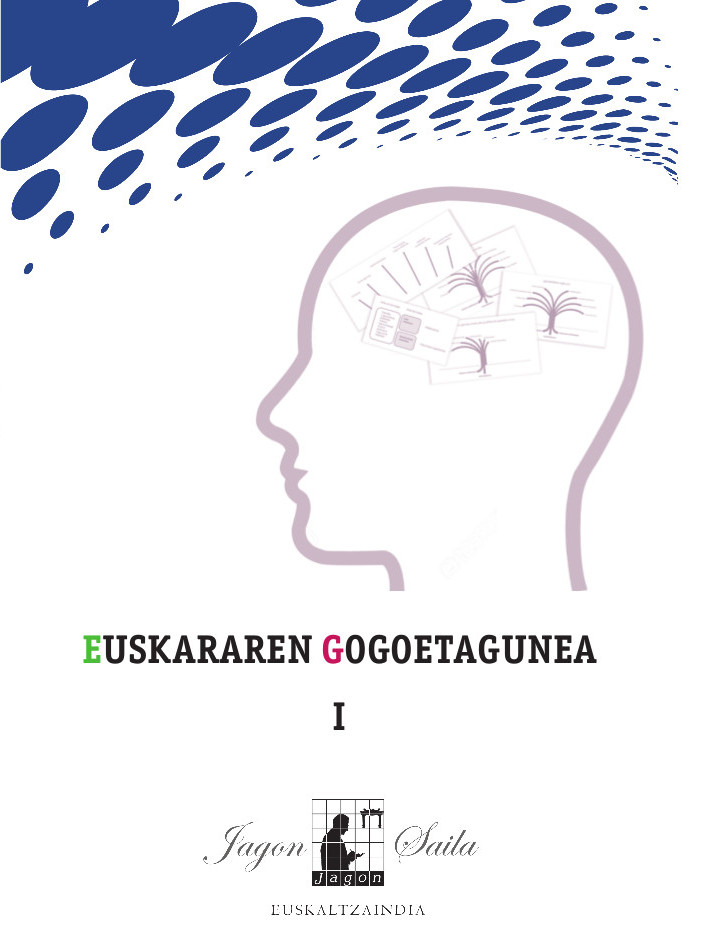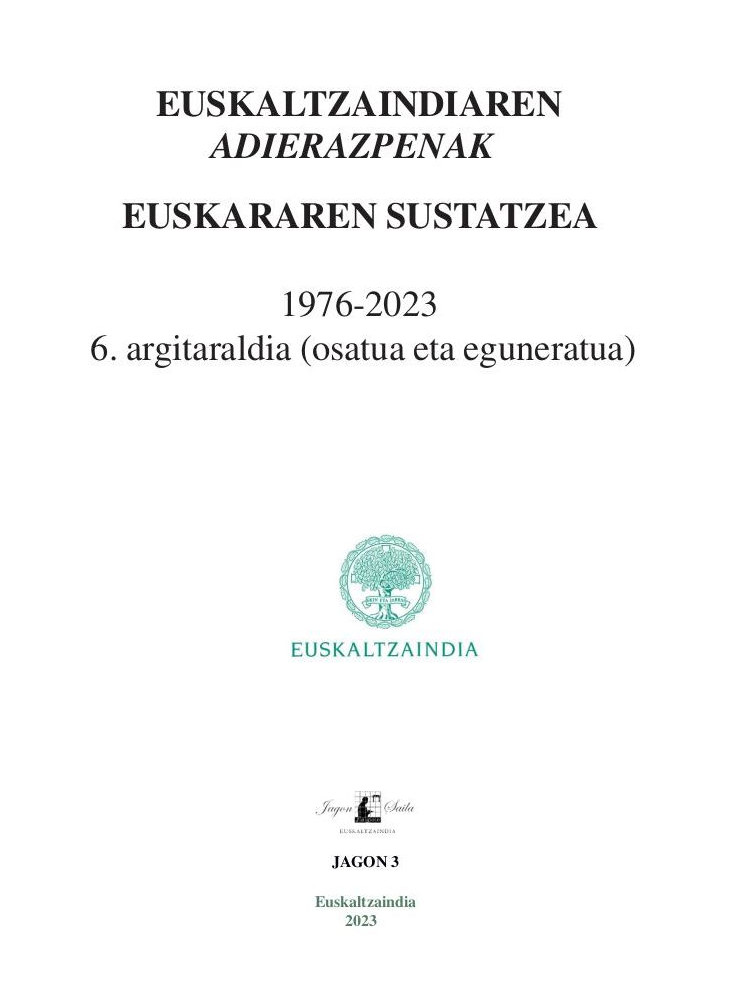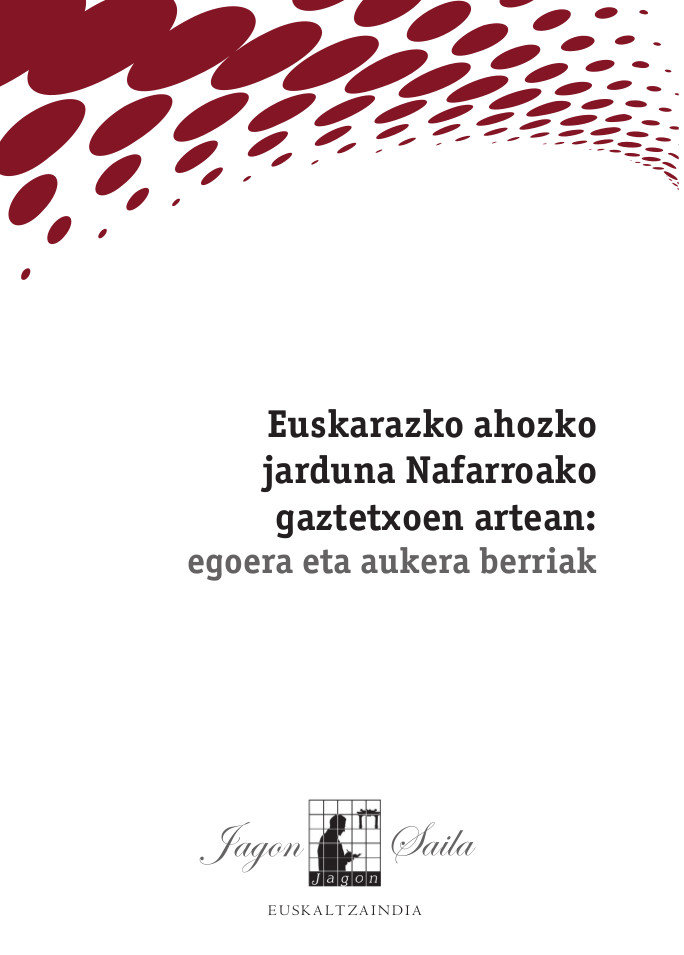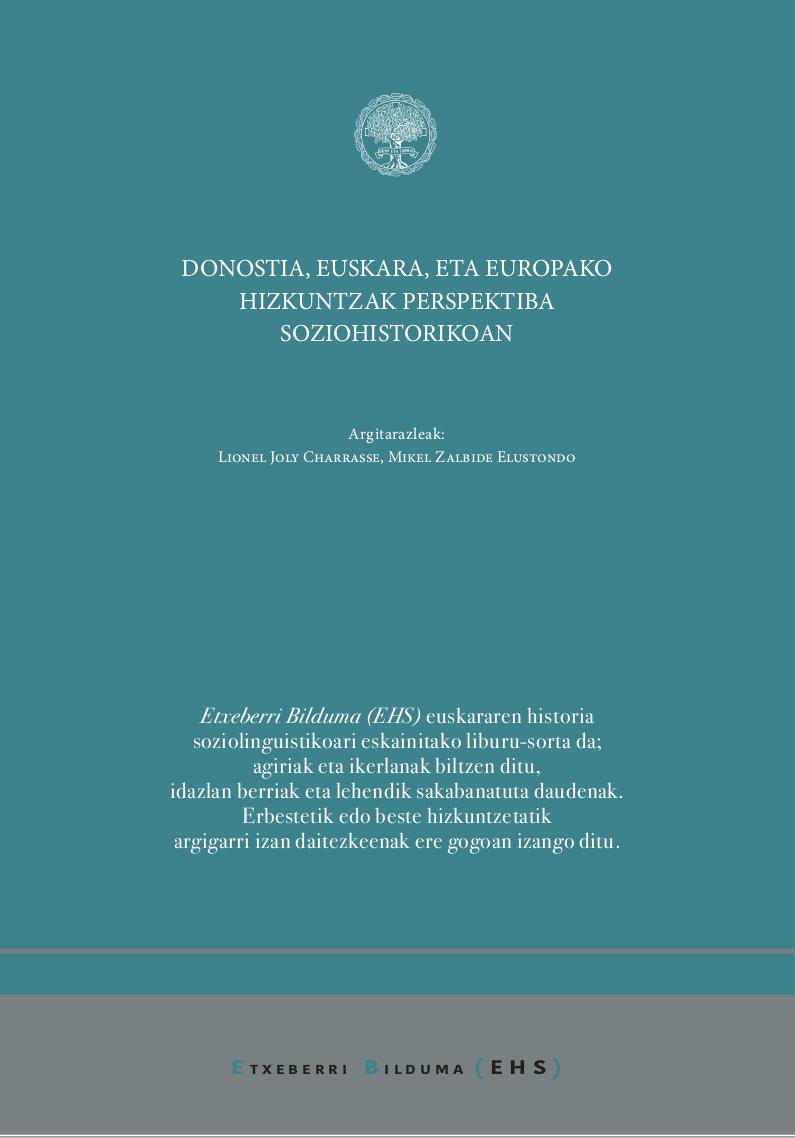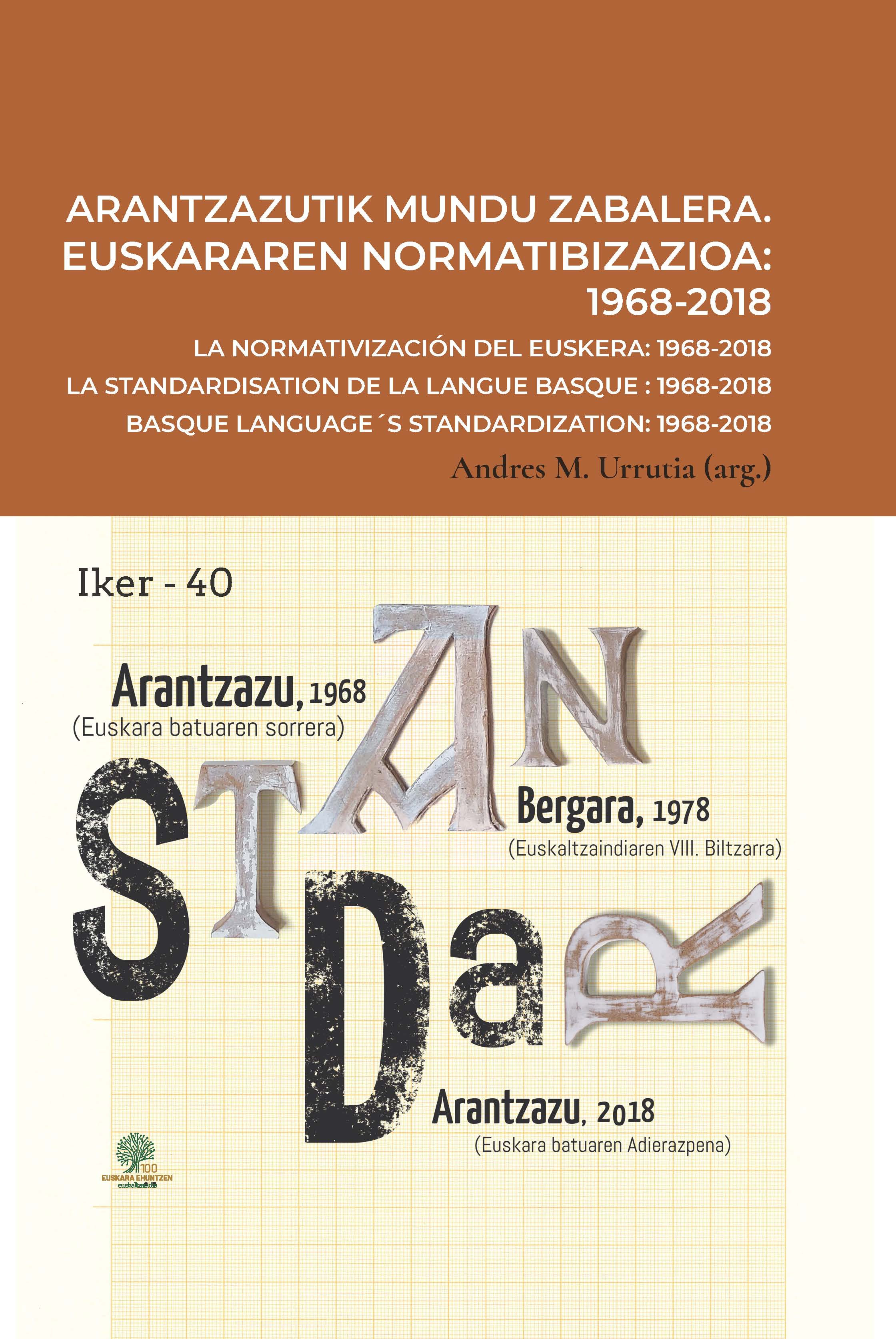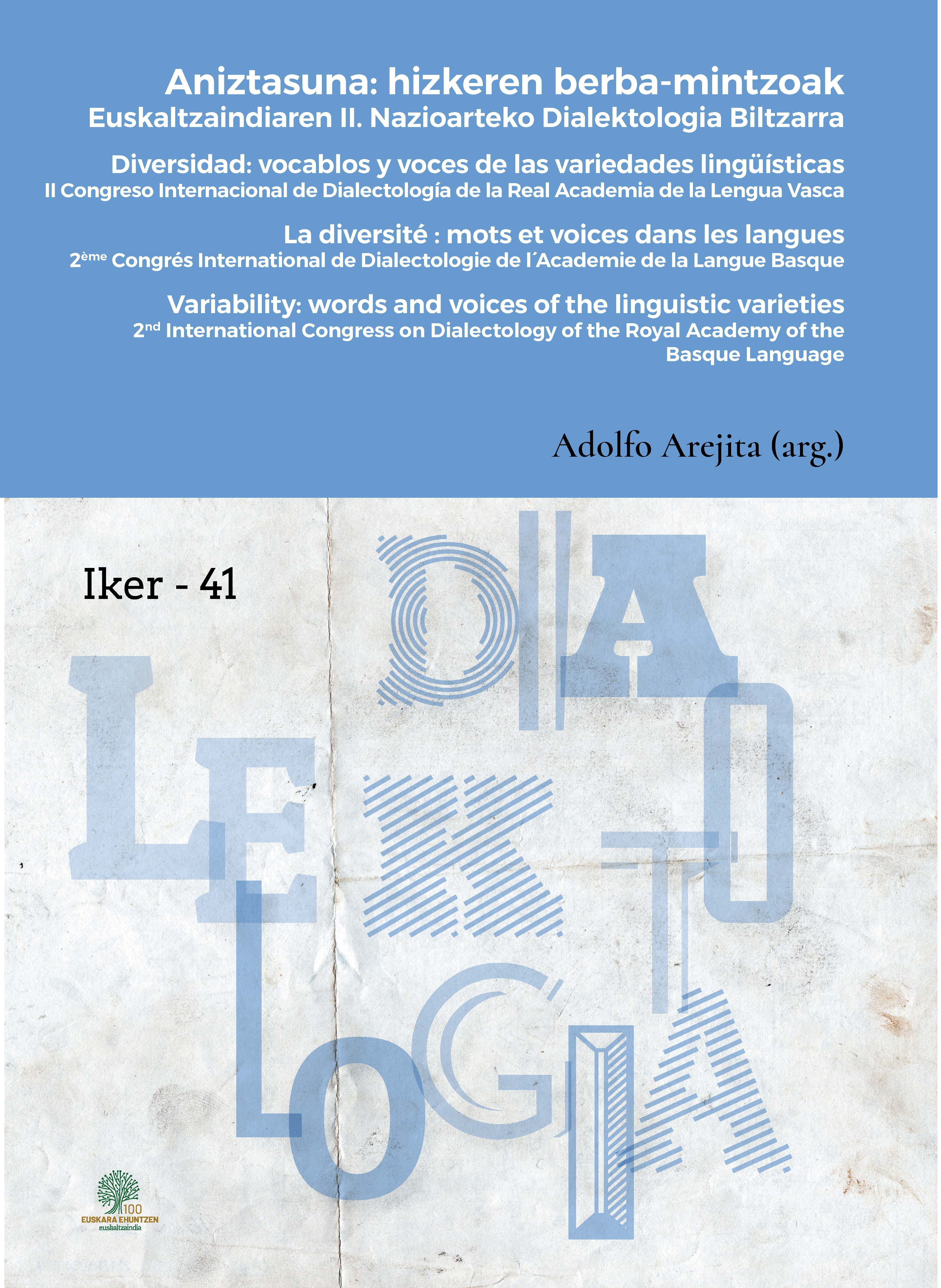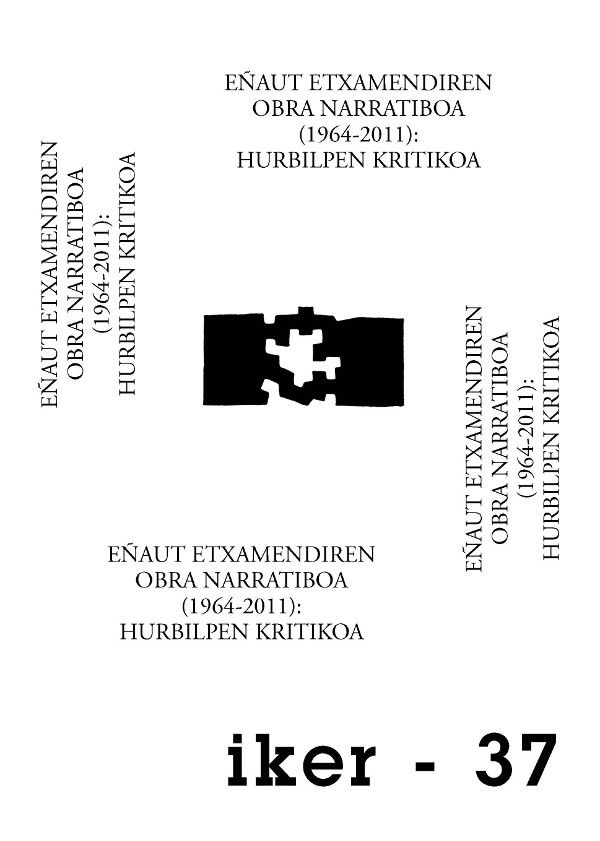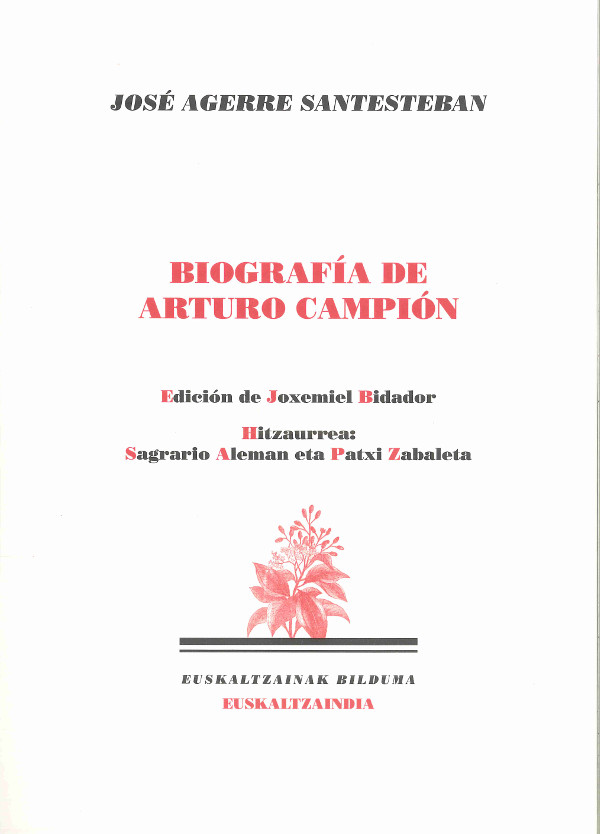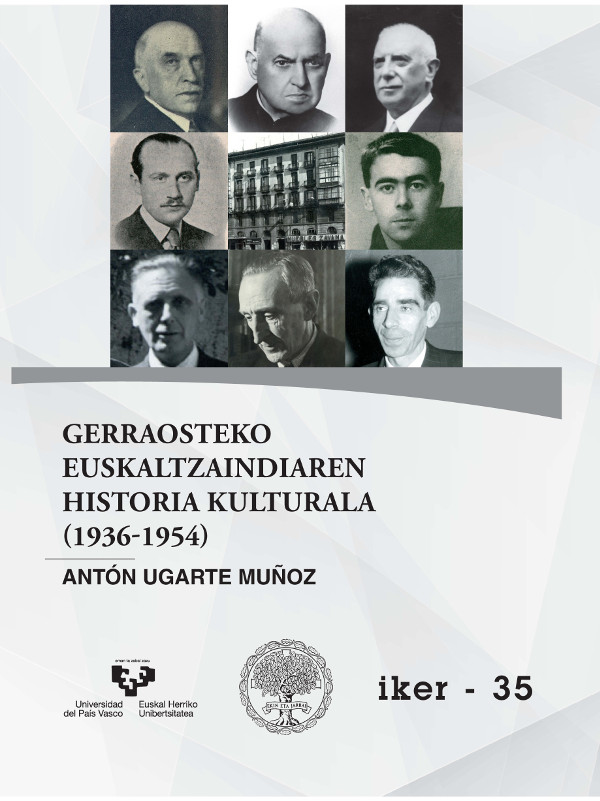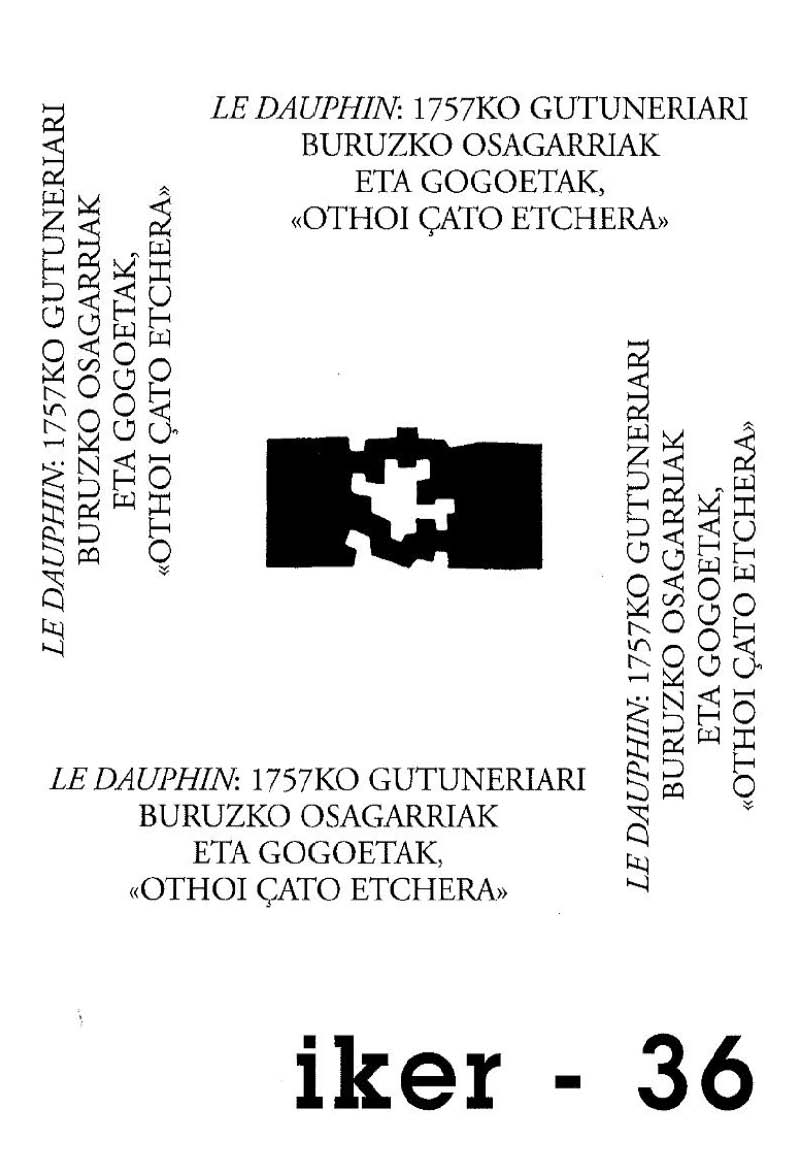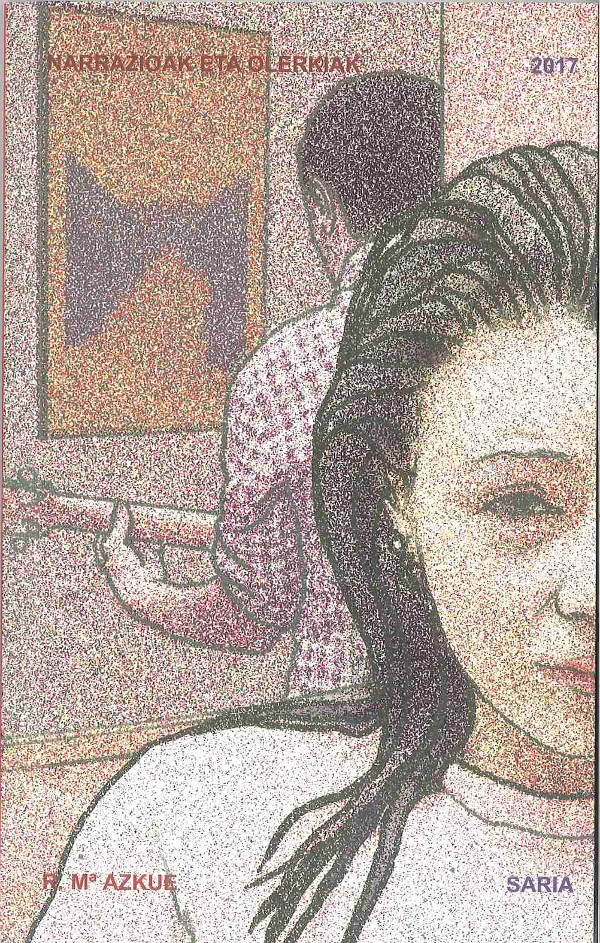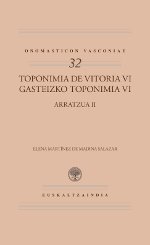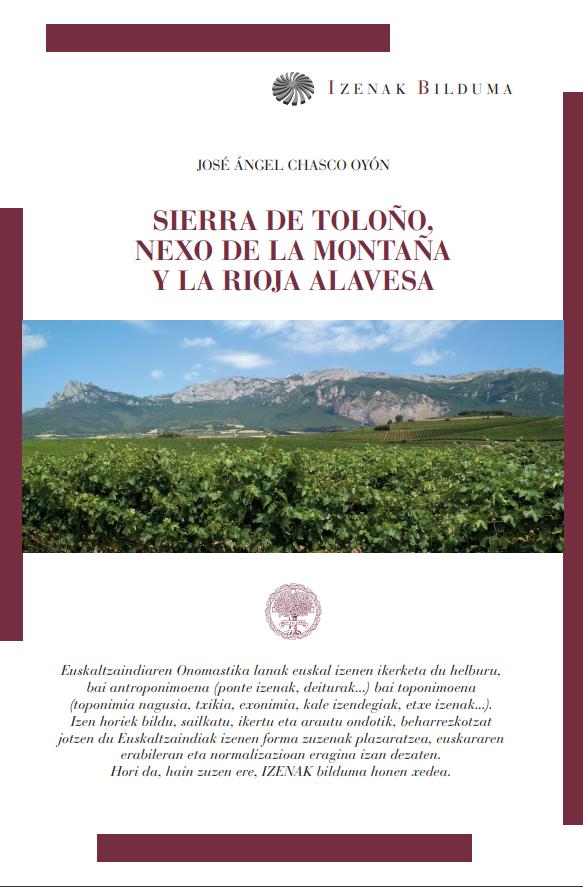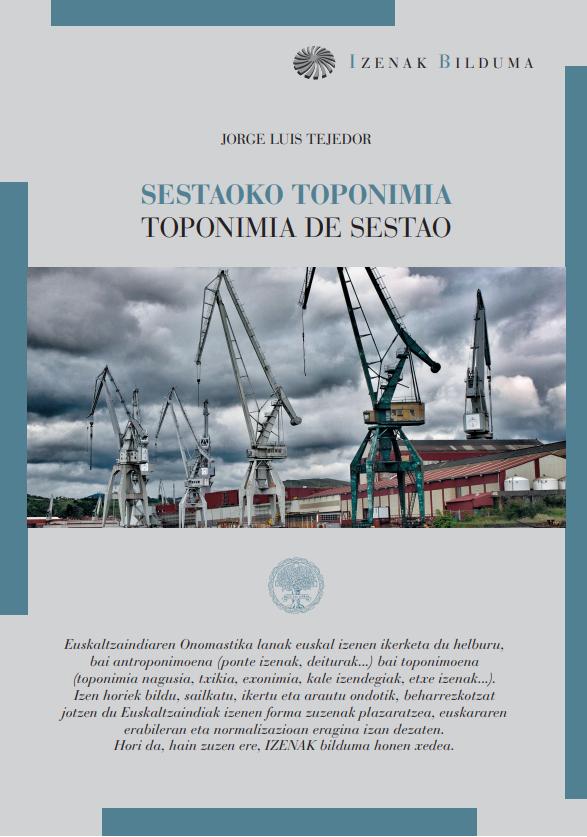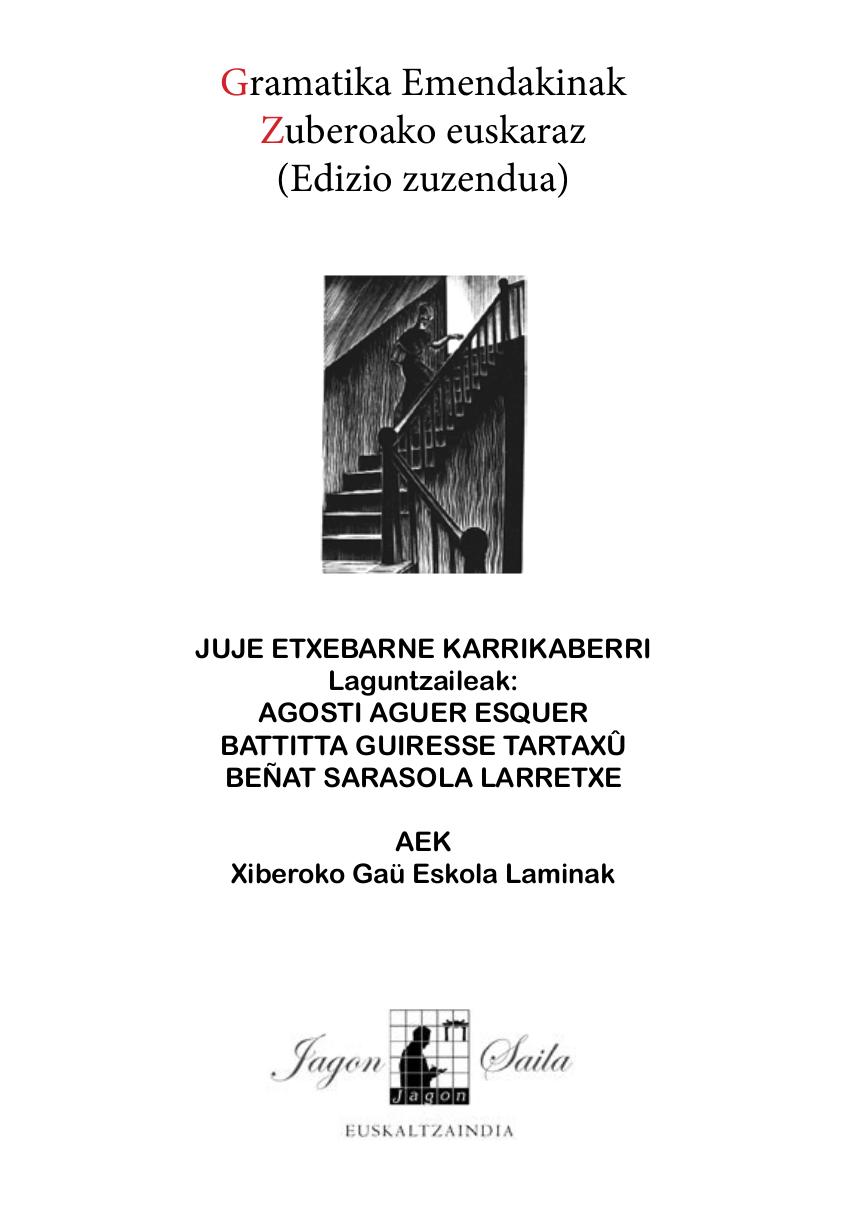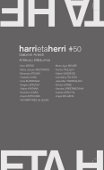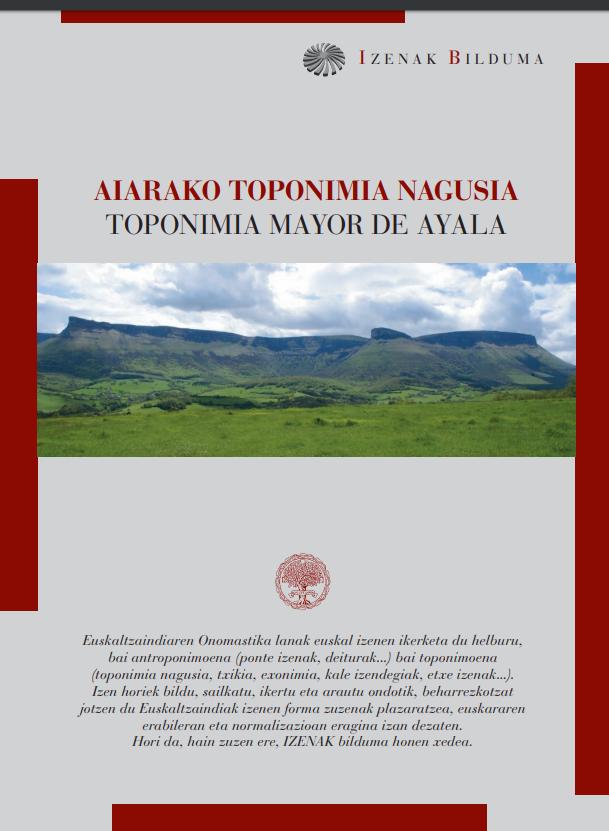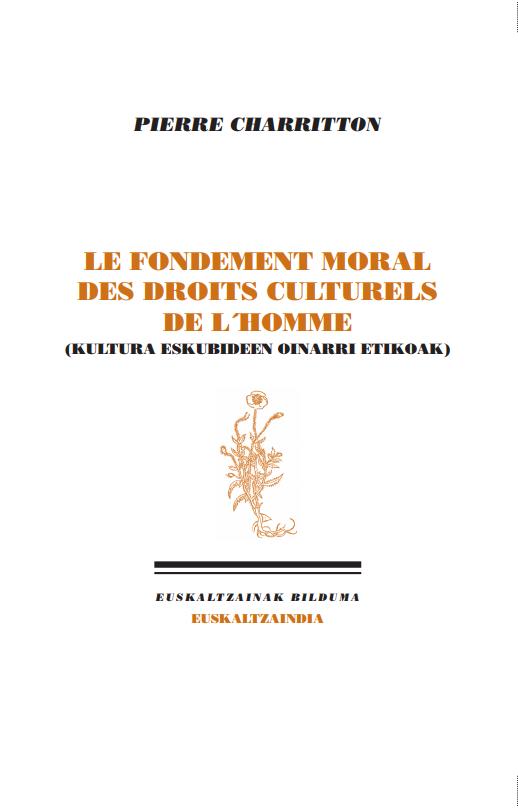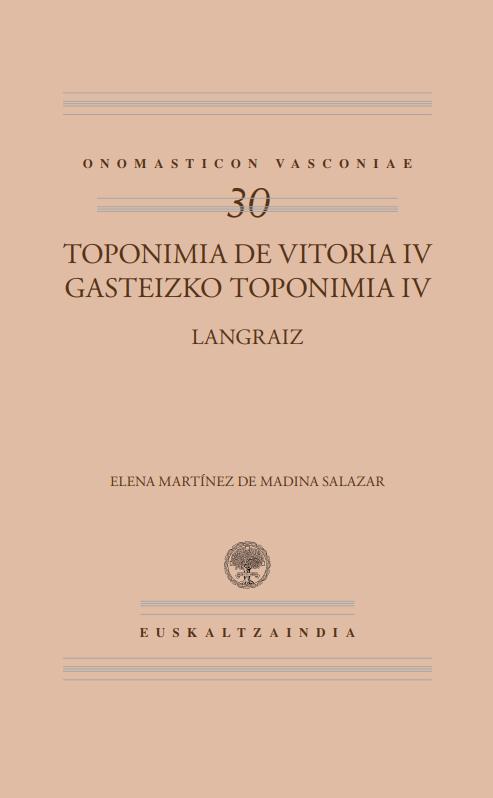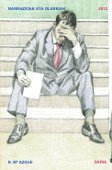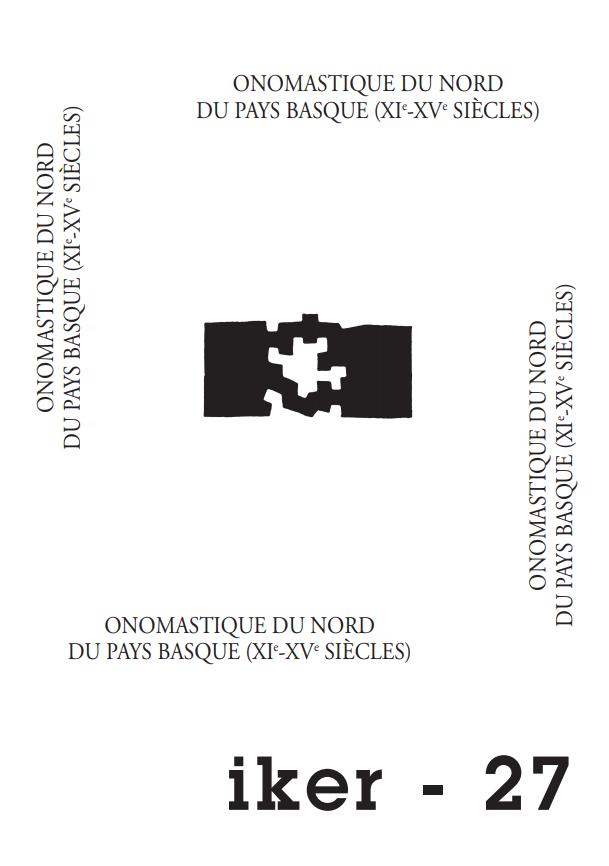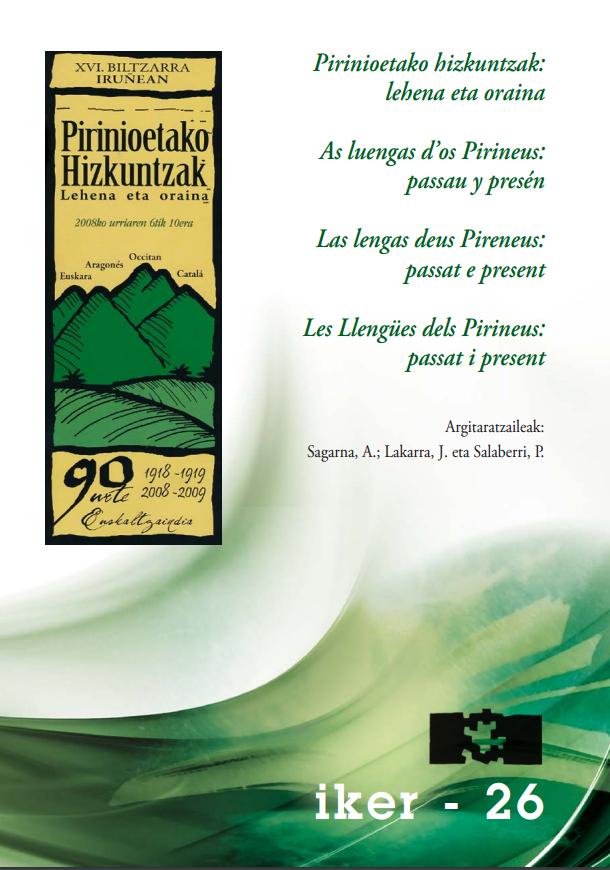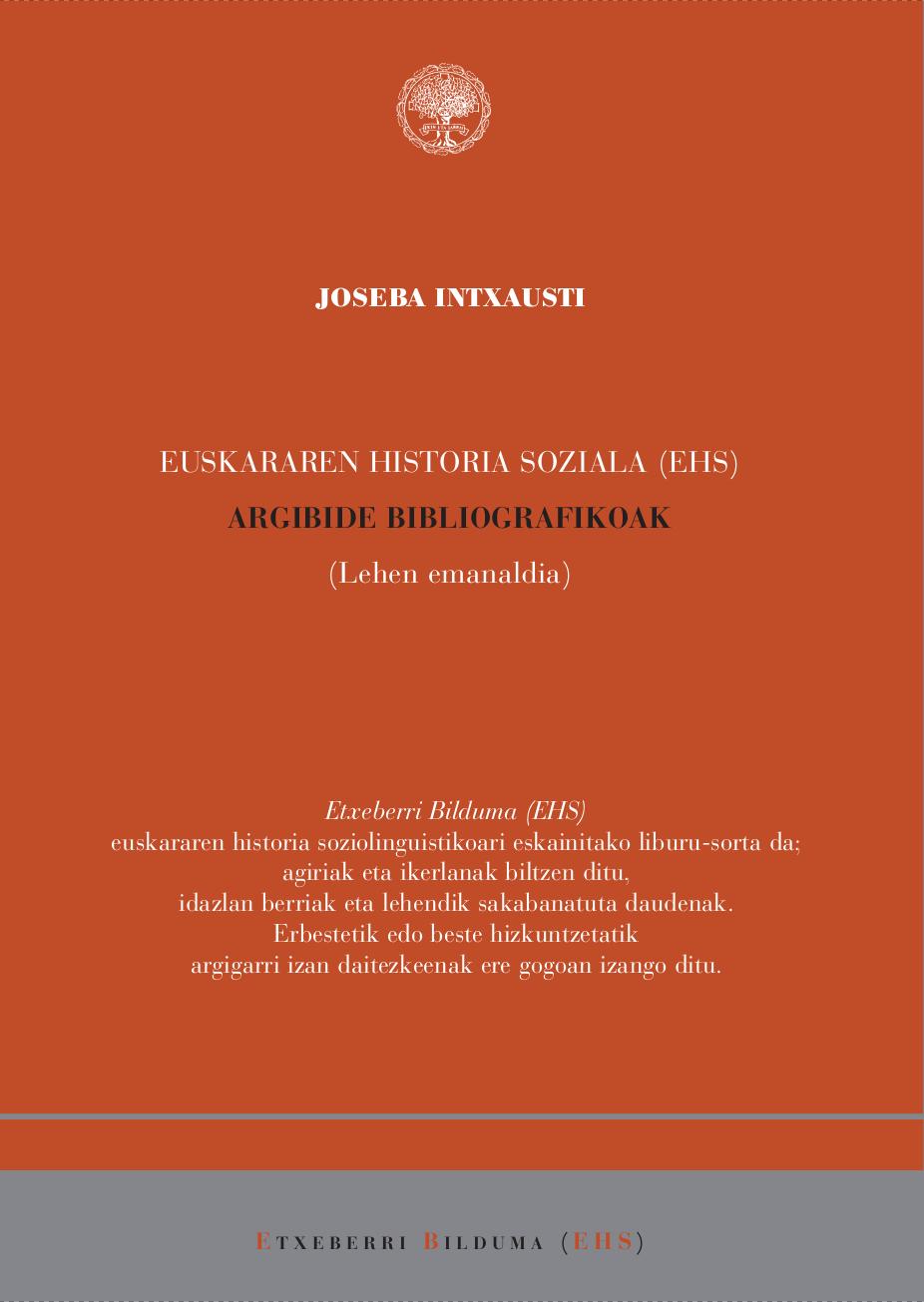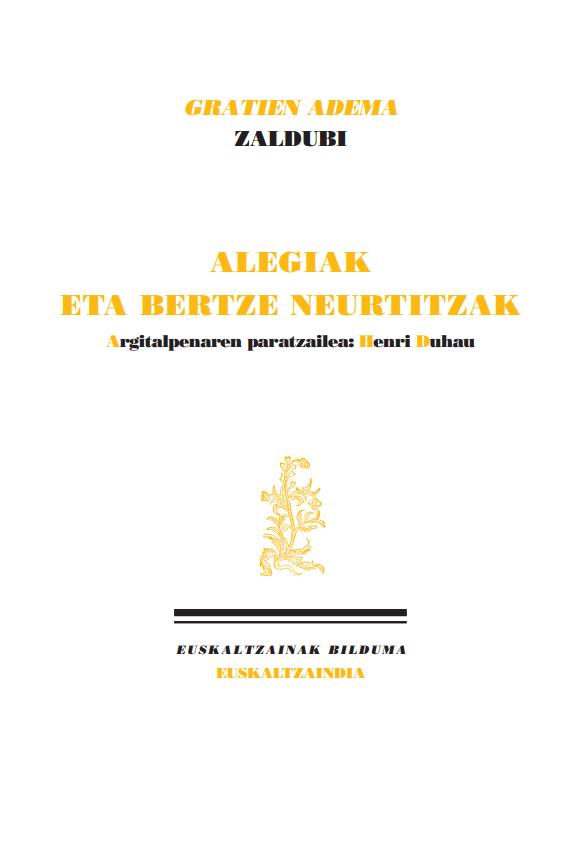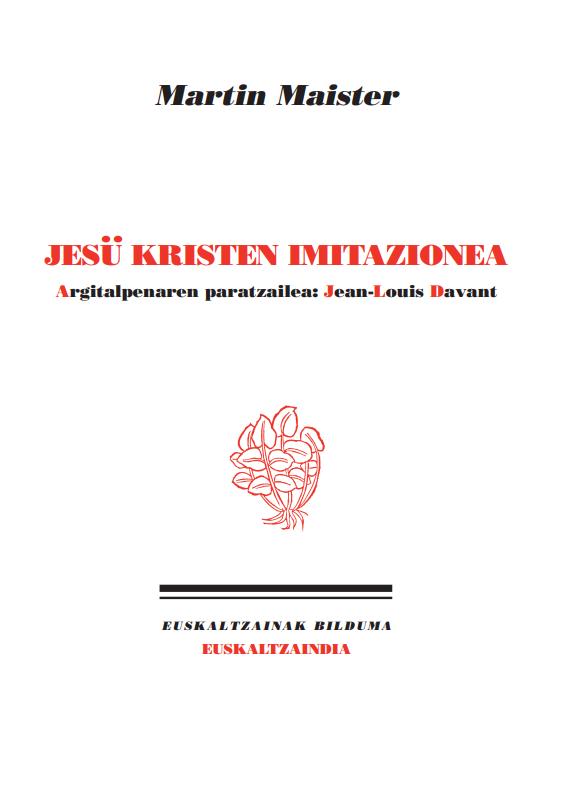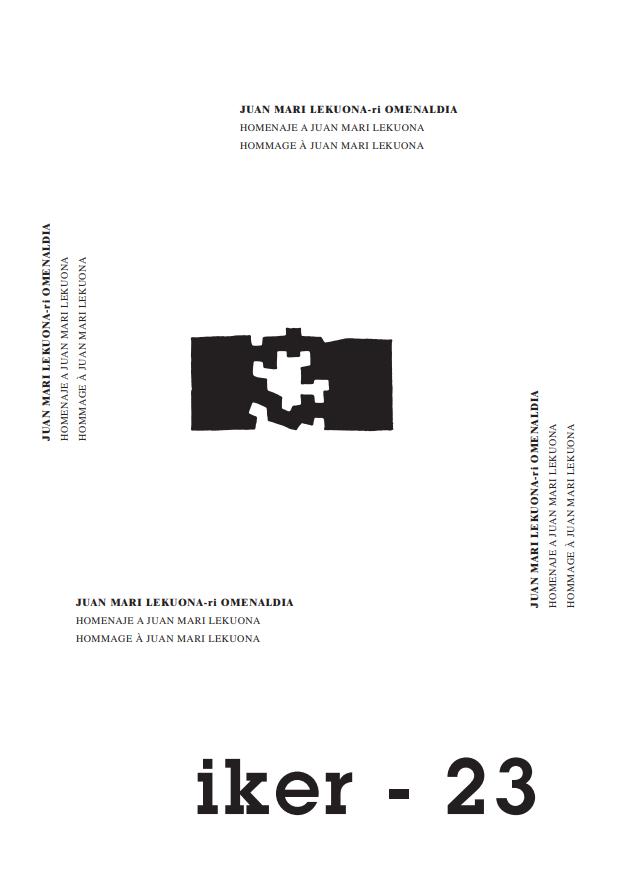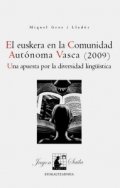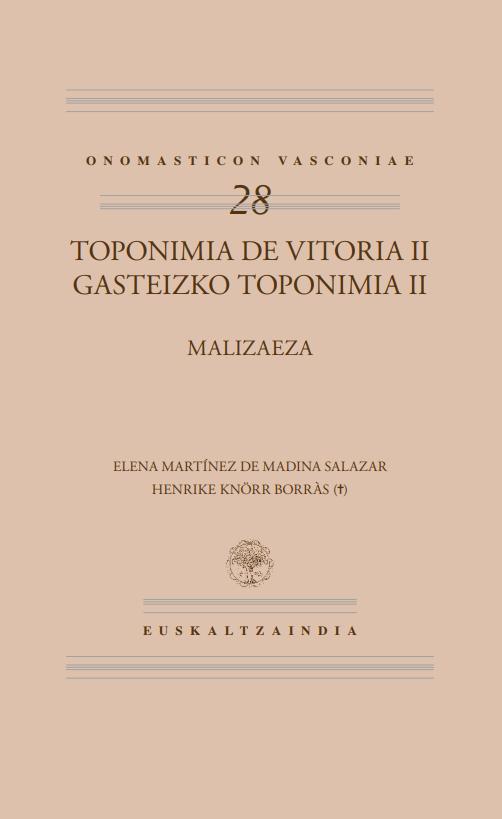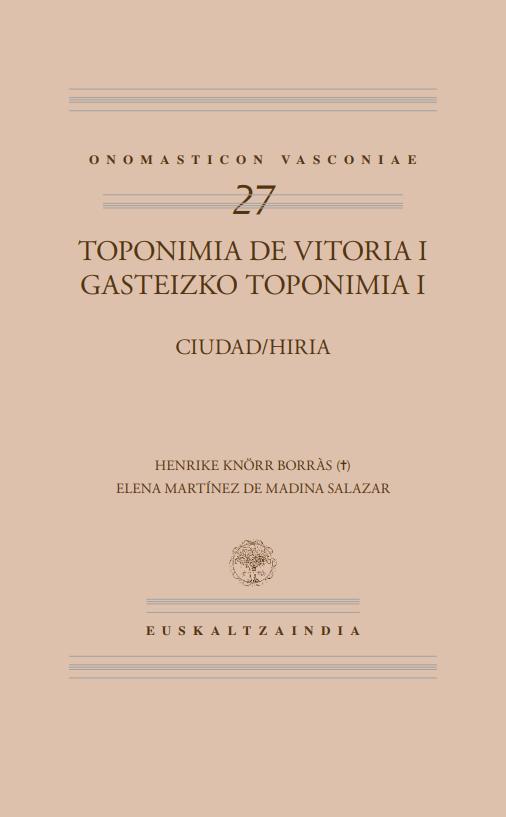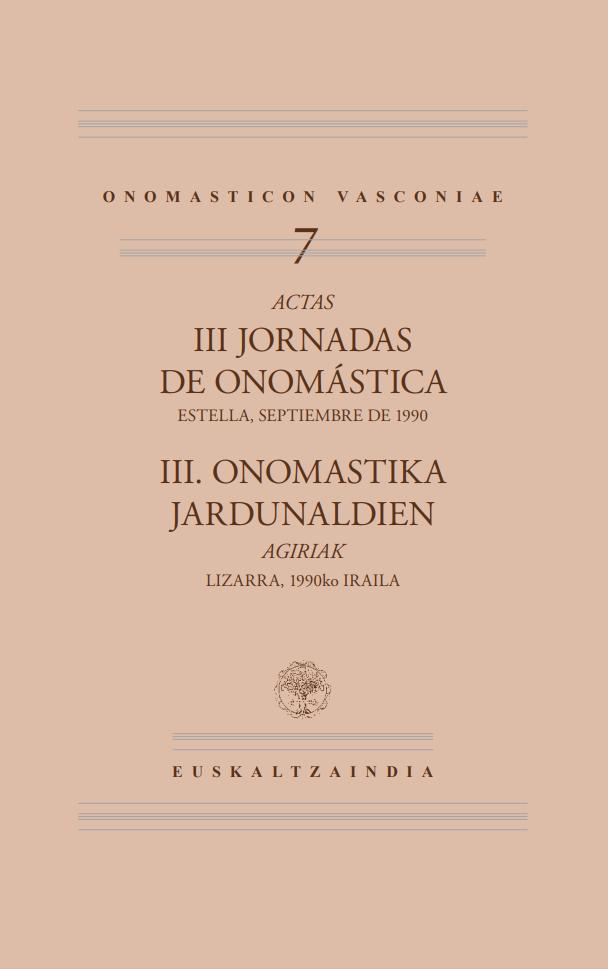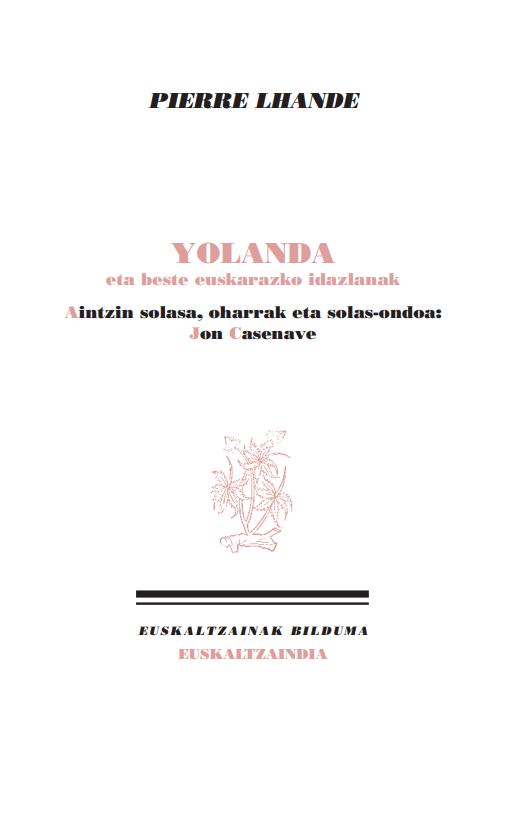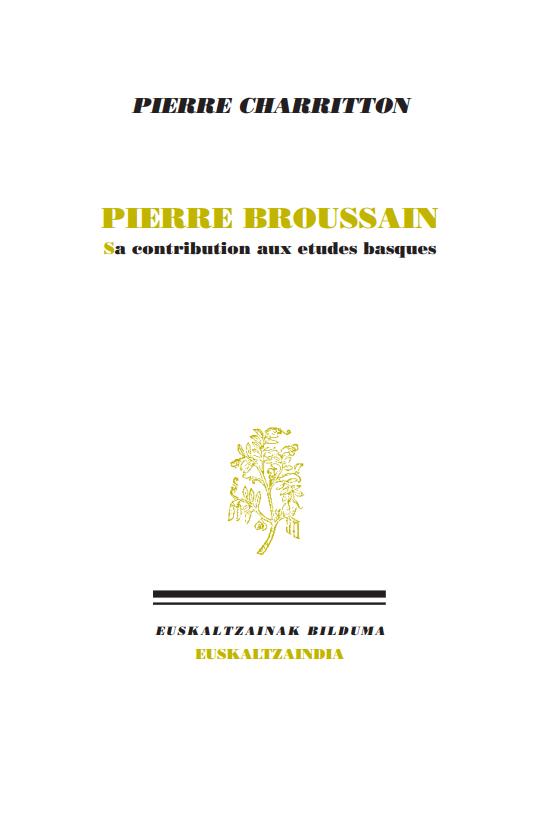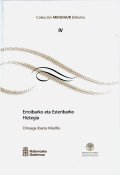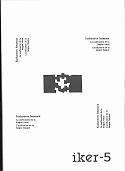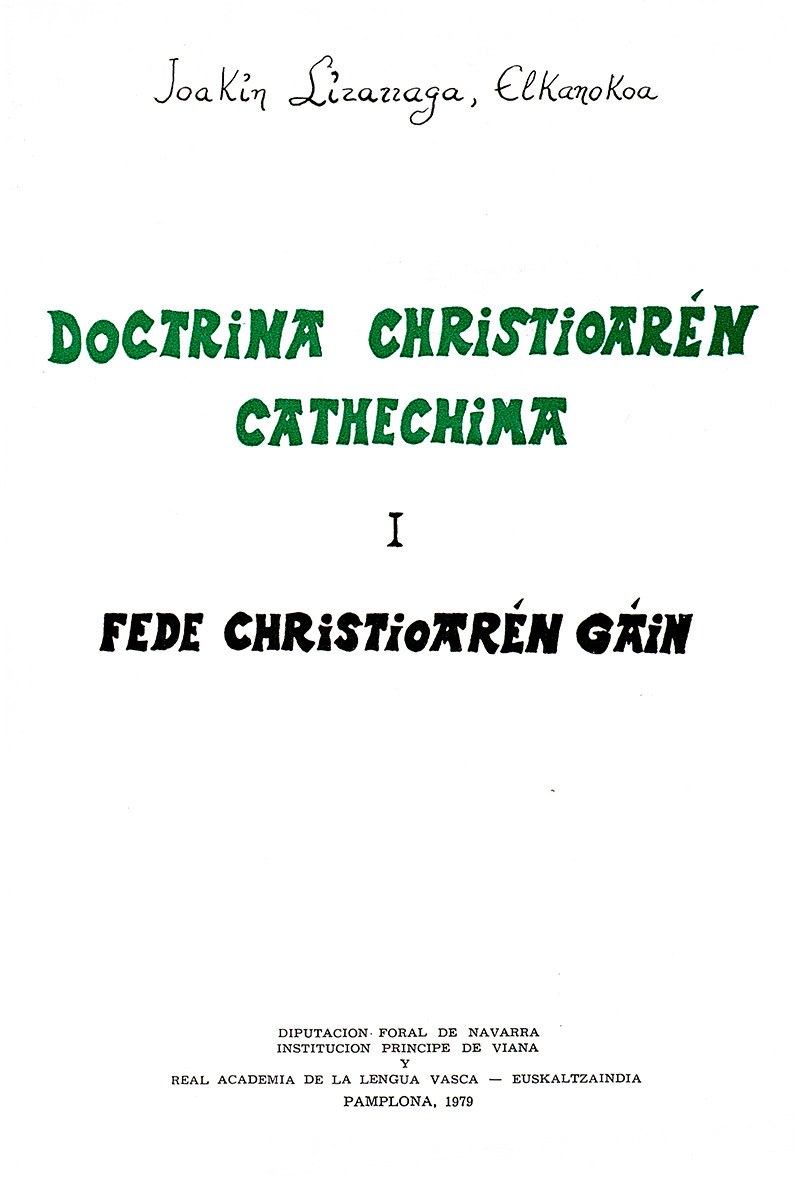Publications
Search - Publications
318 publications for the search
Euskararen Gogoetagunea I
Synopsis
Euskaltzaindia is collectively carrying out a systematic work to reorient the policies for the promotion of the Basque language. Among the different branches of this work, this report that we present here has been made with the intention of being the basis of the process.
- Author: Koordinatzailea: Jon Sarasua Maritxalar
- Collection: Jagon
- ISBN: 978-84-127506-8-3
- Editor: Euskaltzaindia (Laboral Kutxa eta Gipuzkoako Foru Aldundiaren babesarekin)
- Year of publication: 2024-06
- 17 x 24 cm; 92 pags.; paperback
- Language: Euskara
Junes Casenave-Harigile. Zortzi pastoral berri: lehen tomoa (Euskaltzainak 44)
Synopsis
The priest Junes Casenave-Harigile (1924-2018) wrote many pastorals. Eleven of them were represented; on the other hand, eight remained unpresented. We will publish them now, four in this first volume (pastorals of Agosti Etxekopar, Atarratze, Barkoxe and Dabid). The remaining four have been left for the second volume.
- Author: Prestatzailea: Jean-Baptiste Coyos
- Collection: Euskaltzainak
- ISBN: 978-84-127506-9-0
- Editor: Euskaltzaindia (Euskararen Erakunde Publikoaren babesarekin)
- Year of publication: 2024-03
- 17 x 24 cm; 236 pags.; paperback
- Language: Euskara
Narrazioak eta olerkiak 2022
Synopsis
Narrations and poems by young writers who have been awarded the Resurrección María Azkue children's and youth literature awards 2022.
- Author: Batzuk
- Collection: Out of collection
- ISBN: 978-84-127506-7-6
- Editor: Bilbao Bizkaia Kutxa – Euskaltzaindia
- Year of publication: 2024-03
- 12,5 x 20 cm; 87 pags.; paperback
- Language: Euskara
Euskaltzaindiaren buletina 2022
Synopsis
The review Euskera was founded in 1920 and in 100 years it has published content on the academic life of Euskaltzaindia, original research articles, book references and the like. As of 2021, Euskaltzaindiaren buletina was created with the aim of informing about the academic life of Euskaltzaindia. On the other hand, scientific content has continued to be published in the review Euskera ikerketa aldizkaria.
- Author: Euskaltzaindia
- Collection: Out of collection
- ISBN: ISSN (2952-3036)
- Editor: Euskaltzaindia
- Year of publication: 2024-02
- Digital publication (PDF)
- Language: Euskara
Hizkuntza-zuzenbidea. Testu-bilduma euskaraz. 5. argitaraldia (Prestatzailea: Gotzon Lobera)
Synopsis
In this collective work, the most important clauses regarding linguistic rights have been translated into Basque. Both in the global and European ambit or those corresponding to France and Spain.
- Author: Euskaltzaindia. Sustapen batzordea
- Collection: Jagon
- ISBN: 978-84-127506-6-9
- Editor: Euskaltzaindia
- Year of publication: 2024-02
- Electronic publication
- Language: Euskara
Euskaltzaindiaren adierazpenak (1976-2023) (sixth edition)
Synopsis
- Author: Euskaltzaindia. Sustapen batzordea
- Collection: Jagon
- ISBN: 978-84-127506-5-2
- Editor: Euskaltzaindia
- Year of publication: 2024-01
- Electronic publication
- Language: Euskara
Bonifacio Echegaray, promotor y defensor del euskera. Artículos 1927-1933 (Euskaltzainak 43)
Synopsis
The figure of Bonifacio Echegaray (Zumaia, 1878-Durango, 1956), better known the Basque-speaking regions as Don Boni, had been largely forgotten by Basque intellectuals until in late 2021 a group of writers and scholars felt it was time to recover the principal works of this Basque lawyer. This book collects the articles written by Echegaray between 1927 and 1933 in the different periodicals that made up the Basque press at the time. Like any compilation of journalistic pieces, this shows a moment in time and helps to understand many issues that affect us today, determining the lines of work and the political agenda in the Basque Country. In short, Echegaray proposes a unity of action for the Basque language, apart from party policies but the object of an effective policy that would today be described as language policy with positive outcomes for Basque.
- Author: Lázaro Echegaray eta Koldo Somokueto (Arg.)
- Collection: Euskaltzainak
- ISBN: 978-84-127506-4-5
- Editor: Euskaltzaindia
- Year of publication: 2023-12
- 17 x 24 cm; 472 pags.; paperback
- Language: Castellano
Euskarazko ahozko jarduna Nafarroako gaztetxoen artean: egoera eta aukera berriak (Jagon 24)
Synopsis
This book goes beyond the use of Basque among young people in Navarre, because the problem is very similar in other provinces. The thoughts and opinions of experts working from very different perspectives and starting points are provided. Some of these experts report on the proposals and projects they are working on; others consider the importance of orality in normalising the use of Basque; teachers discuss how they deal with this aspect in the classroom, what approaches they use and what initiatives are being taken outside school, for children who have learnt Basque at school to have a Basque-speaking network outside school.
- Author: Prestatzailea: Sagrario Aleman
- Collection: Jagon
- ISBN: 978-84-127506-3-8
- Editor: Iruñeko Komunikabideak Fundazioa – Euskaltzaindia
- Year of publication: 2023-12
- 17 x 24 cm; 104 pags.; paperback
- Language: Euskara
Ignazio Bergara goizuetarraren gutunak. Arranbide (Arano) eta Elama (Artikutza). 1787-1811. Edizioa eta Hizkuntza Azterketa (Iker 48)
Synopsis
In this book the authors follow the structure used in the publication on J.R. Minondo (IKER 42). The First volume, entitled "Edición" ("Editing") studies all the aspects to be found in his texts, such as I. Bergara's way of writing, letters, compound words and specific terms, punctuation, abbreviations and so on, but aimed at today's reader, transcriptions of these texts with some exceptions and difficulties, with an effort made to adapt them to modern spelling. Those interested also have the option of reading the unmodified originals on the USB card included with this volume.
In the second volume, entitled "Hizkuntzen azterketa", while the authors have followed the same order and sequence as in the previous publication of 2021, this edition is more complete thanks to some additions. One of these is a comparison between the writing of J.R. Minondo and I. Bergara, in terms of both similarities and those areas where they work differently, such as causality, verbs, conjugation, word order and, in particular, the differences in the lexis used by the two authors.
- Author: Prestatzaileak: Patxi Salaberri Zaratiegi; Juan Jose Zubiri Luxanbio; Iker Salaberri Izko
- Collection: Iker
- ISBN: 978-84-126313-7-1
- Editor: Euskaltzaindia (Nafarroako Gobernuaren laguntzarekin)
- Year of publication: 2023-12
- 16 x 23 cm; two books: Edizioa (456 pags. + USB ) and Hizkuntza azterketa (324 pags.); paperback
- Language: Euskara – Gaztelania
Lizardi. Bihotz-begietan eta gainerako olerkiak (euskara batura hurbilduak) (Euskaltzainak 41)
Synopsis
All Lizardi's poems are written in standard Basque or, to be more precise, as close as possible to the unified written Basque model. One of the primary aims of this adaptation, certainly the most important, is to offer Lizardi's poems in a more familiar, modern version to readers used to and trained in standard Basque. It does this by adapting writing that might appear unusual or unfamiliar to such readers, in order to minimise the obstacles to immersing themselves in the content of the poems.
- Author: Karlos Otegi (Arg.)
- Collection: Euskaltzainak
- ISBN: 978-84-127506-0-7
- Editor: Euskaltzaindia
- Year of publication: 2023-12
- 17 x 24 cm; 344 pags.; paperback
- Language: Euskara
Margarita, Nafarroako erregina (1492-1549) (Euskaltzainak 42)
Synopsis
Margaret, a member of the French house of Valois, holds a special place in the history of Navarre, as she married king Henry II of Navarre. At European level, Margaret had particular responsibility for relations between kingdoms, at the service of her brother Francis I. Not only did she devote herself to politics, she also had a special passion for literature and left a notable body of work in the 16th century, which today is a point of reference for the creative literature of the 20th and 21st centuries. Theatre was an art she fostered at her court and beyond, and she wrote plays in a range of styles. She was active in a very broad area of politics and letters, as well as being the mother of Jeanne d'Albret, queen of Navarre, and grandmother of Henry III of Navarre, who also became king of France.
- Author: Ixabel Etxeberria
- Collection: Euskaltzainak
- ISBN: 978-84-126313-4-0
- Editor: Euskaltzaindia
- Year of publication: 2023-12
- 17 x 24 cm; 246 pags.; paperback
- Language: Euskara
Creación, traducción, autotraducción (Iker 46)
Synopsis
This collective volume brings together texts by specialists of international standing to give an innovative view of writing and (self-)translation. Research in this field is particularly relevant in the context of Spain, where many authors, including the most highly-respected, like Bernardo Atxaga, the writer in Basque and Spanish who also contributed to this volume, are bilingual, and often self-translate. Gathered together to mark the centenary of the Royal Academy of the Basque Language, Euskaltzaindia, these pioneering studies in Spanish shed a new light on the creative process, which is hard to discern in published works but which can be detected through the original manuscripts.
- Author: Editoreak: Olga Anokhina - Aurelia Arcocha
- Collection: Iker
- ISBN: 978-84-126313-3-3
- Editor: Iberoamericana Vervuert - Euskaltzaindia
- Year of publication: 2023-11
- 17 x 24 cm; 274 pags.; hardback
- Language: Gaztelania / Castellano
Euskara Nafarroako hezkuntzan: egoera eta aukera berriak
Synopsis
It is of strategic importance in schools, in education, to run projects among increasingly multilingual students. This book sets out to analyse the status of Basque in education in Navarre. How multilingualism is managed now in schools and how this should be done in the future, what new challenges and opportunities face Basque in and out of the classroom, and what projects are being run in the classroom and in extracurricular activities.
- Author: Prestatzailea: Sagrario Aleman
- Collection: Jagon
- ISBN: 978-84-127506-1-4
- Editor: Euskaltzaindia (Nafarroako Gobernuaren babesarekin)
- Year of publication: 2023-10
- 17 x 24 cm; 92 pags.; digital edition
- Language: Euskara
Hizkuntza-zuzenbidea. Testu-bilduma euskaraz. 4. argitaraldia (Prestatzailea: Gotzon Lobera)
Synopsis
In this collective work, the most important clauses regarding linguistic rights have been translated into Basque. Both in the global and European ambit or those corresponding to France and Spain.
- Author: Euskaltzaindia. Sustapen batzordea
- Collection: Jagon
- ISBN: 978-84-127506-3-8
- Editor: Euskaltzaindia
- Year of publication: 2023-10
- Electronic publication
- Language: Euskara
Euskara Batuaren Eskuliburua. A-tik Z-ra, zalantzak eta argibideak
Synopsis
Euskera Batuaren Eskuliburua does not include new rules. Euskaltzaindia sets out to reformulate the rules, recommendations, approvals and rulings (and also, of course, incorrect options) in standard Basque in an accessible, educational way. To this end, it deals with questions in seven areas: lexis, calculation, morphology, syntax, onomastics, pronunciation and typographical syntax.
- Author: Euskaltzaindia
- Collection: Out of collection
- ISBN: 978-84-948489-4-0
- Editor: Euskaltzaindia
- Year of publication: 2023-08
- 15 x 21,5 cm; 556 pags.
- Language: Euskara
Donostia, euskara, eta Europako hizkuntzak perspektiba soziohistorikoan
Synopsis
This book presents several pieces of work with the intention of exploring the sociolinguistic evolution of Donostia/San Sebastian. First, Lionel Joly Charrasse outlines the methodological model for studying the social history of languages, in particular the social history of Basque. The second chapter of the book sets out to highlight the main languages in Donostia/San Sebastian in the course of its history. In the third, Juan Madariaga Orbea, on the basis of his extensive research into the subject, describes the position of Basque in the city in the 19th century. Next, Koldo Larrañaga Elorza, after exhaustive research, presents the opinion, and above all the practice, of members of the Royal Basque Society of the Friends of the Country, the social élites of Gipuzkoa province, with regard to Basque. Then in chapter five, Olatz Altuna Zumeta and Maialen Iñarra Arregi report on the position of Basque at the beginning of the 21st century. In the final chapter, on the basis of the methodological model mentioned above, Mikel Zalbide Elustondo and Lionel Joly Charrasse explore the sociolinguistic evolution of Donostia over the last 250 years. All these pieces of work provide an overview of the sociolinguistic evolution of Donostia/San Sebastián, from both synchronic and diachronic points of view.
- Author: Argitarazleak: Mikel Zalbide Elustondo - Lionel Joly Charrasse
- Collection: Etxeberri (EHS)
- ISBN: 978-84-126313-2-6
- Editor: Euskaltzaindia
- Year of publication: 2023-07
- Language: Euskara
Towards a methodological model for a social history of languages: a Basque contribution
Synopsis
It is a methodology book; This is mainly based on the theories of linguistic sociology and sociolinguistics. It has been specially prepared to study the history of the social dimension of languages
- Author: Mikel Zalbide – Lionel Joly
- Collection: Etxeberri (EHS)
- ISBN: 978-84-125463-2-3
- Editor: Euskaltzaindia
- Year of publication: 2023-02
- 505 pags. (PDF)
- Language: Ingelesa
Euskaltzaindiaren buletina 2021
Synopsis
The review Euskera was founded in 1920 and in 100 years it has published content on the academic life of Euskaltzaindia, original research articles, book references and the like. As of 2021, Euskaltzaindiaren buletina was created with the aim of informing about the academic life of Euskaltzaindia. On the other hand, scientific content has continued to be published in the review Euskera ikerketa aldizkaria.
- Author: Euskaltzaindia
- Collection: Out of collection
- ISBN: ISSN (2952-3036)
- Editor: Euskaltzaindia
- Year of publication: 2023-01
- Digital publication (PDF)
- Language: Euskara
Ingurune digitala, hizkuntzen estandarizazioa eta euskara
Synopsis
We are well into the 21st Century and the digital environment is, without a doubt, part of our lives by now. Artificial intelligence, and language technologies in particular, have entered our everyday, and the Basque language is no exception here. How can the digital environment help revitalize the standardization of Basque? With this main objective in mind, we set out to learn about the experiences of other languages, that of Euskaltzaindia itself, and that of Basque institutions. The aim was to firstly move forward in the formulation, evaluation and circulation of Basque’s standardization in the 21st Century.
- Author: Editoreak: Andoni Sagarna eta Miriam Urkia
- Collection: Iker
- ISBN: 978-84-125463-5-4
- Editor: Iberoamericana Vervuert – Euskaltzaindia
- Year of publication: 2022-12
- 17 x 24 cm; 296 pags.; paperback
- Language: Frantsesa - Euskara – Gaztelania – Ingelesa
Faktoriako Geziak: Egungo gizarte-kontzeptu berriak euskaraz nola eman: hautuak eta arrazoiak
Synopsis
The media face an urgent daily challenge: how to express in Basque the new concepts and expressions being developed in Spanish, English and other languages. The answer is always arrived at with hindsight, but it is always worth thinking about finding loan-words in Basque or loan options to fit these concepts. This is just what academy member Adolfo Arejita did in the work he carried out from 2019 to 2022 on the Euskadi Irratia "Faktoria" programme.
- Author: Adolfo Arejita
- Collection: Euskaltzainak
- ISBN: 978-84-126313-1-9
- Editor: Euskal Irrati Telebista – Euskaltzaindia
- Year of publication: 2022-12
- 17 x 24 cm; 174 pags.; paperback
- Language: Euskara
Narrazioak eta olerkiak 2021
Synopsis
- Author: Batzuk
- Collection: Out of collection
- ISBN: 978-84-126313-0-2
- Editor: Bilbao Bizkaia Kutxa – Euskaltzaindia
- Year of publication: 2022-12
- 12,5 x 20 cm; 80 pags.; paperback
- Language: Euskara
Euskal Herriko Antzinaroko jainko eta jainkosen izenak
Synopsis
Most of the linguistic traces of the Basque heritage of antiquity so far found in the area marked by the rivers Adour, Aragón, Ebro and Barbadun are names of gods and goddesses. Up to now a total of seventeen inscriptions have been described, yielding nine such theonyms. Compared to all the evidence that exists in the Hautes-Pyrénées and Haute-Garonne regions, this small series is insignificant; however, as examples of proper names of people are even rarer, clearly theonyms are the primary source of research into the early Basque language.
The aim of this piece is to describe the proto-Basque language of antiquity by analysing the names of local gods and goddesses, while attempting to determine as far as possible the territory covered by ancient Vasconia.
- Author: Luis Mari Zaldua
- Collection: Izenak
- ISBN: 978-84-125463-9-2
- Editor: Euskaltzaindia
- Year of publication: 2022-12
- 17 x 24 cm; 196 pags.; paperback
- Language: Euskara
Mendebaleko euskara zaharra: ezaugarriak, kronologia eta geografia
Synopsis
This work belongs to the field of historical dialectology and examines Eastern Old Basque. Specifically, it goes into the main features and divisions that existed in the eastern part of the Basque Country in the middle ages, taking into account studies by Joseba Lakarra, and the language unit referred to as Eastern Old Basque./p>
- Author: Eneko Zuloaga
- Collection: Iker
- ISBN: 978-84-125463-6-1
- Editor: Euskal Herriko Unibertsitatea – Euskaltzaindia
- Year of publication: 2022-12
- 16 x 23 cm; 358 pags.; paperback
- Language: Euskara
Toponimia de Vitoria VIII – Gasteizko Toponimia VIII: Dibiña I
Synopsis
This work is the result of the research project being conducted by Euskaltzaindia into the historical toponymy of Vitoria-Gasteiz, including its 64 localities. Following publication of the work on Malizaeza, Ubarrundia, Langraiz and Arratzua, it is now the turn of Dibiña, which is to be presented in two volumes. This book, Dibiña I, corresponds to the first part of the study of this merindad, and contains the toponymy of Abetxuku / Abechuco, Andetxa / Antezana, Arangiz, Foronda, Lopida / Lopidana, Mendiguren and Ihurre.
The Academy's database for this project contains nearly 400,000 toponymic records. The toponymy research in Dibiña I worked with a corpus of 27,000 records, and this volume presents about 10,200 documentary samples and 1,106 toponymic entries, ordered, classified and with the pertinent observations.
- Author: Elena Martínez de Madina Salazar
- Collection: Onomasticon Vasconiae
- ISBN: 978-84-124296-9-5
- Editor: Euskaltzaindia (Gasteizko Udalaren babesarekin)
- Year of publication: 2022-11
- CD ROM
- Language: Gaztelania
Henrike Knörr (1947-2008) idazlan hautatuak. Textos escogidos.
Synopsis
The primary aim of this publication is to present a broad perspective on Henrike Knörr, at first hand, without intermediaries, by providing a representative collection of texts written by him.
- Author: Prestatzailea: Roberto González de Viñaspre
- Collection: Euskaltzainak
- ISBN: 978-84-125463-7-8
- Editor: Euskaltzaindia (Arabako Foru Aldundiaren laguntzarekin)
- Year of publication: 2022-11
- 17 x 24 cm; 404 pags.; paperback
- Language: Euskara – Gaztelania
Joakin Lizarragaren lexikoaren azterketa
Digital version available
Synopsis
This book has two parts: study and vocabulary. The analytical part compiles details of the life of Lizarraga, his work, the written sources used and a detailed linguistic and dialectological analysis of the vocabulary he used. The dictionary includes 1,509 entries based on words and variants selected from Lizarraga's book Jesu Kristo Maria eta Santuen bizitzak.
- Author: Ibai Iriarte Goñi
- Collection: Mendaur
- ISBN: 978-84-125463-0-9
- Editor: Nafarroako Gobernua – Euskaltzaindia
- Year of publication: 2022-11
- 17 x 24 cm; 474 pags.; paperback
- Language: Euskara
Territoires, Langues, Littératures & Cultures : Confrontations, Lectures, Translations
Synopsis
The purpose of this book is to pose questions about the relation between printed and manuscript texts and their setting, time, geography and more broadly with their transmission and the dominant cultures. All this in relation to small languages within the historical period running from the 14th to 21st centuries. The aim of this extensive study is not so much exhaustive, but seeks rather to point to the different literary and linguistic fields, to make it possible to venture beyond the conventions that govern the history of states. These texts are changeable and translatable, migrating to neighbouring geographies and even more distant language areas. The texts originally written in other languages are short, and in many cases translated into invisible languages to return looking different, as if loaded with spices, filled with promises to assure their fragile durability.
- Author: Editoreak: Herve Le Bihan & Aurelia Arcocha
- Collection: Iker
- ISBN: 978-84-125463-4-7
- Editor: Université de Rennes 2
- Year of publication: 2022-10
- 17 x 24 cm; 600 pags.; paperback
- Language: Frantsesa - Euskara – Gaztelania – Ingelesa
Euskara Nafarroako hezkuntzan: egoera eta aukera berriak
Synopsis
It is of strategic importance in schools, in education, to run projects among increasingly multilingual students. This book sets out to analyse the status of Basque in education in Navarre. How multilingualism is managed now in schools and how this should be done in the future, what new challenges and opportunities face Basque in and out of the classroom, and what projects are being run in the classroom and in extracurricular activities.
- Author: Prestatzailea: Sagrario Aleman
- Collection: Jagon
- ISBN: 978-84-125463-8-5
- Editor: Euskaltzaindia (Nafarroako Gobernuaren babesarekin)
- Year of publication: 2022-10
- 17 x 24 cm; 92 pags.; paperback
- Language: Euskara
Allande Socarros (1957-2021) Euskal idazlan eta lekukotasun
Synopsis
This focuses primarily on Socarros as a Basque scholar, without forgetting Socarros the militant and his political texts. It features some of the interviews with Allande, as well as the testimony of some of his colleagues and friends in the fields of culture, activism and mountaineering. All this reveals Allande's complex, emotional and tireless personality.
- Author: Prestatzailea: Jean-Baptiste Coyos
- Collection: Euskaltzainak
- ISBN: 978-84-125463-1-6
- Editor: Euskaltzaindia – Sü Azia (Euskararen Erakunde Publikoaren babesarekin)
- Year of publication: 2022-09
- 17 x 24 cm; 164 pags.; paperback
- Language: Euskara
Blanca eta Viana. Nafarroako Blanca trajeria
Synopsis
The reign of Blanche I (1425-1441) had a major impact on our history, even though she was a humble queen, too much so in view of the wickedness of her husband, the king consort John II. Insatiable, he ruled Navarre in a way that harmed the kingdom, representing a turning point in the history of Navarre. This violent but clever man brought the kingdom to ruin with his private wars, his lust for power and his poor judgement. Regarding the book, Jean-Louis Davant first gives a comprehensive historical introduction to help situate Blanche I's reign in the context of its time, helping the reader to better understand both the tragedy itself and the historical figures involved in it.
- Author: Jean-Louis Davant
- Collection: Euskaltzainak
- ISBN: 978-84-124296-7-1
- Editor: Euskaltzaindia (Euskararen Erakunde Publikoaren babesarekin)
- Year of publication: 2022-04
- 16 x 23 cm; 96 pags.; paperback
- Language: Euskara
Ene bertsoen bilduma / Recueil de versification (1951-2021)
Synopsis
Txomin Peillen was born in the bohemian Paris neighbourhood of Montmartre, in 1932. His parents were from Zuberoa and perhaps for this reason, he took an interest in Basque literature from an early age, mainly because he knew Basque nationalists in exile in Paris. These included Andima Ibinagabeitia from Elantxobe. Andima subsequently left for South America and began to publish texts in Basque from there, as in the Spanish Basque Country this was impossible. At that time, Peillen met several pioneers of modern literature in Basque: Jon Mirande, Gabriel Aresti and Txillardegi, as well as embracing Spanish literature. In the Paris neighbourhood of Odéon, Spanish anarchist refugees organised talks and debates at the bookshop La Española. Txomin Peillen was therefore familiar with three cultures and languages: Basque, French and Spanish. He wrote his poems in these three languages. Now, in this publication and thanks to the pertinent translations, each of his poems is presented in the three languages, ordered by the topics they deal with.
- Author: Txomin Peillen
- Collection: Euskaltzainak
- ISBN: 978-84-124296-6-4
- Editor: Euskaltzaindia (Euskararen Erakunde Publikoaren babesarekin)
- Year of publication: 2022-04
- 16 x 23 cm; 152 pags.; paperback
- Language: Euskara
Zerbitzariren idazlan hautatuak
Synopsis
Jean Elizalde "Zerbitzari" (1883-1961) born in Azkaine, was priest, teacher and writer in Basque. In this book, the linguist and academic at Euskaltzaindia Jabier Kaltzakorta gives us some profound sketches of Zerbitzari's life, together with - and this is the primary value of this publication - a selection of his writings. Kaltzakorta has structured the anthology of Zerbitzari's work by specific themes and periods: the Great War (1914-1918), travel writing, the pirate Etienne Pellot, religious writing (Théophane Vénard, San Frantses Xabier) and Basque dance. Kaltzakorta also selects and presents five articles and nine short stories written by Zerbitzari.
- Author: Prestatzailea: Jabier Kaltzakorta
- Collection: Euskaltzainak
- ISBN: 978-84-124296-8-8
- Editor: Euskaltzaindia (Euskararen Erakunde Publikoaren babesarekin)
- Year of publication: 2022-04
- 16 x 23 cm; 648 pags.; paperback
- Language: Euskara
Arantzazutik mundu zabalera: Euskararen normatibizazioa: 1968-2018 (Iker 40)
Synopsis
Basque language standardization, now towards the end of the first quarter of the 21st century, has long had it has own particular characteristics. The senior Basque language institution, Euskaltzaindia, has brought together many major experts on the Basque language with a specific goal: to reflect on what it has done, and what its role is, and to compare those two sides, knowing that the language adapts within society every day as speakers make use of it.
- Author: Batzuk. Argitarazlea: Andres M. Urrutia
- Collection: Iker
- ISBN: 978-84-122988-4-0
- Editor: Euskaltzaindia – Iberoamericana-Vervuert
- Year of publication: 2022-01
- 17 x 24 cm; 690 pags.; hardback
- Language: Euskara – Gaztelania – Frantsesa – Ingelesa
Bertsolaritzaren historia soziala: oihartzuna, eragiletza eta gakoak (1823-2018)
Synopsis
The collection and analysis of the presence of bertsolaritza (improvised Basque verse) in the historical press, radio, cinema, television and the Internet has been the starting point for this thesis. Biographies and contributions from eight generations of bertsolaris (Basque rhyming poets) have been included in the narrative. And all this in the context of the evolution of popular culture in Europe. The end result is an extensive review of a completely unique cultural evolution, a beautiful testament to the life force of the subaltern voice.
- Author: Antxoka Agirre Maiora
- Collection: Iker
- ISBN: 978-84-124296-1-9
- Editor: Euskaltzaindia – Euskal Herriko Unibertsitatea
- Year of publication: 2021-12
- 17 x 24 cm; 776 pags.; paperback
- Language: Euskara
Euskararen Gramatika
Digital version available
Synopsis
The grammar is descriptive, but at the same time it points the reader in a certain direction. On the other hand, and this is the second main characteristic, the commission wants to present an open work so that it can be discussed between different specialists.
- Author: Gramatika Batzordea
- Collection: Out of collection
- ISBN: 978-84-122889-9-8
- Editor: Euskaltzaindia
- Year of publication: 2021-12
- 17 x 24 cm; two books (1.152 pags. + 1.260 pags.) inside a case.
- Language: Euskara
Aniztasuna: hizkeren berba-mintzoak. Euskaltzaindiaren II. Nazioarteko Dialektologia Biltzarra
Synopsis
The book is divided into three main sections: the main international dialectology projects, linguistic variation, the factors that influence this variation, and the corpus of linguistic atlases. Research, methodologies and intra-European experiences were presented at the Conference in specific areas: Romance languages on the one hand, especially Spanish, Catalan and Galician, and Basque on the other.
- Author: Prestatzailea: Adolfo Arejita
- Collection: Iker
- ISBN: 978-84-122988-3-3
- Editor: Euskaltzaindia (Bilboko Udalaren laguntzarekin)
- Year of publication: 2021-12
- 17 x 24 cm; 400 pags., paperbook
- Language: Euskara – Gaztelania – Frantsesa – Ingelesa
Jose Ramon Minondo goizuetarraren gutunak: Olaberria (Oiartzun). 1790-1807. EDIZIOA eta HIZKUNTZA AZTERKETA
Synopsis
The title of the book makes it clear that the correspondence is from the 18th century. Written by José Ramón Minondo, from Goizueta, from the end of the 18th century to the beginning of the 19th century. It is known that papers and notebooks like these, written by hand, do not appear daily. Even less for those who are not interested in religion or literature. Thus, the missives between the Minondos are related to trade and accounts; are destined for trafficking. What would be sold or bought around Goizueta at that time? Who did they deal with? What professions do they refer to?
- Author: Prestatzaileak: Patxi Salaberri Zaratiegi - Juan Jose Zubiri Luxanbio - Iker Salaberri Izko
- Collection: Iker
- ISBN: 978-84-122988-6-4
- Editor: Euskaltzaindia (Nafarroako Gobernuaren laguntzarekin)
- Year of publication: 2021-11
- 17 x 24 cm; two books: Edizioa (386 pags. + USB ) and Hizkuntza azterketa (396 pags.), paperbook
- Language: Euskara - Gaztelania
Arlo sozioekonomikoa euskararen biziberritzean (Euskaltzaindiaren XXIV. Jagon jardunaldia) - Entitate pribatuak: nola eman zerbitzua euskaraz herritar eleaniztunei? (Euskaltzaindiaren XXV. jardunaldia)
Synopsis
This book includes works from the Basque language promotion conferences organized by the Euskaltzaindia Basque promotion committee in 2019 and 2020. Both conferences, with very similar purposes, address the relationship between socioeconomic activity and the normalization of the language. the title of the 2019 conference was “The socioeconomic area in the revitalization of Basque”, and in 2020 “Private entities: how to provide service in Basque to multilingual citizens?
- Author: Batzuk. Prestatzaileak: Sagrario Aleman - Jean-Baptiste Coyos
- Collection: Jagon
- ISBN: 978-84-122988-1-9
- Editor: Euskaltzaindia - Bilboko Udala
- Year of publication: 2021-11
- Language: Euskara
Tratado de como se ha de oir misa - Tratatzen da nola entzun behar den meza
Synopsis
A classic written in 1621 by Joan Beriain, born in Uterga (Navarra). As the title makes clear, four hundred years ago, it was a treaty drawn up so that the inhabitants of Uterga would follow the celebration of mass well. Written in Basque and Spanish, it can give an idea of the sociolinguistic situation of the time. Patxi Salaberri Zaratiegi summarizes the philological features of the work in a prologue written in Basque and Spanish.
- Author: Joan Beriain (1621) - Hitzaurrearen egilea: Patxi Salaberri Zaratiegi
- Collection: Out of collection
- ISBN: 978-84-122988-0-2
- Editor: Euskaltzaindia (Nafarroako Gobernuaren laguntzarekin)
- Year of publication: 2021-10
- Language: Euskara - Gaztelania
Euskal Literaturaren Historiaren Historia. Gure nola konda?
Synopsis
Ten years later the second edition of this book is published, thanks to Euskaltzaindia. “Historia de la Historia de la Literatura Vasca” reveals the most important stories of Basque literature written since the mid-20th century, each one set in its own historical context and intellectual climate.
- Author: Jon Casenave
- Collection: Euskaltzainak
- ISBN: 978-84-124296-0-2
- Editor: Euskaltzaindia (Euskararen Erakunde Publikoaren laguntzarekin)
- Year of publication: 2021-10
- Language: Euskara
Ozaze Jaurgainean. Jean de Jaurgainen Züberoa Herriko kontaira poetiko zenbait
Synopsis
Jean de Jaurgain (1842-1920) was a young man from Zuberoa belonging to a family that had lost its wealth over time and lived from agriculture. In addition, he researched and wrote extensively on the History and Literature of the Basque Country, including French. Jaurgain was also president of Euskaltzaleen Biltzarra. In 1899 he wrote the book Quelques légendes poétiques du Pays de Soule, in which he included six poetic legends from the oral literature of Zuberoa. Jean-Luis Davant translates into Basque the explanations about the legends that Jaurgain wrote in French. Although it is true that the legends were in Basque, now the reader will be able to enjoy the introductions in Basque. Davant also does not say who Jean de Jaurgain was and plunges us into the sources of these legends.
- Author: Jean Louis Davant
- Collection: Euskaltzainak
- ISBN: 978-84-121889-5-0
- Editor: Euskaltzaindia (Euskararen Erakunde Publikoaren laguntzarekin)
- Year of publication: 2021-10
- Language: Euskara
Joakin Berminghamen solasak
Synopsis
The five brochures included in this publication have no known authorship. Among other things, the editors will provide arguments in the preamble to answer this question. The book is a historical testimony of the change of government in Spain in 1868, and of the attitude of the people of Gipuzkoa in the face of this change. At the same time, it shows the traces of the popular oral tradition of the people of San Sebastian.
- Author: Ana Toledo - Elixabete Perez Gaztelu (prestatzaileak)
- Collection: Euskaltzainak
- ISBN: 978-84-121889-0-5
- Editor: Euskaltzaindia
- Year of publication: 2021-10
- Language: Euskara
Narrazioak eta olerkiak 2020
Synopsis
Narratives and poems by young writers who have won the Resurrection María Azkue Prize for Children's and Youth Literature in the 2020 edition.
- Author: Batzuk
- Collection: Out of collection
- ISBN: 978-84-122988-5-7
- Editor: Bilbao Bizkaia Kutxa Fundazioa - Euskaltzaindia
- Year of publication: 2021-09
- Language: Euskara
Euskal literatura itzuliaren egitura eta islak 1975-2015 (Iker 38)
Synopsis
This work won the VI Koldo Mitxelena Prizes for doctorates in Basque in the area of Humanities for the 2018-2019 academic year. The starting point for this book is this thesis, which has been adapted and restructured for this publication. The keys of this extensive work have been selected, and we have placed what has been studied in thematic chapters and separated on the time axis, in order to offer a chronicle of a version of the history of the evolution of Basque literature in translation.
- Author: Miren Ibarluzea
- Collection: Iker
- ISBN: 978-84-121889-2-9
- Editor: Euskaltzaindia – Euskal Herriko Unibertsitatea (UPV/EHU)
- Year of publication: 2021-05
- Language: Euskara
Hizkuntza gutxiagotuak jagon, euskaraz bizi (Jagon 21)
Synopsis
In this book, the conferences given by experts in sociolinguistics on the situation of minority languages, especially Basque, are presented: Mikel Zalbide: "Euskaltzaindia's centennial surveillance work: some milestones" Joan A. Argenter: "Linguistic diversity, linguistic diversity in Spain and academia: ecologies, regimes, institutions" Elena Chiocchetti: “Linguistic rights and development of minority languages in Italy: examples from the central Alpine arc” Jeroen Darquennes: “Reversing linguistic change in European linguistic minority contexts: a tentative overview of contemporary challenges and strategies” Henrique Monteagudo: “The Royal Galician Academy and the management of linguistic diversity” Joseba Lozano: "Initiative of the Basque Government in defense of the linguistic rights of citizens" Jean-Guy Talamoni: “From the creation of a literary field to a policy of linguistic normalization” Alain Viaut: “Impact of the cross-border on the status of a minority language: a comparative approach to the case of Basque” Juan Carlos Moreno Cabrera: “Ideological analysis of the concept of ‘European regional language' and its glottopolitical consequences. Paul Bilbao: “Readings on linguistic rights. The case of Basque, Rights to the center” Juanjo Alvarez: “Laws for Basque. A new governance for the Basque language in the 21st century”.
- Author: Batzuk
- Collection: Jagon
- ISBN: 978-84-121889-8-1
- Editor: Nafarroako Gobernua – Euskaltzaindia
- Year of publication: 2021-05
- Language: Euskara – Frantsesa – Gaztelania – Ingelesa
Gipuzkoa Antzinaroan: Hizkuntzak eta eremu linguistikoa onomastikaren argitan (Izenak 10)
Synopsis
According to some researchers today, although the information available is scarce and more than once questionable, little is known to suggest the hypothesis that pre-Latin Indo-European (Celtic) Latin predominated in ancient times in Gipuzkoa. In this work, I analyze the information that can be gleaned from Roman epigraphy and the books of geographers and historians, comparing it with medieval and modern Basque onomastics, always with the aim of helping to shed light on the linguistic situation of Ancient Gipuzkoa, both geographically and historically. I also try to see if the linguistic and archaeological data point in the same direction, to try to identify if there was only one or more cultural areas.
- Author: Luis Mari Zaldua Etxabe
- Collection: Izenak
- ISBN: 978-84-120766-2-2
- Editor: Euskaltzaindia
- Year of publication: 2021-03
- Language: Euskara
Euskal onomastika aplikatua XXI. mendean
Synopsis
There are two main reasons for publishing this book. On the one hand, to present the current situation and the future tasks of applied Basque onomastics; on the other hand, share first-hand experiences beyond the Basque Country.
- Author: Batzuk. Argitarazlea: Roberto González de Viñaspre
- Collection: Iker
- ISBN: 978-84-121889-3-6
- Editor: Euskaltzaindia - Iberoamericana-Vervuert
- Year of publication: 2021-01
- Language: Euskara - Gaztelania - Frantsesa - Ingelesa
Narrazioak eta olerkiak 2019
Synopsis
Narratives and poems by young writers who have won prizes in the 2019 Resurreccion Maria Azkue Children's and Young People's Literature Awards.
- Author: Batzuk
- Collection: Out of collection
- ISBN: 978-84-946477-8-9
- Editor: Bilbao Bizkaia Kutxa Fundazioa - Euskaltzaindia
- Year of publication: 2020-12
- Language: Euskara
Euskararen Herri Hizkeren Atlasa XI (Lexikoa)
Digital version available
Synopsis
This book covers vocabulary: trades and tools; ship and crew; sea fishing; other professions; social life; weights, sizes, money and colors.
-
Author: Euskaltzaindia.
Dialektologia batzordea. Atlasgintza lantaldea. - Collection: Euskararen Herri Hizkeren Atlasa
- ISBN: 978-84-120766-1-5
- Editor: Euskaltzaindia (babeslea: Laboral Kutxa)
- Year of publication: 2020-12
- Language: Euskara
Emil Larre 1926-2015: lekukotasun, kantu eta idazki
Synopsis
This book selects a hundred editorials written by Emil Larre in the weekly Herria, between 1980 and 1990. It has also compiled several songs he wrote for Mass. Emil Larre (1926-2015) was born in Baigorri and was a passionate priest, Euskaldun and lover of bertsolaritza. He obtained the priesthood in 1951 and was rector of several towns in the Northern Basque Country. From 1969 to 2003 he was director of the weekly Herria. He was named a member of the Basque Academy in 1969 and a full member of the Academy in 1975. Friends of Emil will help us unravel his long life through the texts published in this book: Mixel Oronos, Jean-Léon Larre, Janbattit Dirassar, Peio Jorajuria, Jean-Mixel Barbier, Andres Urrutia, Jean-Louis Harignordoquy, Joxe Mari Iriondo, Frantxua Juanicotena, Jean-Baptiste Louis Etcharren, and Giovanni Prinelli.
- Author: Peio Jorajuria
- Collection: Euskaltzainak
- ISBN: 978-84-121889-1-2
- Editor: Euskaltzaindia (Babeslea: Euskararen Erakunde Publikoa)
- Year of publication: 2020-09
- Language: Euskara
Euskal Literaturaren Antologia. Testuak eta argibideak 2
Errenazimentutik Ilustraziora. XVII eta XVIII mendeak
Synopsis
In this second volume of the anthology, the main objective has been to select, adapt and report on the best Basque literary texts of the 17th and 18th centuries. The work is divided into five parts: poetry, prose, drama, lyrics and paremias.
- Author: Karlos Otegi
- Collection: Out of collection
- ISBN: 978-84-120766-7-7
- Editor: Euskaltzaindia (Babeslea: Euskararen Erakunde Publikoa)
- Year of publication: 2020-09
- Language: Euskara
Eñaut Etxamendiren obra narratiboa (1964-2011): hurbilpen kritikoa (Iker 37)
Synopsis
Eñaut Etxamendi's narrative is not well known in the Basque Country, and what is worse, it is poorly known. In order to correct this deficit, the qualities of Etxamendi's narrative are analyzed and, lastly, Etxamendi's trajectory in Basque literature.
- Author: Itziar Madina
- Collection: Iker
- ISBN: 978-84-120766-8-4
- Editor: Euskaltzaindia (Babeslea: Euskararen Erakunde Publikoa)
- Year of publication: 2020-09
- Language: Euskara
Adrien Gachiteguy: Laborantza. Laborantzatik hobeki bizitzeko (Euskaltzainak 30)
Synopsis
Henri Duhau presents a book published by Adrian Gachiteguy in 1963 for a better life from agriculture. It also includes an introduction and testimonials about the context in which it was published. At that time there was an innovative atmosphere in the North Basque Country, which brought together people of all "colors". Mostly Christians, but also some agnostics. And at the center of this movement were the Benedictines, promoters, both in Basque and in the economic field. Gachiteguy gathers these three characteristics: Benedictine, peasant and Euskaldun. At the end, Duhau adds a small dictionary to better understand Gachiteguy's Basque.
- Author: Prestatzailea: Henri Duhau
- Collection: Euskaltzainak
- ISBN: 978-84-120766-4-6
- Editor: Euskaltzaindia (Babeslea: Euskararen Erakunde Publikoa)
- Year of publication: 2020-09
- Language: Euskara
Biografía de Arturo Campión
Synopsis
Joxemiel Bidador's widow found the following text in her husband's papers. We can say that they are by José Agerre in reference to Arturo Campión. It informs us of Campión's literary work and political activity, but it gives the impression of being a sketch, it gives the impression that Agerre had no intention of publishing this text.
- Author: José Agerre Santesteban. Hitzaurrea (Sagrario Aleman eta Patxi Zabaleta). Presentación (Joxemiel Bidador)
- Collection: Euskaltzainak
- ISBN: 978-84-120766-5-3
- Editor: Euskaltzaindia - Nafarroako Gobernua (babeslea)
- Year of publication: 2020-08
- Language: Hitzaurrea euskaraz, gainerakoa gaztelaniaz
Euskara batua eta tokian tokiko erabilera: korapiloak eta erronkak (Jagon 20)
Digital version available
Synopsis
On June 1, 2018, the conference “Euskara batua eta tokian tokiko erabilera: korapiloa eta erronkak” was held. Adolfo Arejita, Xabier Euzkitze, Joxerra Garzia, Orreaga Ibarra, Inma Muñoa, Asisko Urmeneta and Mikel Zalbide took part. Now, with this publication, you can read the contribution of these men and women with extensive experience in the field of Basque Language promotion.
- Author: Batzuk
- Collection: Jagon
- ISBN: 978-84-120766-9-1
- Editor: Euskaltzaindia - Ezkerraberri Fundazioa (babeslea)
- Year of publication: 2020-05
- Language: Euskara
Gipuzkoako herrien izenak. Lekukotasunak eta etimologia (Izenak 9)
Digital version available
Synopsis
It includes the names of the towns of Gipuzkoa, the forms they have presented throughout history and a possible explanation of their etymology, and we say "possible" because it is a slippery terrain that requires careful walking to avoid slipping. We authors have tried to be cautious, relying on the variety of documents, the historical phonetics of Basque, the nature of the place and the experiences we have had up to now. Not only are the names of the towns in Gipuzkoa included, but also of many neighborhoods, although sometimes it is not easy to determine what is and what is not a "neighborhood" in a country like ours with a dispersed population. At the same time, we also talk about the name of the province and its capital.
- Author: Patxi Salaberri Zaratiegi - Luis Mari Zaldua Etxabe
- Collection: Izenak
- ISBN: 978-84-120766-2-2
- Editor: Euskaltzaindia
- Year of publication: 2020-03
- Language: Euskara
Toponimia de Vitoria VII / Gasteizko Toponimia VII
Synopsis
The results of the Arratzua merindad study have been divided into three volumes. The first and second editions of Arratzua I and Arratzua II have already been published. Now, we present the third and last, Arratzua III, which includes the toponymy of Ilarratza, Jungitu, Lubinau, Matauku, Oreitia, Uribarri Arratzua and Zerio.
- Author: Elena Martínez de Madina
- Collection: Onomasticon Vasconiae
- ISBN: 978-84-120766-6-0
- Editor:
- Year of publication: 2020
- CD; 812 pags.
- Language: Gaztelania
Gerraosteko Euskaltzaindiaren Historia Kulturala (1936-1954) (Iker 35)
Synopsis
How did Euskaltzaindia obtain permission to hold meetings again in 1941, while Eusko Ikaskuntza, for example, remained defenestrated? Was it the tool used by the Franco regime to whiten its language policy? Or was it the Academy that dealt with cultural resistance in internal exile? Despite the appearance of new information to answer such questions, the 1936-1954 period of Euskaltzaindia and Basque culture, which turns one hundred years old in 2019, remains a dark period.
- Author: Antón Ugarte Muñoz
- Collection: Iker
- ISBN: 978-84-948489-5-7
- Editor: Euskaltzaindia – Euskal Herriko Unibertsitatea (UPV/EHU)
- Year of publication: 2019-12
- Language: Euskara
Narrazioak eta Olerkiak 2018
Synopsis
Narratives and poems by young writers who have been awarded at the Resurrection María Azkue Children's and Youth Literature Awards 2018.
- Author: Batzuk
- Collection: Out of collection
- ISBN: 978-84-120766-3-9
- Editor: Bilbao Bizkaia Kutxa Fundazioa - Euskaltzaindia
- Year of publication: 2019-12
- Language: Euskara
Euskaltzaindia, euskararen 100 urteko laguna
Synopsis
The comic tells the story of Euskaltzaindia in the most pleasant and entertaining way possible.
- Author: Komikiaren marrazkiak: Amaia Ballesteros - Gidoiaren egileak: Amaia Ballesteros - Juan Luis Zabala
- Collection: Out of collection
- ISBN: 978-84-120766-0-8
- Editor: Euskaltzaindia
- Year of publication: 2019
- Language: Euskara
Berri gogoa: Euskaltzaindiaren lehen ehun urteak
Synopsis
This book tells the story of the first hundred years of Euskaltzaindia, weaving three planes: a fictional course on the history of Euskaltzaindia; direct account of various episodes in the history of Euskaltzaindia and various important texts in the history of Euskaltzaindia, taken literally. All this illustrated with many photos.
- Author: Juan Luis Zabala
- Collection: Out of collection
- ISBN: 978-84-949787-9-1
- Editor: Euskaltzaindia
- Year of publication: 2019
- Language: Euskara
Euskal Hiztegi Historiko-Etimologikoa (EHHE-200)
Synopsis
- Author: Joseba Lakarra - Julen Manterola - Iñaki Segurola
- Collection: Out of collection
- ISBN: 978-84-946477-8-9
- Editor: Euskaltzaindia
- Year of publication: 2019
- Language: Euskara
Kale eta karriken izenak hautatzeko eta idazteko irizpideak
Synopsis
- Author: Alfontso Mujika - Txantxon Zubeldia (Prestatzaileak)
- Collection: Izenak
- ISBN: 978-84-949787-7-7
- Editor: Euskaltzaindia (Onomastika batzordea)
- Year of publication: 2019
- Language: Euskara - Gaztelania - Frantsesa
Araba, euskaraz bidea egiten
Synopsis
- Author: Iñaki Martínez de Luna
- Collection: Jagon
- ISBN: 978-84-949787-5-3
- Editor: Euskaltzaindia
- Year of publication: 2019
- Language: Euskara
Euskara Batua eta Ipar Euskal Herria (1964-2018)
Synopsis
- Author: Jean-Baptiste Coyos
- Collection: Jagon
- ISBN: 978-84-949787-6-0
- Editor: Euskaltzaindia
- Year of publication: 2019
- Language: Euskara
Le dauphin: 1757ko gutuneriari buruzko osagarriak eta gogoetak, «othoi çato etchera»
Synopsis
- Author: Xabier Elosegi
- Collection: Iker
- ISBN: 978-84-948489-8-8
- Editor: Euskaltzaindia
- Year of publication: 2019
- Language: Euskara
Janpierra Lexardoarteren bizitzea edo Basabürüaren trajeria
Synopsis
- Author: Jakes Sarraillet
- Collection: Euskaltzainak
- ISBN: 978-84-948489-7-1
- Editor: Euskaltzaindia
- Year of publication: 2019
- Language: Euskara
La Vasconia peninsular en las fuentes árabes (años 711 - 929)
Synopsis
- Author: Jesús Lorenzo Espinosa
- Collection: Etxeberri (EHS)
- ISBN: 978-84-944512-8-7
- Editor: Euskaltzaindia
- Year of publication: 2019
- Language: Gaztelania
Euskararen Herri Hizkeren Atlasa X
Synopsis
- Author: Euskaltzaindia. Dialektologia batzordea. Atlasgintza lantaldea.
- Collection: Euskararen Herri Hizkeren Atlasa
- ISBN: 978-84-948489-6-4
- Editor: Euskaltzaindia (babeslea: Laboral Kutxa)
- Year of publication: 2019
- Language: Euskara
La politique linguistique de la Révolution Française et la Langue Basque (IKER, 34)
Digital version available
Synopsis
- Author: Egoitz Urrutikoetxea
- Collection: Iker
- ISBN: 978-84-948489-1-9
- Editor: Euskaltzaindia
- Year of publication: 2018
- Language:
Ardi galdua (Paratzaileak: Ana Toledo Lezeta - Elixabete Pérez Gaztelu)
Synopsis
- Author: Resurreccion Maria Azkue (Paratzaileak: Ana Toledo Lezeta - Elixabete Pérez Gaztelu)
- Collection: Euskaltzainak
- ISBN: 978-84-948489-9-5
- Editor: Euskaltzaindia
- Year of publication: 2018
- 16 x 23 cm / 375 pages.
- Language: Euskara
Narrazioak eta olerkiak 2017
Synopsis
- Author: Batzuk
- Collection: Out of collection
- ISBN: 978-84-948489-2-6
- Editor: Bilbao Bizkaia Kutxa Fundazioa - Euskaltzaindia
- Year of publication: 2018
- Language: Euskara
Erlea - 12
Synopsis
- Author: Euskaltzaindia
- Collection: Erlea literatura aldizkaria
- ISBN: 1889-7576
- Editor:
- Year of publication: 2018
- 11,5 x 29 cm; 144 pages.
- Language: Euskara
Euskararen Herri Hizkeren Atlasa IX
Digital version available
Synopsis
- Author: Euskaltzaindia. Dialektologia batzordea. Atlasgintza lantaldea.
- Collection: Euskararen Herri Hizkeren Atlasa
- ISBN: 978-84-946477-6-5
- Editor:
- Year of publication: 2018
- 33 x 24 cm; 805 pags.; bounded in cartone
- Language: Euskara
Euskararen Herri Hizkeren Atlasa VIII
Digital version available
Synopsis
- Author: Euskaltzaindia. Dialektologia batzordea. Atlasgintza lantaldea.
- Collection: Euskararen Herri Hizkeren Atlasa
- ISBN: 978-84-946477-0-3
- Editor: Euskaltzaindia (babeslea: Laboral Kutxa)
- Year of publication: 2017
- 33 x 24 cm; 812 or.; kartone azala
- Language: Euskara
Euskal Elkargoaren sortzea eta euskararen geroa
Synopsis
- Author: Prestatzailea: Jean-Baptiste Coyos
- Collection: Jagon
- ISBN: 978-84-948489-0-2
- Editor:
- Year of publication: 2017
- 16 x 23 cm; 87 pags.; paperback
- Language: Euskara
Esteve Materraren doctrina christiana (1617 & 1623). Edizioa eta azterketa
Synopsis
- Author: Dorota Krajewska, Eneko Zuloaga, Ekaitz Santazilia, Borja Ariztimuño, Oxel Uribe-Etxebarria, Urtzi Reguero
- Collection: Euskararen Lekukoak
- ISBN: 978-84-946477-5-8
- Editor:
- Year of publication: 2017
- 16 x 23 pags.; 330 pags.; paperback
- Language: Euskara
Gasteizko Toponimia VI. Arratzua II
Digital version available
Synopsis
- Author: Elena Martínez de Madina
- Collection: Onomasticon Vasconiae
- ISBN: 978-84-946477-7-2
- Editor:
- Year of publication: 2017
- CD; 725 pags.
- Language: Gaztelania
Erlea - 11
Synopsis
- Author: Euskaltzaindia
- Collection: Erlea literatura aldizkaria
- ISBN: ISSN: 1889-7576
- Editor:
- Year of publication: 2017
- 29 x 21,5 cm; 120 págs.; paperback
- Language: Euskara
Sierra de Toloño, nexo de la Montaña y la Rioja Alavesa
Synopsis
- Author: José Ángel Chasco Oyon
- Collection: Izenak
- ISBN: 978-84-946477-4-1
- Editor:
- Year of publication: 2017
- 24 x 17 cm; 196 pags.; paperback
- Language: Gaztelania / Castellano
Narrazioak eta olerkiak 2016
Synopsis
It includes the work of younger writers, who were prize winners in the edition of the mentioned year.
- Author: Batzuk
- Collection: Out of collection
- ISBN: 978-84-946477-3-4
- Editor:
- Year of publication: 2017
- 20 x 13 cm; 81 pags.; paperback
- Language: Euskara
Sestaoko Toponimia / Toponimia de Sestao
Digital version available
Synopsis
- Author: Jorge Luis Tejedor
- Collection: Izenak
- ISBN: 978-84-944512-7-0
- Editor: Euskaltzaindia
- Year of publication: 2016
- Language: Euskara
Amiküze eskualdeko eskuara
Digital version available
Synopsis
- Author: Iñaki Camino Lertxundi
- Collection: Mendaur
- ISBN: -
- Editor: Nafarroako Gobernua - Euskaltzaindia
- Year of publication: 2016
- Language: Euskara
Piarres Larzabalen antzerkigintza: 1950-1982 (IKER, 33)
Synopsis
- Author: Isabelle Echeverria
- Collection: Iker
- ISBN: 9788494647727
- Editor: Euskaltzaindia
- Year of publication: 2016
- 23 x 16 cm; 496 pags.; paperback
- Language: Euskara
Gorbeia inguruko etno-ipuin eta esaundak II (IKER, 32)
Synopsis
- Author: Juan Manuel Etxebarria Ayesta
- Collection: Iker
- ISBN: 978-84-944512-2-5
- Editor:
- Year of publication: 2016
- 23 x 16 cm; 818 pags.; paperback
- Language: Euskara
Euskaltzaindiaren Hiztegia (Bigarren argitaraldia 2016)
Synopsis
- Author: Euskaltzaindia
- Collection: Out of collection
- ISBN: 978-84-944512-4-9
- Editor:
- Year of publication: 2016
- 25 x 17 cm; two books (180 et 220 pags.) hardback
- Language: Euskara
Narrazioak eta olerkiak 2015
Synopsis
It includes the work of younger writers, who were prize winners in the edition of the mentioned year.
- Author: Batzuk
- Collection: Out of collection
- ISBN: 978-84-944512-3-2
- Editor:
- Year of publication: 2016
- 20 x 13 cm; 72 pags.; paperback
- Language: Euskara
Ignazio Omaetxebarria: Euskara barrutik. Estudios de lingüística vasca
Synopsis
Ignazio Omatxebarria was a multifaceted man. His major attachments were the Basque language and the linguistics, and he was specially focused in the Basque language's internal structures.
- Author: Prestatzailea: Paulo Agirrebaltzategi. Aurkezpena: Adolfo Arejita
- Collection: Euskaltzainak
- ISBN: 978-84-943211-5-3
- Editor:
- Year of publication: 2016
- 24 x 16 cm; 288 pags.; paperback
- Language: Euskara - Castellano
Euskararen Herri Hizkeren Atlasa VII
Digital version available
Synopsis
This volume developes the lexicon, name morphology and the syntax concerning the following items: kitchen, yoke, ways of locomotion, plough and till the land.
- Author: Euskaltzaindia. Dialektologia batzordea. Atlasgintza lantaldea.
- Collection: Euskararen Herri Hizkeren Atlasa
- ISBN: 978-84-944512-1-8
- Editor:
- Year of publication: 2016
- 33 x 24 cm; 787 pags.; bounded in cartone.
- Language: Euskara
Araba/Álava: Los nombres de nuestros pueblos
Digital version available
Synopsis
- Author: Patxi Salaberri Zaratiegi
- Collection: Izenak
- ISBN: 978-84-944512-0-1
- Editor: Euskaltzaindia
- Year of publication: 2015
- Language: Gaztelania
Gero (Edizio kritikoa: Blanca Urgell Lazaro)
Digital version available
Synopsis
- Author: Axular
- Collection: Mendaur
- ISBN: -
- Editor: Editorea: Nafarroako Gobernua - Euskaltzaindia
- Year of publication: 2015
- Language: Euskara
Alphonsa Rodriguez Jesusen compagnhaço aitaren guiristhino perfeccionaren praticaren pparte bat (1782)
Digital version available
Synopsis
- Author: Sebastian Mendiburu. Prestatzailea: Iñaki Camino
- Collection: Euskararen Lekukoak
- ISBN: -
- Editor: Euskal Herriko Unibertsitatea - Euskaltzaindia
- Year of publication: 2015
- Language: Euskara
Gramatika emendakinak. Zuberoako euskaraz
Synopsis
- Author: Jüje Etxebarne (egile nagusia), Jean-Baptiste Coyos (orrazketa lanak)
- Collection: Jagon
- ISBN: 978-84-943211-5-3
- Editor: Euskaltzaindia
- Year of publication: 2015
- Electronic publication
- Language: Euskara
Euskal Literaturaren Antologia 1: Erdi Arotik Errenazimentura
Synopsis
The goal of The Royal Academy of Basque Language's Literature Research commission is to make a new contribution in the area of Basque Literature Anthology: more complete, more developed and done in a more collegiate way.
- Author: Euskaltzaindiaren Literatura Ikerketa batzordea
- Collection: Out of collection
- ISBN: 978-84-843211-9-1
- Editor:
- Year of publication: 2015
- 24 x 17 cm; 390 pags.; paperback
- Language: Euskara
Gasteizko Toponimia V. Arratzua I
Synopsis
Arratzua, district situated in the east of the municipality consisting of 21 villages. This first piece of work Arratzua I includes the toponyms of the villages of Arkaia, Arkauti, Betoñu, Elorriaga, Gamiz and Otazu.
- Author: Elena Martínez de Madina Salazar
- Collection: Onomasticon Vasconiae
- ISBN: 978-84-943211-8-4
- Editor:
- Year of publication: 2015
- CD; 842 pags.
- Language: Gaztelania
Euskararen Historia Soziala lantzeko eredu metodologikoa
Synopsis
The book offers a methodological model, based primarily on the sociology of language and on sociolinguistic theory. It is thus aimed at analysing the history of the social dimensions of the language.
- Author: Mikel Zalbide - Lionel Joly - Nikolas Gardner
- Collection: Etxeberri (EHS)
- ISBN: 978-84-943211-6-0
- Editor:
- Year of publication: 2015
- 24 x 16 cm; 750 pags.; paperback
- Language: Euskara
Narrazioak eta olerkiak 2014
Synopsis
It includes the work of younger writers, who were prize winners in the edition of the mentioned year.
- Author: Batzuk
- Collection: Out of collection
- ISBN: 978-84-943211-4-6
- Editor:
- Year of publication: 2015
- 20 x 13 cm; 45 pags.; paperback
- Language: Euskara
Sociedad y Lengua Vasca en los siglos XVII y XVIII
Synopsis
- Author: Juan Madariaga Orbea
- Collection: Etxeberri (EHS)
- ISBN: 978-84-940717-6-8
- Editor:
- Year of publication: 2014
- 16 x 23 cm; 800 pags; paperback
- Language:
Mongongo Dassanza: Albaitaritzako Idazlanak (1692-1892)
Synopsis
Dassanza of Mongon wrote a book on remedies for livestock. The book itself has not been found, but a number of texts based on it are available. The editor has collected the cures to be found in them and has examined them.
- Author: Paratzailea: Txomin Peillen
- Collection: Euskaltzainak
- ISBN: 978-84-943211-2-2
- Editor:
- Year of publication: 2014
- 24 x 16 cm; 210 pags.; paperback
- Language: Euskara
Bahnar deitu Salbaiak
Synopsis
Pierre Dourisboure wrote "Les Sauvages Bahnars" in 1870. Jean Elissalde "Zerbitzari" translated it into Basque in 1929 with the title "Bahnar deitu Salbaiak". Henri Duhau has prepared this new edition, adding other texts to provide context for the book.
- Author: Paratzailea: Henri Duhau
- Collection: Euskaltzainak
- ISBN: 978-84-943211-1-5
- Editor:
- Year of publication: 2014
- 24 x 16 cm; 275 pags.; paperback
- Language: Euskara
Approche textologique et comparative du conte traditionnel basque dans les versions bilingues de 1873 à 1942
Synopsis
The author carries out a study and a comparison of the texts of the tales collected by R.M. Azkue, J. Barbier, J.F. Cerquand and W. Webster between 1873 and 1942.
- Author: Natalia Zaïka
- Collection: Iker
- ISBN: 978-84-943211-3-9
- Editor:
- Year of publication: 2014
- 23 x 16 cm, 594 pags.; paperback
- Language: Frantsesa
Euskararen Herri Hizkeren Atlasa VI
Synopsis
In this number verb morphology is studied.
- Author: Euskaltzaindia. Dialektologia batzordea. Atlasgintza lantaldea.
- Collection: Euskararen Herri Hizkeren Atlasa
- ISBN: 978-84-940717-7-5
- Editor:
- Year of publication: 2014
- 33 x 24 cm; 787 pags.; bounded in cartone.
- Language: Euskara
Harri eta Herri # 50 urte (artikulu bilduma)
Digital version available
Synopsis
Reprint of Gabriel Aresti's book, on the 50th anniversary of the original publication. In addition, a collection of articles written by present-day authors on Aresti and the period he lived in.
- Author: Batzuk. Koordinatzailea: Xabier Kintana
- Collection: Out of collection
- ISBN: 978-84-943211-0-8
- Editor:
- Year of publication: 2014
- 4,5 x 24 cm; two books (180 et 220 pags.) hardback
- Language: Euskara
Euskaldun hazi Nafarroan
Synopsis
In this piece of research the authors have examined intergenerational transmission of Basque in Navarre, defining two research areas to that end, one in Irurita and the other in Pamplona.
- Author: Paula Kasares
- Collection: Jagon
- ISBN: 978-84-94071-78-2
- Editor:
- Year of publication: 2014
- 24 x 16 cm; 454 pags.; paperbook
- Language: Euskara
Euskal Herriko ibaiak
Synopsis
List of all the rivers of the Basque Country, in Basque, Spanish and French. Together with explanatory maps of river basins. Rule 166 of the Royal Academy of the Basque Language.
- Author: Paratzaileak: Patxi Gale - Andres Iñigo
- Collection: Izenak
- ISBN: 978-84-940717-9-9
- Editor:
- Year of publication: 2014
- 24 x 16 cm; 167 pags.; paperbook
- Language: Euskara - Gaztelania - Frantsesa
Euskara eta Hizkuntzak, Gizartean. III. Erlijioak. Eliza kristauak
Synopsis
Articles published by Joseba Intxausti between 1963 and 2010, primarily on the sociolinguistic situation of Basque.
- Author: Joseba Intxausti
- Collection: Etxeberri (EHS)
- ISBN: 978-84-940717-5-1
- Editor:
- Year of publication: 2014
- 24 x 17 cm; 408 pags.; paperback
- Language: Euskara
Euskara eta Hizkuntzak, Gizartean. II. Jarrerak. Politikak. Pedagogiak
Synopsis
Articles published by Joseba Intxausti between 1963 and 2010, primarily on the sociolinguistic situation of Basque.
- Author: Joseba Intxausti
- Collection: Etxeberri (EHS)
- ISBN: 9768-84-940717-4-4
- Editor:
- Year of publication: 2014
- 24 x 17 cm; 351 pags.; paperback
- Language: Euskara
Euskara eta Hizkuntzak, Gizartean. I. Aitorpenak. Ekinbideak
Synopsis
- Author: Joseba Intxausti
- Collection: Etxeberri (EHS)
- ISBN: 978-84-940717-3-7
- Editor:
- Year of publication: 2014
- 24 x 17 cm; 417 pags.; paperback
- Language: Euskara
Narrazioak eta olerkiak 2013
Synopsis
It includes the work of younger writers, who were prize winners in the edition of the mentioned year.
- Author: Batzuk
- Collection: Out of collection
- ISBN: 978-84-8056-322-2
- Editor:
- Year of publication: 2014
- 20 x 13 cm; 83 pags.; paperback
- Language: Euskara
Aiarako Toponimia Nagusia / Toponimia Mayor de Ayala
Digital version available
Synopsis
- Author: Patxi Galé, Mikel Gorrotxategi, Felix Mugurutza
- Collection: Izenak
- ISBN: 978-84-940717-1-3
- Editor: Euskaltzaindia
- Year of publication: 2013
- Language: Euskara
Zubererazko istorio, alegia eta ipuin irri-egingarri
Digital version available
Synopsis
- Author: Jean-Baptiste Coyos
- Collection: Euskaltzainak
- ISBN: 978-84-95438-96-6
- Editor: Euskaltzaindia
- Year of publication: 2013
- Language: Euskara
Le fondament moral des droits culturelles de l’homme
Digital version available
Synopsis
- Author: Pierre Charriton
- Collection: Euskaltzainak
- ISBN: 978-84-95438-97-3
- Editor: Euskaltzaindia
- Year of publication: 2013
- Language: Frantsesa
Linguae Vasconum Primitiae (2013)
Digital version available
Synopsis
The first text printed in Basque. Poems on religion, love and women, ending with poems honouring Basque. Now translated to Galician, Catalan, Rumanian, Quechua, Arabic and Chinese.
- Author: Bernard Etxepare. Prestatzailea: Xabier Kintana
- Collection: Out of collection
- ISBN: 978-84-940717-1-3
- Editor:
- Year of publication: 2013
- 24 x 16 cm; 480 págs.; paperback
- Language: Euskara - Galego - Catala - Rumano - Kitxua - Chino - Árabe
Amodioaren Martirra
Synopsis
Romantic novel of the French author Ernest Daudet (1837 – 1921). In this present version Xabier Altzibar provides a critical edition of the work. The edition also includes a glossary and a version in modern Basque.
- Author: Ernest Daudet. Paratzailea: Xabier Altzibar
- Collection: Euskaltzainak
- ISBN: 978-84-940717-0-6
- Editor:
- Year of publication: 2013
- 24 x 16 cm; 293 pags.; paperback
- Language: Euskara
Lehen Mundu Gerra "Eskualduna" astekarian
Synopsis
2014 marks the hundredth anniversary of the start of the Ist World War. Eneko Bidegain has studied how the Euskalduna weekly treated this event and how it was used to induce greater allegiance to France amongst the Basque speakers of the French Basque Country.
- Author: Eneko Bidegain
- Collection: Iker
- ISBN: 978-84-95438-94-2
- Editor:
- Year of publication: 2013
- 24 x 16 cm; 617 pags.; paperback
- Language: Euskara
Euskararen Herri Hizkeren Atlasa V
Synopsis
In this number noun morphology is studied.
- Author: Euskaltzaindia. Dialektologia batzordea. Atlasgintza lantaldea.
- Collection: Euskararen Herri Hizkeren Atlasa
- ISBN: 978-84-95438-93-5
- Editor:
- Year of publication: 2013
- 33 x 24 cm; 667 pags.; bounded in cartone
- Language: Euskara
Gasteizko Toponimia IV. Langraiz
Synopsis
Historical and present-day place-names of the villages of the old merindad (sub-provincial administrative area) of Langraiz are collected in this volume, including those of Ariz, Aztegieta, Krispiña, Estarroa, Gometxa, Lermanda, Margarita, Mendotza, Otatza, Subilla, Zuhatzu eta Zumeltzu.
- Author: Elena Martínez de Madina
- Collection: Onomasticon Vasconiae
- ISBN: 978-84-95438-95-9
- Editor:
- Year of publication: 2013
- CD; 1.104 pags.
- Language: Gaztelania
Narrazioak eta olerkiak 2012
Synopsis
It includes the work of younger writers, who were prize winners in the edition of the mentioned year.
- Author: Batzuk
- Collection: Out of collection
- ISBN: 978-84-8056-320-8
- Editor:
- Year of publication: 2013
- 20 x 13 cm; 105 pags.; paperback
- Language:
Leioako leku-izenak
Digital version available
Synopsis
- Author: Mikel Gorrotxategi, Iratxe Lasa, Goizalde Ugarte
- Collection: Izenak
- ISBN: 978-84-95438-81-2
- Editor: Euskaltzaindia
- Year of publication: 2012
- Language: Euskara
Onomastique du nord du Pays Basque (XIéme - XVéme siècles) (IKER, 27)
Digital version available
Synopsis
- Author: Eugène Goyeneche
- Collection: Iker
- ISBN: 978-84-95438-85-0
- Editor: Euskaltzaindia
- Year of publication: 2012
- Language: Frantsesa
Euskararen Herri Hizkeren Atlasa IV
Digital version available
Synopsis
- Author: Euskaltzaindia. Dialektologia batzordea. Atlasgintza lantaldea.
- Collection: Euskararen Herri Hizkeren Atlasa
- ISBN: -
- Editor:
- Year of publication: 2012
- Language: Euskara
Nafarroako ipar-mendebaleko hizkeren egitura geolinguistikoa
Synopsis
The author has collected and studied the Basque of the four northwestern valleys of Navarre: Imotz, Basaburu Nagusia, Larraun and Araitz-Betelu. All those ways of speaking are in the middle of the Basque Country: central forms tend to be of great interest in dialectology, because they are the meeting-point for many isoglosses and linguistic influences.
- Author: Amaia Apalauza Ollo
- Collection: Mendaur
- ISBN: 978-84-235-3330-5
- Editor:
- Year of publication: 2012
- 24 x 17 cm; 605 pags.; bounded in cartone
- Language: Euskara
Gaineratekoen bilduma
Synopsis
A few years ago some manuscripts by Zaldubi (1828 - 1907) were found. Henri Duhau has gathered the poems, songs, sermons and tales appearing in them in seven books (this is the last one).
- Author: Gratien Adema "Zaldubi". Prestatzailea: Henri Duhau
- Collection: Euskaltzainak
- ISBN: 978-84-95438-91-1
- Editor:
- Year of publication: 2012
- 24 x 16 cm; 293 pags.; paperback
- Language: Euskara
Antoine d´Abbadie, Abbadiaz
Synopsis
Jean-Louis Davant presents us the life of Anton Abbadia through a number of texts. His father was a minor lord in Zuberoa, while his mother was Irish. He was a scientist, astronomer, explorer and linguist, as well as being a promotor of Basque culture.
- Author: Jean-Louis Davant
- Collection: Euskaltzainak
- ISBN: 978-84-95438-89-8
- Editor:
- Year of publication: 2012
- 24 x 16 cm; 166 pags.; paperback
- Language: Euskara
Koldo Mitxelenaren zinema- eta liburu-kritiketako diskurtso-estrategiak: enuntziatu parentetikoak
Synopsis
Koldo Mitxelena brought a new style of prose writing to standard Basque. Through her doctoral thesis Agurtzane Azpeitia shows us how he used parenthetical expressions (breaks) strategically in his book and film criticism. Strategically, because they provide the sentences with additional information, without violating sentence syntax.
- Author: Agurtzane Azpeitia Eizagirre
- Collection: Iker
- ISBN: 978-84-95438-90-4
- Editor:
- Year of publication: 2012
- 24 x 16 cm; 554 pags.; paperback
- Language: Euskara
Jon Mirande, olerkaria
Digital version available
Synopsis
Mirande is an unusual figure in Basque literature. Whilst he was ignored in his own time, he has attracted the attention of Basque literature enthusiasts in recent decades. In Txomin Peillen's opinion it was Mirande who took the first step to introduce modernism in Basque literature.
- Author: Txomin Peillen Karrikaburu
- Collection: Euskaltzainak
- ISBN: 978-84-95438-87-4
- Editor:
- Year of publication: 2012
- 24 x 16 cm; 523 pags.; paperback
- Language: Euskara - Frantsesa
Itzulpenari buruzko gogoeta eta itzulpen-praktika Joseba Sarrionandiaren lanetan
Synopsis
The object of this thesis is to examine Joseba Sarrionandia's translation work and to highlight the influence translation has had in his work.
- Author: Aiora Jaka Irizar
- Collection: Iker
- ISBN: 978-84-95438-86-7
- Editor:
- Year of publication: 2012
- 24 x 16 cm; 466 pags.; paperback
- Language: Euskara
Erlea - 6
Synopsis
This number examines rocks and stones as a sporting and cultural reference, as well as including the usual sections.
- Author: Euskaltzaindia
- Collection: Erlea literatura aldizkaria
- ISBN: ISSN (1889-7576)
- Editor:
- Year of publication: 2012
- 29 x 21,5 cm; 112 pags.; paperback
- Language: Euskara
Narrazioak eta olerkiak 2011
Synopsis
It includes the work of younger writers, who were prizewinners in the edition of the mentioned year.
- Author: Batzuk
- Collection: Out of collection
- ISBN: 978-84-8056-318-5
- Editor:
- Year of publication: 2012
- 20 x 13 cm; 101 pags.; paperback
- Language: Euskara
EUSKAL GRAMATIKA Lehen Urratsak VII (Perpaus jokatugabeak)
Digital version available
Synopsis
- Author: Euskaltzaindia. Gramatika batzordea
- Collection: Euskal Gramatika Lehen Urratsak (EGLU)
- ISBN: 978-84-95438-79-9
- Editor: Euskaltzaindia
- Year of publication: 2011
- Language: Euskara
Hitz-ordena. Erabilera estrategikoa
Digital version available
Synopsis
- Author: Euskaltzaindiko Corpus batzordea
- Collection: Jagon
- ISBN: 978-84-95438-78-2
- Editor: Euskaltzaindia
- Year of publication: 2011
- Language: Euskara
Xiberoko antzertia edo Pastorala
Synopsis
This piece of work explains what the theatre or 'Pastorala' of Zuberoa is: where it comes from, how it is organised, what its rules are and so on.
- Author: Junes Casenave-Harigile
- Collection: Euskaltzainak
- ISBN: 978-84-95438-83-6
- Editor:
- Year of publication: 2011
- 24 x 16 cm; 83 pags.; paperback
- Language: Euskara
Bertze prediku batzuk
Synopsis
In this present work we are presented with fourteen sermons. We can read the teachings of the catholic church at the time, expressed in good Basque, excellent testimony of their age.
- Author: Gratien Adéma "Zaldubi". Prestatzailea: Henri Duhau
- Collection: Euskaltzainak
- ISBN: 978-84-95438-80-5
- Editor:
- Year of publication: 2011
- 24 x 16 cm; 316 pags.; paperback
- Language: Euskara
Gazteak, aisialdia eta euskara Ipar Euskal Herrian. Les jeunes, les loisirs et la langue basque en Pays Basque Nord
Synopsis
The main objective of this piece of research is to present the leisure activities of youth in the northern Basque Country related to Basque or Basque culture.
- Author: Erramun Baxok - Jean Baptiste Coyos
- Collection: Jagon
- ISBN: 978-84-95438-84-3
- Editor:
- Year of publication: 2011
- 24 x 16 cm; 374 pags.; paperback
- Language: Euskara - Frantsesa/Français
Erlea - 5
Synopsis
This number has two main topics: the Basque Country and comics on the one hand and cars on the other.
- Author: Euskaltzaindia
- Collection: Erlea literatura aldizkaria
- ISBN: ISSN (1889-7576)
- Editor:
- Year of publication: 2011
- 29 x 21,5 cm; 112 pags.; paperback
- Language: Euskara
Narrazioak eta olerkiak 2010
Synopsis
It includes the work of younger writers, who were prizewinners in the edition of the mentioned year.
- Author: Batzuk
- Collection: Out of collection
- ISBN: 978-84-8056-308-6
- Editor:
- Year of publication: 2011
- 20 x 13 cm; 92 pags.; paperback
- Language: Euskara
El movimiento de las Ikastolas. Un pueblo en marcha.
Synopsis
The Basque version of this publication that examines the emergence and evolution of the Ikastola [Basque-medium school] movement in the Basque Country was published barely a year ago. A translation of it into Spanish has now been published.
- Author: Egile nagusia: Iban Iza. Itzultzailea: Jorge Giménez Bech
- Collection: Jagon
- ISBN: 978-84-95438-77-5
- Editor:
- Year of publication: 2011
- 24 x 16 cm; 348 pags.; paperback
- Language: Gaztelania/Castellano
Pirinioetako hizkuntzak: lehena eta oraina
Synopsis
XVI Congress of Euskaltzaindia. Linguistic situation of Basque and other languages of the Pyrenees on several subjects: literature, dialectology, history, toponimics and new technologies.
- Author: Euskaltzaindia. Biltzarra. Arg.: Andoni Sagarna - Joseba Lakarra - Patxi Salaberri Zaratiegi
- Collection: Iker
- ISBN: 978-84-95438-76-8
- Editor:
- Year of publication: 2011
- Language: Euskara - Okzitaniera - Aragoiera/Aragonés - Katalana/Catalan
Perpetua Saragueta: eskuidatziak eta hiztegia
Synopsis
Perpetua Saragueta (1905-1986) produced much work in many fields. She was also writer. Before the Spanish Civil War (1936-39) she wrote the chronicles of her area in Basque, and during the last decade of her life, her reflections and experiences.
- Author: Andres Iñigo
- Collection: Mendaur
- ISBN: 978-84-235-3250-6
- Editor:
- Year of publication: 2011
- 24 x 16 cm; 313 pags.; bound in cartoné
- Language: Euskara
Euskal Herriko Udalen Izendegia
Synopsis
The Basque names of the Basque Country’s municipalities, those of citizens, and official names have also been compiled. Since 1998, the Euskaltzaindia-Royal Academy of the Basque Language has regarded this catalogue of names as the norm.
- Author: Euskaltzaindia. Arauak. Prestatzaileak: Andres Iñigo - Patxi Gale
- Collection: Izenak
- ISBN: 978-84-95438-74-4
- Editor:
- Year of publication: 2011
- 24 x 16 cm; 229 pags; paperback
- Language: Euskara
Escritores euskéricos contemporáneos
Digital version available
Synopsis
The author now examines the work of 23 writers who were not subjected to that persecution during the Spanish Civil War [1936-39] and the Franco era.
- Author: Gorka Aulestia
- Collection: Euskaltzainak
- ISBN: 978-84-95438-69-0
- Editor:
- Year of publication: 2011
- 24 x 16 cm; 424 pags.; paperback
- Language: Gaztelania/Castellano
Erlea - 4
Synopsis
This fourth issue takes us to Black Africa. As usual you will find splendidly illustrated poems, stories, interviews, reportages, a literature forum, etc. It also includes articles and testimonies of African writers.
- Author: Euskaltzaindia
- Collection: Erlea literatura aldizkaria
- ISBN: ISSN (1889-7576)
- Editor:
- Year of publication: 2011
- 29 x 21,5 cm; 128 pags.; paperback
- Language: Euskara
Kadet eta Bettiriño
Synopsis
The analysis and critical edition of an anonymous 18th-century manuscript. It could constitute the oldest evidence of Basque in the Hazparne area.
- Author: Prestatzailea: Manuel Padilla Moyano
- Collection: Euskararen Lekukoak
- ISBN: 978-84-95438-71-3
- Editor:
- Year of publication: 2011
- 24 x 16 cm; 348 pags.; paperback + CD
- Language: Euskara
Egiategiren filosofo hüskaldunaren ekheia (bigarren liburukia)
Synopsis
A few years ago the pages that had been missing from the manuscript of the Zuberoa-born Jüsef Egitategi were found. Txomin Peillen has prepared this publication of them.
- Author: Jusef Egiategi. Prestatzailea: Txomin Peillen
- Collection: Euskararen Lekukoak
- ISBN: 978-84-95438-65-2
- Editor:
- Year of publication: 2011
- 24 x 16 cm; 150 pags.; paperback
- Language: Euskara
Euskararen Historia Soziala. Argibide Bibliografikoak
Synopsis
This first issue of the Joanes Etxeberri collection includes the bibliography that will form the basis for the Social History of Basque project. Later on, it will be published on-line, and in greater detail, should the need arise.
- Author: Joseba Intxausti
- Collection: Etxeberri (EHS)
- ISBN: 978-84-95438-68-3
- Editor:
- Year of publication: 2011
- 24 x 17 cm; 496 pags.; paperback
- Language: Euskara
Euskararen legeak 25 urte. Eskola alorreko bilakaera: balioespen saioa
Synopsis
25 years after the Basque Autonomous Community Parliament passed legislation on the Basque Language, the author examines the evolution this legislation has undergone in the Basque school area.
- Author: Mikel Zalbide
- Collection: Jagon
- ISBN: 978-84-95438-67-6
- Editor:
- Year of publication: 2011
- 24 x 17 cm; 234 pags.; paperback
- Language: Euskara
AHOTSAK, HITZAK, HIZKUNTZAK (Voz, Palabras, Lenguas), (Voix, Mots, Langues), (Voice, Words, Languages)
Synopsis
Anthology of Basque poetry composed of works by ten poets (Ángela Figuera, Blas de Otero, Javier de Bengoechea, Juan Mari Lekuona, Bitoriano Gandiaga, Gabriel Aresti, Jorge González Aranguren, Blanca Sarasua, Xabier Lete and Bernardo Atxaga) published in Basque, Spanish, French and English, with the aim of bringing Basque literature closer to those who do not speak Basque.
- Author: Argitarazleak: Pablo González de Langarica eta Sebastian Gartzia Trujillo
- Collection: Out of collection
- ISBN: 978-84-95438-62-1
- Editor: Euskaltzaindia (Nafarroako Gobernuaren laguntzarekin)
- Year of publication: 2010
- 15 x 24 cm; 380 pags.; hardback
- Language: Euskara – Gaztelania – Frantsesa – Ingelesa
Ikastolen mugimendua. Dabilen herria
Digital version available
Synopsis
- Author: Iban Iza (egile nagusia)
- Collection: Jagon
- ISBN: 978-84-95438-64-5
- Editor: Euskal Herriko Ikastolak - Euskaltzaindia
- Year of publication: 2010
- Language: Euskara
Euskararen Herri Hizkeren Atlasa III
Digital version available
Synopsis
- Author: Euskaltzaindia. Dialektologia batzordea. Atlasgintza lantaldea.
- Collection: Euskararen Herri Hizkeren Atlasa
- ISBN: -
- Editor:
- Year of publication: 2010
- Language: Euskara
Euskararen Herri Hizkeren Atlasa II
Synopsis
Lexicon: temporal chronology, topography, plants.
- Author: Euskaltzaindia. Dialektologia batzordea. Atlasgintza lantaldea.
- Collection: Euskararen Herri Hizkeren Atlasa
- ISBN: 978-84-95438-46-1
- Editor:
- Year of publication: 2010
- 33 x 24 cm; 728 pags.; bounded in cartone
- Language: Euskara
Alegiak eta bertze neurtitzak
Synopsis
Zaldubi’s manuscripts have been prepared in two parts: the first deals with the fables and verses that he himself composed, and the second, verses that he chose from other verse makers.
- Author: Gratien Adema "Zaldubi". Prestatzailea: Henri Duhau
- Collection: Euskaltzainak
- ISBN: 978-84-95438-75-1
- Editor:
- Year of publication: 2010
- 24 x 16 cm, 292 pags.; paperback
- Language: Euskara
Elgoibarko ahozko euskara
Synopsis
The author examines oral Basque in Elgoibar and describes the main phonological features, pronunciation rules, the morphology of nouns and verbs, and syntax.
- Author: Jesus Mari Makazaga
- Collection: Iker
- ISBN: 978-84-95438-66-9
- Editor:
- Year of publication: 2010
- 24 x 16 cm; 624 pags.; paperback
- Language: Euskara
Gasteizko Toponimia III. Gasteizko Ubarrundia
Synopsis
This book classifies the toponyms of the six villages that make up the Ubarrundia area of Vitoria-Gasteiz (Amarita, Erretana, Miñao, Miñaogutxia, Gamarra and Gamarragutxia) and presents them in a standard form.
- Author: Elena Martínez de Madina
- Collection: Onomasticon Vasconiae
- ISBN: 978-84-95438-72-0
- Editor:
- Year of publication: 2010
- 27 x 17 cm; 653 pags.; bounded in cartone
- Language: Gaztelania/Castellano
Agirre Asteasukoaren eracusaldiac: Sermoia ikuspegi sozio-diskurtsiboaren argitan
Synopsis
Arantza Ozaeta examines Eracusaldiac from a new model of research: the socio-discursive approach. This method turns the socio-historical context linked to the work into the basis for the research.
- Author: Arantza Ozaeta Elortza
- Collection: Iker
- ISBN: 978-84-95438-63-8
- Editor:
- Year of publication: 2010
- 23 x 16 cm; 348 pags.; paperback
- Language: Euskara
Narrazioak eta olerkiak 2009
Synopsis
It includes the work of younger writers, who were prizewinners in the edition of the mentioned year.
- Author: Batzuk
- Collection: Out of collection
- ISBN: 978-84-8056-286-7
- Editor:
- Year of publication: 2010
- 20 x 13 cm; 108 págs.; paperback
- Language: Euskara
Erlea - 3
Synopsis
This third edition of the literary journal in Basque edited by Bernardo Atxaga takes us to the Maghreb, to Algeria and Morocco, in particular. It also deals with relations between the Continental Basque Country [administered by France] and these countries.
- Author: Euskaltzaindia
- Collection: Erlea literatura aldizkaria
- ISBN: ISSN (1889-7576)
- Editor:
- Year of publication: 2010
- 29 x 21,5 cm; 128 pags.; paperback
- Language: Euskara
Helduen euskalduntzea eta etorkinak Ipar Euskal Herrian
Synopsis
The research consists of two main variables: the adults who are studying Basque and the immigrants who are amongst those adults. The objective is to analyse the relationships that arise between them.
- Author: Erramun Baxok - Jean-Baptiste Coyos
- Collection: Jagon
- ISBN: 978-84-95438-61-4
- Editor:
- Year of publication: 2010
- Language: Euskara - Frantsesa/Français
Sakanako euskara. Burundako hizkera
Synopsis
The author maintains that various dialects converge in the Basque of this area: Navarrase, Gipuzkoan and the western dialect, also known as Biscayan.
- Author: Koldo Zuazo
- Collection: Mendaur
- ISBN: 978-84-235-3204-9
- Editor:
- Year of publication: 2010
- 24 x 17 cm; 228 pags.; bounded in cartone
- Language: Euskara
Birjinia, edo donceil christaba
Synopsis
It is the Basque translation of the work, under a longer title, written by the French monk Michel-Ange Marin. Jose Antonio Mujika transcribes and adapts a translation of this work. An anonymous translation which contains some very curious vocabulary.
- Author: Ange Marin. Prestatzailea: Jose Antonio Mujika
- Collection: Euskararen Lekukoak
- ISBN: 978-84-95438-60-7
- Editor:
- Year of publication: 2010
- 24 x 16 cm; 740 pags.; hardback paper + CD
- Language: Euskara
Erlea - 2
Synopsis
This second issue which correlates Basque and Irish literature. In addition to stories, reviews, poetry, interviews with Basque authors, several writings from Irish authors, including Seamus Heaney, the Nobel Prize in Literature winner are published.
- Author: Euskaltzaindia
- Collection: Erlea literatura aldizkaria
- ISBN: ISSN (1889-7576)
- Editor:
- Year of publication: 2010
- 29 x 21,5 cm; 128 pags.; hardback paper
- Language: Euskara
Jesü Kristen Imitazionea
Synopsis
A meditation which takes Christ’s Passion as its starting point. It seems the original work was by the monk Thomas à Kempis. It has been translated into several Basque dialects, this one beingdone by Martin Maister in 1757, was translated into souletin dialect.
- Author: Prestatzailea: Jean-Louis Davant
- Collection: Euskaltzainak
- ISBN: 978-84-95438-59-1
- Editor:
- Year of publication: 2009
- 24 x 17 cm; 296 pags.; hardback paper + CD
- Language: Euskara
Prediku zenbait
Synopsis
Compiles testimony of the vision of the Catolic Church in the mid-nineteenth century in Iparralde/Northern Basque Country. Some very interesting testimonies of an era.
- Author: Gratien Adema "Zaldubi". Prestatzailea: Henri Duhau
- Collection: Euskaltzainak
- ISBN: 978-84-95438-58-4
- Editor:
- Year of publication: 2009
- 24 x 17 cm; 260 pags.; hardback paper
- Language: Euskara
Kantikak
Synopsis
26 hymns, in addition to 260 verses written by ‘Zaldubi’ are compiled in this collection. The original spelling is respected.
- Author: Gratien Adema "Zaldubi". Prestatzailea: Henri Duhau
- Collection: Euskaltzainak
- ISBN: 978-84-95438-53-9
- Editor:
- Year of publication: 2009
- 24 x 17 cm; 288 pags.; hardback paper
- Language: Euskara
Juan Mari Lekuonari omenaldia
Synopsis
Research-works about folk-songs, tales, metrics, liturgy, literature, etc.
- Author: Batzuk
- Collection: Iker
- ISBN: 978-84-95438-55-3
- Editor:
- Year of publication: 2009
- 23 x 16 cm; 444 pags.; hardback paper
- Language: Euskara
El euskera en la Comunidad Autonoma Vasca (2009). Una apuesta por la diversidad lingüística
Synopsis
The works offers us the language’s evolution in the Autonomous Community of the Basque Country.
- Author: Miquel Gros i Lladós
- Collection: Jagon
- ISBN: 978-84-95438-57-7
- Editor:
- Year of publication: 2009
- 24 x 17 cm; 216 pags.; harback paper
- Language: Gaztelania/Castellano
Narrazioak eta Olerkiak 2008
Synopsis
It includes the work of younger writers, who were prizewinners in the edition of the mentioned year.
- Author: Batzuk
- Collection: Out of collection
- ISBN: 978-84-8056-286-7
- Editor:
- Year of publication: 2009
- 20 x 13 cm; 112 pags.; hardback paper
- Language: Euskara
EUSKALTZAINDIA ekin eta jarrai
Synopsis
An serious attempt in the year of its ninetieth anniversary, to convey and trasmit what the Royal Academy has been, what it is and what it could become.
- Author: Joan Mari Torrealdai - Imanol Murua Uria
- Collection: Out of collection
- ISBN: 978-84-95438-98-0
- Editor:
- Year of publication: 2009
- 29,5 x 22 cm; 260 pags.; hardback paper
- Language: Euskara
Kalendrera (1571)
Synopsis
It includes a table, to know when the festivals and holidays from 1572 to 1623 would take place. Additional information is also provided.
- Author: Joanes Leizarraga. Prestatzailea: Xabier Kintana
- Collection: Out of collection
- ISBN: 978-84-95438-54-6
- Editor:
- Year of publication: 2009
- 24 x 17 cm; 124 pags.; hardback paper
- Language: Euskara
Santiago Ezkerra Beltza "Lizarrusti": bizitza eta lanak
Synopsis
The important background and an anthology of the most notable works of Santiago Ezkerra Beltza (1925-2009) a corresponding member of Euskaltzaindia are presented.
- Author: Prestatzailea: Andres Iñigo
- Collection: Euskaltzainak
- ISBN: 978-84-95438-99-7
- Editor:
- Year of publication: 2009
- 24 x 17 cm; 254 págs.; hardback paper
- Language: Euskara
Estigmatizados por la guerra
Synopsis
Its purpose is only to provide a testimony of more forty Basques - mostly writers - . All were pursued, imprisoned or executed by fi ring squad for working in favour of Basque language.
- Author: Gorka Aulestia
- Collection: Euskaltzainak
- ISBN: 978-84-95438-48-5
- Editor:
- Year of publication: 2009
- 24 x 17 cm; 288 pags.; hardback paper
- Language: Gaztelania/Castellano
Izen ttipiak euskaraz
Synopsis
The author examines small or hypocoristic names. In his opinion they are very important, firstly, because they give report on how we Basques nominalise and continue to nominalise in this day and age.
- Author: Patxi Salaberri Zaratiegi
- Collection: Onomasticon Vasconiae
- ISBN: 978-84-95438-50-8
- Editor:
- Year of publication: 2009
- 27 x 17 cm; 310 pags.; cartone bounded
- Language: Euskara
Gasteizko Toponimia II. Malizaeza
Synopsis
It contains the toponyms of the towns that belong to the county of Malizaeza, namely: Ali/Ehari, Aretxabaleta, Armentia, Arriaga, Berroztegieta, Castillo/Gaztelu, Eskibel, Gardelegi, Lasarte, Monasterioguren and Mendiola.
- Author: Elena Martínez de Madina Salazar - Henrike Knörr Borrás
- Collection: Onomasticon Vasconiae
- ISBN: 978-84-95438-52-2
- Editor:
- Year of publication: 2009
- 27 x 17 cm; 966 pags.; cartone bounded
- Language: Gaztelania/Castellano
Gasteizko Toponimia I. Hiria
Synopsis
This book is in two parts: The first contains place-names from the city but excludes street names. The latter compiles the names connected with city roads. Included are the names of all streets, town squares, quarters, districts etc until 2004.
- Author: Henrike Knörr Borrás - Elena Martínez de Madina Salazar
- Collection: Onomasticon Vasconiae
- ISBN: 978-84-95438-51-5
- Editor:
- Year of publication: 2009
- 27 x 17 cm; 570 pags.; cartone bounded
- Language: Gaztelania/Castellano
Zuberoako literaturaz
Synopsis
The academy member Jean-Louis Davant, offers a brief anthology of Zuberoan or Souletin literature, starting in the XV century and up to the present date.
- Author: Jean-Louis Davant
- Collection: Euskaltzainak
- ISBN: 978-84-95438-49-2
- Editor:
- Year of publication: 2009
- 24 x 17 cm; 262 pags.; hardback paper
- Language: Euskara
Biziaren hiztegiaz
Synopsis
The author starting with essential vocabulary of the first speakers of Basque, tries to reconstruct the ideology that they possessed as regards to their surroundings and the world in general. For this purpose it compiles evidence that exists since the II to XV centuries.
- Author: Txomin Peillen
- Collection: Euskaltzainak
- ISBN: 978-84-95438-47-8
- Editor:
- Year of publication: 2009
- 24 x 17 cm; 288 pags.; hardback paper
- Language: Euskara
Antonio Arrue: Idaztiak eta Hitzaldiak
Synopsis
Two names, Antonio Arrue and Antonio Zavala. Both of them, with their own importance in the history of Euskaltzaindia. The former gave way to the latter. The latter, Zavala, has continued with the work that the former began.
- Author: Antonio Arrue. Prestatzailea: Antonio Zavala
- Collection: Euskaltzainak
- ISBN: 978-84-95438-42-3
- Editor:
- Year of publication: 2009
- 24 x 17 cm; 272 pags.; hardback paper
- Language: Euskara
Euskararen Herri Hizkeren Atlasa I
Synopsis
- Author: Euskaltzaindia. Dialektologia batzordea. Atlasgintza lantaldea.
- Collection: Euskararen Herri Hizkeren Atlasa
- ISBN: -
- Editor:
- Year of publication: 2008
- Language: Euskara
Baztan-Bidasoako hizkeren azterketa dialektologikoa
Synopsis
The author analyses the Basque language that is spoken in the area of Baztán-Bidasoa.
- Author: Edu Zelaieta
- Collection: Mendaur
- ISBN: 978-84-235-3102-8
- Editor:
- Year of publication: 2008
- 24 x 17 cm; 254 pags.; bounded in cartone
- Language: Euskara
Intelektuala nazioa eraikitzen. R. M. Azkueren pentsaera eta obra
Synopsis
This book contains the underlying part of the dissertation of Jurgi Kintana. More specifically as regards the essence and work of the scholar Azkue.
- Author: Jurgi Kintana Goiriena
- Collection: Iker
- ISBN: 978-84-95438-39-3
- Editor:
- Year of publication: 2008
- 23 x 16 cm; 664 pags.; hardback paper
- Language: Euskara
Erronkari eta Ansoko toponimiaz
Synopsis
This book gathers the lexicon of these two valleys in northern Navarre: Erroibar and Esteribar. It is an idiomatic dictionary. We have compiled, both from written sources as well as oral, Basque words in their proper context.
- Author: Juan Karlos Lopez-Mugartza
- Collection: Mendaur
- ISBN: 978-84-235-3077-9
- Editor:
- Year of publication: 2008
- 24 x 17 cm; 742 pags.; cartone bounded
- Language: Euskara
Gutun bilduma
Synopsis
In the words of Sebastian Gartzia Trujillo "These letters are of a great significance. By reading them, we become acquainted with the affection of Domingo Agirre towards his friends, and about the problems with his manuscripts..."
- Author: Domingo Agirre. Prestatzailea: Sebastian Gartzia Trujillo
- Collection: Euskaltzainak
- ISBN: 978-84-95438-41-6
- Editor:
- Year of publication: 2008
- 24 x 17,5 cm; 190 pags.; hardback paper
- Language: Euskara
Artzain Beltxaren neurtitzak
Synopsis
In the first book of the Euskaltzainak collection, Henri Duhau put on the map the prose of "Zaldubi". This time his verses and folk songs are revealed.
- Author: "Gratien Adema ""Zaldubi"". Prestatzailea: Henri Duhau"
- Collection: Euskaltzainak
- ISBN: 978-84-95438-37-9
- Editor:
- Year of publication: 2008
- 24 x 17,5 cm; 234 pags.; hardback paper
- Language: Euskara
Narrazioak eta Olerkiak 2007
Synopsis
It includes the work of younger writers, who were prizewinners in the edition of the mentioned year.
- Author: Batzuk
- Collection: Out of collection
- ISBN: 978-84-8056-270-6
- Editor:
- Year of publication: 2008
- 20 x 13 cm; 108 pags.; hardback paper
- Language: Euskara
Juan Mari Lekuona hurbiletik (1927-2005)
Synopsis
The book has three parts: a) Lekuona, the private portraits; b) the career trajectory of Juan Mari Lekuona in images (1927-2005); c) Lekuona, the poet and literary researcher
- Author: Batzuk
- Collection: Out of collection
- ISBN: 978-88917-23-2
- Editor:
- Year of publication: 2008
- 21 x 15 cm; 208 pags.; cartone bounded
- Language: Euskara
Testu-antolatzaileak: erabilera estrategikoa
Synopsis
We want to encourage decision-making. In short, to encourage self-sufficiency but at the same time as using Basque.
- Author: Euskaltzaindia. Corpus batzordea. Koordinatzailea: Pello Esnal
- Collection: Jagon
- ISBN: 978-84-95438-43-0
- Editor:
- Year of publication: 2008
- 24 x 17 cm; 104 pags.; hardback paper
- Language: Euskara
Zenbait orientabide erregistroen trataeraz
Synopsis
The objective is to provide a certain amount of clarity on the recommendations, guidelines ... which have been taught in the world of education regarding the registers and types of language.
- Author: Mikel Barrios - Erramun Osa - Inma Muñoa - Itziar Elorza - Kristina Boan
- Collection: Jagon
- ISBN: 978-84-95438-40-9
- Editor:
- Year of publication: 2008
- 24 x 17 cm; 92 pags.; hardback paper
- Language: Euskara
III. Onomastika Jardunaldien Agiriak
Synopsis
In September 1990, participating in the activities for the ninth centenary of the foundation of Lizarra, the Academy organised its third onomastics conference there. Researchers and specialists from all over Europe presented their most recent work and research there. They took part in the discussions held and attempted to approach and clarify outstanding problems in both Basque and Romance onomastics.
- Author: Euskaltzaindia. Onomastika jardunaldiak
- Collection: Onomasticon Vasconiae
- ISBN: 978-84-85479-63-7
- Editor:
- Year of publication: 2008
- 27 x 17 cm; 606 pags.; cartone bounded
- Language: Euskara - Gaztelania/Castellano - Frantsesa/Français
Morfología del verbo auxiliar vasco (compendio/índice/index)
Synopsis
Basque verbs and dialects are, in fact, two aspects that Pedro de Yrizar has researched the most. Taking Louis-Lucien Bonaparte’s work as his starting point, he examines auxiliary verb morphology in all the dialects.
- Author: Pedro de Yrizar
- Collection: Out of collection
- ISBN: 978-84-95438-38-6
- Editor:
- Year of publication: 2008
- 28 x 21 cm; 960 pags.; hardback paper
- Language: Gaztelania/Castellano
Literatura Terminoen Hiztegia
Synopsis
The main objective of this dictionary is to show, to position and to use in explanatory texts, the lexicon that has evolved in Basque, when reporting on the theory, history and review of literature.
- Author: Obra kolektiboa. Koordinatzailea: Lourdes Otaegi
- Collection: Out of collection
- ISBN: 978-84-95438-34-8
- Editor:
- Year of publication: 2008
- 23 x 16 cm; 824 pags.; cartone bounded
- Language: Euskara
Euskalgintza XXI. mendeari buruz. XV. Biltzarra
Synopsis
The linguistic registers, lexicography and the language’s history from the perspective of the early twenty-first century are analysed.
- Author: Euskaltzaindia. Biltzarra
- Collection: Iker
- ISBN: 978-84-95438-26-3
- Editor:
- Year of publication: 2008
- 24 x 16 cm; 566 pags.; hardback paper
- Language: Euskara - Gaztelania/Castellano - Frantsesa/Français - Ingelesa/English
Jean Haritschelhar-i omenaldia
Synopsis
Jean Haritschelhar Duhalde has been part of the management of Euskaltzaindia for over 38 years. As vicepresident of the Academy from 1966 to 1989, later to chair it between 1989 and 2005. This publication pays homage to Jean Haritschelhar.
- Author: Batzuk
- Collection: Iker
- ISBN: 978-84-95438-33-1
- Editor:
- Year of publication: 2008
- 24 x 16 cm; 760 pags.; hardback paper
- Language: Euskara - Gaztelania/Castellano - Frantsesa/Français
YOLANDA eta beste euskarazko idazlanak
Synopsis
The novel Yolanda by Pierre Lhande and other texts by the same author is published in this book. Jon Casenave describes the life and work of Pierre Lhande, in addition to analysing the mentioned author.
- Author: Pierre Lhande. Prestatzailea: Jon Casenave
- Collection: Euskaltzainak
- ISBN: 978-84-95438-36-2
- Editor:
- Year of publication: 2007
- 24 x 17,50 cm; 104 pags.; hardback paper
- Language: Euskara
PIERRE BROUSSAIN: Sa contribution aux etudes basques
Synopsis
Pierre Xarriton examines the contribution made by his fellow countryman Pierre Broussain to basque studies in the period from 1895 to 1920. This book is the doctoral dissertation of P. Xarriton, written in French, which Euskaltzaindia now reprints.
- Author: Pierre Charritton
- Collection: Euskaltzainak
- ISBN: 978-84-95438-35-5
- Editor:
- Year of publication: 2007
- 24 x 17,50 cm; 332 pags.; hardback paper
- Language: Frantsesa/Français
Saindu batzuen biziaz
Synopsis
Gratien Adema Zaldubi, saindu batzuen biziaz is a book written by Henri Duhau, which is the origin of the EuskaltzainakCollection.
- Author: "Gratien Adema ""Zaldubi"". Prestatzailea: Henri Duhau"
- Collection: Euskaltzainak
- ISBN: 978-84-95438-32-4
- Editor:
- Year of publication: 2007
- 24 x 17,50 cm; 294 pags.; hardback paper
- Language: Euskara
Piarres Lafitteren ekintzabideak (1920-1944)
Synopsis
A study on the cultural atmosphere in Iparralde in the period between the twenties to the forties of the last century, based on the life and work of the Academy member Piarres Lafi tte.
- Author: Amelia Hernández Mata
- Collection: Iker
- ISBN: 978-84-95438-30-0
- Editor:
- Year of publication: 2007
- 24 x 16 cm; 454 pags.; hardback paper
- Language: Euskara
Narrazioak eta olerkiak 2006
Synopsis
Publication of awarded tales and poems written by young writers in 2006.
- Author: Batzuk
- Collection: Out of collection
- ISBN: 978-84-8056-252-2
- Editor:
- Year of publication: 2007
- 20 x 13 cm; 92 pags.; hardback paper
- Language: Euskara
Recuperación del Euskera en Navarra
Synopsis
The masterpiece shows the positive evolution of Basque in Navarre, and points out the future expectation that this language may have, from the data derived from the last four population censuses (from 1986 to 2001).
- Author: Miquel Gros i Lladós
- Collection: Jagon
- ISBN: 978-84-95438-29-I
- Editor:
- Year of publication: 2007
- 24 x 17 cm; 250 pags.; hardback paper
- Language: Gaztelania /Castellano
Erroibarko eta Esteribarko Hiztegia
Synopsis
This book gathers the lexicon of these valleys in northern Navarre: Erroibar and Esteribar. It is an idiomatic dictionary. We have compiled, both from written sources as well as oral, Basque words in their proper context.
- Author: Orreaga Ibarra Murillo
- Collection: Mendaur
- ISBN: 978-84-235-2934-6
- Editor:
- Year of publication: 2007
- 24 x 17 cm; 280 pags.; cartoné bounded
- Language: Euskara
Luzaideko Euskararen Hiztegia
Synopsis
This book is the compilation of the lexicon of Luzaide, a village in the region of Garazi. We have given the lexicon and current registers priority, alttough in turn we have also compiled words that appera in different texts.
- Author: Peio Kamino Kaminondo - Patxi Salaberri Zaratiegi
- Collection: Mendaur
- ISBN: 978-84-235-2935-3
- Editor:
- Year of publication: 2007
- 24 x 17 cm; 206 pags.; cartoné bounded
- Language: Euskara
Baztango Mintzoa
Digital version available
Synopsis
- Author: Pello Salaburu eta Maite Lakar (laguntzailea)
- Collection: Mendaur
- ISBN: -
- Editor: Nafarroako Gobernua - Euskaltzaindia
- Year of publication: 2006
- Language: Euskara
Narrazioak eta olerkiak 2005
Synopsis
Publication of awarded tales and poems written by young writers in 2005.
- Author: Batzuk
- Collection: Out of collection
- ISBN: 978-84-95653-92-5
- Editor:
- Year of publication: 2006
- 20 x 13 cm; 154 pags.; hardback paper
- Language: Euskara
Etxepare, Aldudeko medikua
Synopsis
The life and work of Jean Etxepare (1877-1935), who was doctor in Aldude. By studying his career and thought (he wanted to introduce current evolutionary thought into the Basque language).
- Author: Kepa Altonaga Sustatxa
- Collection: Out of collection
- ISBN: 978-84-95438-27-0
- Editor:
- Year of publication: 2006
- 24 x 17 cm; 334 pags.; binded in guaflex
- Language: Euskara
Jose Mari Satrustegi: ereile eta lekuko
Synopsis
Publication that contains comments of articles that the full member of Euskaltzaindia Jose Maria Satrustegi (1930-2003) published in the magazine Principe de Viana between 1966 and 1973.
- Author: Andres Iñigo
- Collection: Mendaur
- ISBN: 978-84-95438-24-9
- Editor:
- Year of publication: 2005
- 24 x 17 cm; 324 pags.; cartoné bounded
- Language: Euskara
Antzuolako Toponimia
Synopsis
The author is an expert in the analysis of the biggest and minor toponymy of the mentioned town people. She analyzes both ancient written and oral and current testimonies.
- Author: Kristina Pavo Nuñez
- Collection: Onomasticon Vasconiae
- ISBN: 978-84-95438-22-5
- Editor:
- Year of publication: 2005
- 27 x 17 cm; 740 pags.; cartoné bounded
- Language: Euskara
Neologismos en la obra de Sabino Arana Goiri
Synopsis
With the loss ofjurisdictions in 1876, a radically new stage begins in the political and cultural history of the Basque Country. This publication gathers the doctoral thesis of the presented authoress approximately twenty years ago, checked and updated.
- Author: Inés Pagola Hernández
- Collection: Iker
- ISBN: 978-84-95438-23-2
- Editor:
- Year of publication: 2005
- 24 x 16 cm; 454 pags.; hardback paper
- Language: Gaztelera/Castellano
Narrazioak eta olerkiak 2004
Synopsis
Publication of awarded tales and poems written by young writers in 2004.
- Author: Batzuk
- Collection: Out of collection
- ISBN: 978-84-95653-76-5
- Editor:
- Year of publication: 2005
- 20 x 13 cm; 124 pags.; hardback paper
- Language: Euskara
Txillardegiri omenaldia "Nerekin yaio nun" (Edition prepared by Pilartxo Etxeberria eta Henrike Knörr)
Synopsis
Jose Luis Alvarez Enparantza "Txillardegi" was born in Donostia, the 27th of September in 1929. Writer, professor and politician, he studied engineering in Bilbao. He has been very close to Basque language and culture. His researches are very important for the Basque culture in general and Basque unified language in particular.
- Author: Batzuk. Prestatzaileak: Pilartxo Etxeberria – Henrike Knörr
- Collection: Iker
- ISBN: 978-84-95438-21-8
- Editor:
- Year of publication: 2005
- 24 x 16 cm; 530 pags.; hardback paper
- Language: Euskara - Frantsesa/Français
EUSKAL GRAMATIKA Lehen Urratsak VI (Mendeko perpausak 2)
Synopsis
The commission of Grammar tackles the analysis of the simple subordinated sentence. It is the second volume dedicated to subordination. This one gathers the study of subordinated conditional, temporary, final, causal, concessive and modal sentences.
- Author: Euskaltzaindia. Gramatika batzordea
- Collection: Euskal Gramatika Lehen Urratsak (EGLU)
- ISBN: 978-84-95438-20-1
- Editor:
- Year of publication: 2005
- 24 x 17 cm.; 336 pags.; hardback paper
- Language: Euskara
Zaldutik Zaldibarrera Toponimian barrena
Synopsis
The author goes into depth regarding place names in this area located in the Duranguesado, a part of Bizkaia close to the border with Gipuzkoa. He also adds anecdotes of the lives of past and present inhabitants of Zaldibar.
- Author: Alberto Errazti Igartua
- Collection: Onomasticon Vasconiae
- ISBN: 978-84-95438-19-9
- Editor:
- Year of publication: 2004
- 27 x 17 cm.; 806 pag.; hardback
- Language: Euskara
Erlisionea (Edition prepared by Piarres Charritton)
Synopsis
Jean-Pierre Arbelbide died in 1905. Notable writer in Basque. On the centenary of the death of the author.
- Author: Jean Pierre Arbelbide. Prestatzailea: Piarres Charritton
- Collection: Out of collection
- ISBN: 978-84-95438-18-8
- Editor:
- Year of publication: 2004
- 20,5 x 14 cm; 506 pags.; binded in cartoné
- Language: Euskara
Narrazioak eta olerkiak 2003
Synopsis
Publication of awarded tales and poems written by young writers
- Author: Batzuk
- Collection: Out of collection
- ISBN: 978-84-95653-32-1
- Editor:
- Year of publication: 2004
- 20 x 13 cm; 124 pags.; hardback paper
- Language: Euskara
Sakanako Hiztegi Dialektologikoa
Synopsis
The author gathers the lexicon of the valley of Sakana, in the west of Navarre, on the border with Araba and Gipuzkoa. Appart from being a lexicon conpillation it is also about a dialectological research work.
- Author: Jose Luis Erdozia Mauleon
- Collection: Out of collection
- ISBN: 978-84-95438-17-1
- Editor:
- Year of publication: 2004
- 23,5 x 16 cm; 416 pags.; hardback paper
- Language: Euskara
La España Metafísica
Synopsis
This publication is a version of the partly corrected thesis that had been read in September 2002 in the Contemporary History Department of the Philosophie College of the Autonomus University of Madrid. Study about R. Menendez Pidal's work.
- Author: Prudencio García Isasti
- Collection: Iker
- ISBN: 978-84-95438-15-7
- Editor:
- Year of publication: 2004
- 24 x 16 cm; 618 pags.; hardback paper
- Language: Gaztelania/Castellano
Eusqueraren berri onac
Synopsis
This book is an apologia for Basque, also offering some details regarding the language.
- Author: Aita Agustin Kardaberaz. Prestatzaileak: Patxi Altuna - Esther Zulaika
- Collection: Euskararen Lekukoak
- ISBN: 978-84-95438-16-4
- Editor:
- Year of publication: 2004
- 24 x 16 cm; 128 pags.; hardback paper
- Language: Euskara
Jose Paulo Ulibarriren Euskal Hiztegia/Diccionario Vasco
Synopsis
It is a Basque lexicon dictionary supervised by patxi Gale Garcia, member ofEuskaltzaindia's Onomasticon commission. It is about a research work on the lexicon of Okondo in the region of Aiara.
- Author: Jose Paulo Ulibarri. Prestatzailea: Patxi Galé
- Collection: Out of collection
- ISBN: 978-84-933503-0-7
- Editor:
- Year of publication: 2003
- Hardback paper; 15 x 10,5 cm; 140 pags.
- Language: Euskara
Narrazioak eta Olerkiak 2002
Synopsis
Works written by young writers that were awarded in 2002
- Author: Batzuk
- Collection: Out of collection
- ISBN: 978-84-95653-43-7
- Editor:
- Year of publication: 2003
- Binded in guaflex, 21 x 15 cm; 100 pags.
- Language: Euskara
Euskal Atsotitzak eta Neurtitzak
Synopsis
Oihenart, a writer from Zuberoa (1592 - 1667), was a public figure, historian, poet, paremiologist and linguist.
- Author: Arnaud Oihenart. Prestatzaileak: Patxi Altuna - Jose Antonio Mujika
- Collection: Iker
- ISBN: 978-84-95438-14-0
- Editor:
- Year of publication: 2003
- Hardback paper; 23 x 16 cm; 536 pags.
- Language: Euskara - Castellano - Français
Euskal Gramatikari eta Literaturari buruzko ikerketak XXI. mendearen atarian
Synopsis
Congress held by the Academy in 2001. 41 researchers took part, presenting papers on grammar and literature.
- Author: Euskaltzaindia. Biltzarra
- Collection: Iker
- ISBN: 978-84-95438-13-3
- Editor:
- Year of publication: 2003
- Hardback paper; 23 x 16 cm; 753 pags.
- Language: Euskara - Gaztelania/Castellano - Ingelesa/English
Euskalkia eta Hezkuntza. Dakigunetik ez dakigunera. Euskal diglosia irazian
Synopsis
This thesis is based on the attempt to clarify the issue regarding the confusion between the unified Basque language and the different Basque dialects. This thesis demonstrates that the unified Basque language and the Basque dialects are in contact, since both are used by the same speaker.
- Author: Juan Luis Goikoetxea Arrieta
- Collection: Iker
- ISBN: 978-84-95438-10-2
- Editor:
- Year of publication: 2003
- Hardback paper (284 pags.; 23 x 16 cm)
- Language: Euskara
Eibar eta Elgetako toponomastika
Digital version available
Synopsis
- Author: Juan San Martin
- Collection: Onomasticon Vasconiae
- ISBN: -
- Editor: Eibarko Udala - Elgetako Udala - Euskaltzaindia
- Year of publication: 2002
- Language: Euskara
Hondarribiko toponimia
Digital version available
Synopsis
- Author: J.J. Furundarena Salsamendi
- Collection: Onomasticon Vasconiae
- ISBN: -
- Editor: Hondarribiako Udala - Euskaltzaindia
- Year of publication: 2002
- Language: Euskara
Morfología del verbo auxiliar suletino
Synopsis
The current volume the author analyses the different forms of the auxiliary verb from Soule. The investigation is based on the forms investigated by L.L.Bonaparte.
- Author: Pedro de Yrizar
- Collection: Out of collection
- ISBN: 978-84-95438-08-9
- Editor:
- Year of publication: 2002
- Rustic binding (328 pags.; 28 x 21 cm)
- Language: Gaztelania/Castellano
Morfología del verbo auxiliar bajo-navarro oriental (tomo III) Estudio dialectológico
Synopsis
Verbs of auxiliary indicative verbs are gathered together in this book, both transitive and intransitive, corresponding to the dialectical subvarieties of Cio/Zio, Mixano/Mixao and Cie/Zize.
- Author: Pedro de Yrizar
- Collection: Out of collection
- ISBN: 978-84-95438-91-7
- Editor:
- Year of publication: 2002
- Hardback paper (432 pags.; 28 x 21 cm)
- Language: Gaztelania/Castellano
Narrazioak eta Olerkiak 2001
Synopsis
It assembles the literary works of the youngest writers, rewarded in the edition of the mentioned year.
- Author: Batzuk
- Collection: Out of collection
- ISBN: 978-84-95653-26-0
- Editor:
- Year of publication: 2002
- Hardback paper (112 pags.; 20 x 13 cm)
- Language: Euskara
Haizearen Hegaletan
Synopsis
Yehudah ha-Leví (1070-1141) was born in Tudela. He was the most famous Jewish poet in the Peninsula. He wrote about love, friendship, wine and the happiness and sadness of his country. Published in Basque, Spanish and Hebrew.
- Author: Yehudah ha-Levi. Itzultzailea: Xabier Kintana
- Collection: Out of collection
- ISBN: 978-84-95438-07-02
- Editor:
- Year of publication: 2002
- Hardback paper (608 pags.; 24 x 17 cm.)
- Language: Euskara - Castellano - Hebrew
Narrazioak eta Olerkiak 2000
Synopsis
This book compiles the work of the youngest writers, awarded in the 2000 edition.
- Author: Batzuk
- Collection: Out of collection
- ISBN: 978-84-95653-09-3
- Editor:
- Year of publication: 2001
- Hardback paper (128 pags.; 20 x 13 cm)
- Language: Euskara
Euskal Autonomia Erkidegoko biztanle-entitateak (Preface by Jose Luis Lizundia)
Synopsis
This book contains the towns, villages and hamlets that are inhabited in Navarra (Navarre), plus the written documentation and oral testimonies used to determinate the correcto form in Basque.
- Author: Euskaltzaindia. Onomastika batzordea
- Collection: Out of collection
- ISBN: 978-84-922719-6-2
- Editor:
- Year of publication: 2001
- Paperback (180 pags.; 24 x 16 cm)
- Language: Euskara - Castellano
Ermua-Eitzaga: Leku-izenak
Synopsis
This publication covers toponyms in Ermua-Eitzaga. In addition to the documentation compiled, the author is witness to the history and particular features of these places, adding old pictures of places that no longer exist.
- Author: Fernando Aranberri Odriozola
- Collection: Onomasticon Vasconiae
- ISBN: 978-84-95438-04-1
- Editor:
- Year of publication: 2001
- Cartoné bounded (490 pags.; 27 x 17 cm)
- Language: Euskara
Gueroco Guero
Synopsis
Version in western dialect of the work Guero by Pedro Axular writer.
- Author: Pedro Antonio Añibarro. Prestatzailea: Blanca Urgell Lázaro
- Collection: Euskararen Lekukoak
- ISBN: 978-84-95438-03-4
- Editor:
- Year of publication: 2001
- Hardback paper (12 pags.; 24 x 17 cm)
- Language: Euskara
Morfología del verbo auxiliar bajo-navarro oriental (tomo II) Estudio dialectológico
Synopsis
Verbs of auxiliary indicative verbs are gathered together in this book, both transitive and intransitive, corresponding to the dialectical subvarieties of Cio/Zio, Mixano/Mixao and Cie/Zize.
- Author: Pedro de Yrizar
- Collection: Out of collection
- ISBN: 978-84-95438-91-7
- Editor:
- Year of publication: 2001
- Hardback paper (504 pags.; 28 x 21 cm)
- Language: Gaztelania
Narrazioak eta Olerkiak (Resurrección María de Azkue saria 1999)
Synopsis
This book compiles the work of the youngest writers, awarded in the 1999.
- Author: Batzuk
- Collection: Out of collection
- ISBN: 978-84-89476-93-6
- Editor:
- Year of publication: 2000
- Hardback paper (124 pags.; 20 x 13)
- Language: Euskara
Fray Bartolome Santa Teresa: Idazlan Guztiak (Edition prepared by Julen Urkiza and Luis Baraiazarra)
Synopsis
Critical edition of the finished works of the writer from Bizkaia Bartolome Santa Teresa. It includes a wide introduction that contributes details on the life of the writer, as well as questions that help placing the work in his historical context.
- Author: Frai Bartolome Santa Teresa. Prestatzaileak: Julen Urkiza eta Luis Baraiazarra
- Collection: Euskararen Lekukoak
- ISBN: 978-84-95438-01-0
- Editor:
- Year of publication: 2000
- Hardback paper (1560 pags.; 24 x 16 cm)
- Language: Euskara
II Onomastika Jardunaldiak (Literary editors: Henrike Knörr and Mikel Gorrotxategi)
Synopsis
This book contains reports on research into toponyms and onomastic references in areas that are not Basque-speaking areas at present. Threre is also a lengthy report titled "Andres de Poza, lingüista del renacimiento" by the internationally renowned linguist, Eugenio Coseriu.
- Author: Euskaltzaindia. Onomastika jardunaldiak. Prestatzaileak: Henrike Knörr eta Mikel Gorrotxategi
- Collection: Onomasticon Vasconiae
- ISBN: 978-84-85479-86-3
- Editor:
- Year of publication: 2000
- Binded in cartoné (644 pags.; 27 x 17 cm)
- Language: Euskara - Gaztelania/Castellano - Frantsesa/Français - Ingelesa/English
Aita Aranaren egunaria
Synopsis
Through this book we learn about Aita Arana's literary life, and other circumstances in his life such as the fact that the Church Minister of the Province prohibited him from attending the party which commemorated Larramendi, Mendiburu and St Ignatius of Loyola's centenary.
- Author: Prestatzailea: Patxi Altuna
- Collection: Iker
- ISBN: 978-84-85479-99-8
- Editor:
- Year of publication: 2000
- Hardback paper (444 pags.; 23 x 16 cm)
- Language: Euskara - Castellano
Juan Mateo Zabalaren Sermoiak (II) (Edition prepared by Luis Villasante)
Synopsis
Edition with published texts of sermons of father Zabala, used to carry out his missions in towns where the western dialect was spoken.
- Author: Juan Mateo Zabala. Prestatzailea: Luis Villasante
- Collection: Euskararen Lekukoak
- ISBN: 978-84-95438-02-7
- Editor:
- Year of publication: 2000
- Hardback paper (336 pags.; 24 x 16 cm)
- Language: Euskara
Narrazioak eta Olerkiak (Resurrección María de Azkue saria 1998)
Synopsis
This book compiles the work of the youngest writers, awarded in the 1998 edition.
- Author: Batzuk
- Collection: Out of collection
- ISBN: 978-84-89476-83-7
- Editor:
- Year of publication: 1999
- Hardback paper (160 pags.; 20 x 13 cm)
- Language: Euskara
Morfología del verbo auxiliar bajo navarro oriental (I) (estudio dialectológico)
Synopsis
Verbs of auxiliary indicative verbs are gathered together in this book, both transitive and intransitive, corresponding to the dialectical subvarieties of Cio/Zio, Mixano/Mixao and Cie/Zize.
- Author: Pedro de Yrizar
- Collection: Out of collection
- ISBN: 978-84-85479-91-7
- Editor:
- Year of publication: 1999
- Hardback paper (432 pags.; 28 x 21 cm)
- Language: Gaztelania/Castellano
Euskal Gramatika: Lehen urratsak V. (Mendeko Perpausak - 1)
Synopsis
This is one of the three volumes dedicated to subordination. The present volume gathers the study of subordinated sentences with conjugated verbs: complementary sentences, relatives, comparatives and consecutives.
- Author: Euskaltzaindia. Gramatika batzordea
- Collection: Euskal Gramatika Lehen Urratsak (EGLU)
- ISBN: 978-84-85479-94-8
- Editor:
- Year of publication: 1999
- Hardback paper (502 pags.; 24 x 16,5 cm)
- Language: Euskara
Toponimia Medieval en el País Vasco: Letras P-Z
Synopsis
This study is a highly comprehensive compilation of large and small toponyms in the Basque Country that appear in cartularies from the Middle Ages.
- Author: Ángeles Líbano Zumalacárregui
- Collection: Onomasticon Vasconiae
- ISBN: 978-84-85479-95-5
- Editor:
- Year of publication: 1999
- Binded in cartoné (590 pags.; 27 x 17 cm)
- Language: Gaztelania/Castellano - Latin
Toponimia Medieval en el País Vasco: Letras H-O
Synopsis
This study is a highly comprehensive compilation of large and small toponyms in the Basque Country that appear in cartularies from the Middle Ages.
- Author: Ángeles Líbano Zumalacárregui
- Collection: Onomasticon Vasconiae
- ISBN: 978-84-85479-93-1
- Editor:
- Year of publication: 1999
- Binded in cartoné (708 pags.; 27 x 17 cm)
- Language: Gaztelania/Castellano - Latin
VASCONIANA. R. Lafonen lanak (Edition prepared by Jean Haritschelhar and Pierre Charritton)
Synopsis
Together with Koldo Mitxelena, one of the great vascologues in the 20th Century. Lafon investigated characteristics of substantives in Basque, such as adjectives, declination, phonology, accent, dialectology and syntax.
- Author: Prestatzaileak : Jean Haritschelhar Duhalde eta Pierre Charritton Zabaltzagarai
- Collection: Iker
- ISBN: 978-84-85479-92-4
- Editor:
- Year of publication: 1999
- Hardback paper (916 pags.; 23 x 16 cm)
- Language: Euskara - Frantsesa/Français
Urretxu eta Zumarragako toponimia
Digital version available
Synopsis
- Author: José Luis Ormaetxea Lasaga
- Collection: Onomasticon Vasconiae
- ISBN: -
- Editor: Urretxuko Udala - Zumarragako Udala - Euskaltzaindia
- Year of publication: 1998
- Language: Euskara
Narrazioak eta Olerkiak (Resurrección María de Azkue saria 1997)
Synopsis
This book compiles the work of the youngest writers, awarded in the 1997 edition.
- Author: Batzuk
- Collection: Out of collection
- ISBN: 978-84--89476-70-7
- Editor:
- Year of publication: 1998
- Hardback paper (156 pags.; 20 x 13 cm)
- Language: Euskara
Ipuinak eta Bertsoak (Resurrección María de Azkue saria 1996)
Synopsis
This book compiles the work of the youngest writers, awarded in the 1996 edition.
- Author: Batzuk
- Collection: Out of collection
- ISBN: 978-84-89476-55-4
- Editor:
- Year of publication: 1998
- Hardback paper (56 pags.; 20 x 13 cm)
- Language: Euskara
Euskal Deituren Izendegia/Nomenclator de apellidos vascos
Synopsis
This study presents the most common Basque surnames, which almost always have their origin or source in the farm-names of the Basque Country.
- Author: Euskaltzaindia. Onomastika batzordea. Prestatzailea: Mikel Gorrotxategi
- Collection: Out of collection
- ISBN: M 19025/1998
- Editor:
- Year of publication: 1998
- Hardback paper (280 pags.; 24 x 17 cm)
- Language: Euskara - Gaztelania/Castellano - Frantsesa/Français
Voces alavesas (Second edition. Preface by Henrike Knörr)
Synopsis
Basque words collection in a spanish spoken area, in Araba.
- Author: Gerardo López de Guereñu
- Collection: Out of collection
- ISBN: 978-84-85479-90-0
- Editor:
- Year of publication: 1998
- Hardback paper (320 pags.; 23 x 16, cm)
- Language: Euskera - Gaztelania
Euskal Gramatika: Lehen Urratsak II
Digital version available
Synopsis
- Author: Euskaltzaindia
- Collection: Euskal Gramatika Lehen Urratsak (EGLU)
- ISBN: -
- Editor:
- Year of publication: 1997
- Language: Euskara
Ipuinak eta Bertsoak (Resurrección María de Azkue saria 1995)
Synopsis
1995 Youth Literature Contest winning works.
- Author: Batzuk
- Collection: Out of collection
- ISBN: 978-84-89476-41-7
- Editor:
- Year of publication: 1997
- Hardback paper (60 pags.; 20,5 x 13 cm)
- Language: Euskara
Morfología del verbo auxiliar labortano
Synopsis
Verbs of auxiliary indicative verbs are gathered together in this book, both transitive and intransitive, corresponding to the Lapurdian dialect.
- Author: Pedro de Yrizar
- Collection: Out of collection
- ISBN: 978-84-85479-84-9
- Editor:
- Year of publication: 1997
- Hardback paper (760 pags.; 28 x 21 cm)
- Language: Gaztelania/Castellano
Toponimia Medieval en el País Vasco. Letras B-G
Synopsis
This study is a highly comprehensive compilation of large and small toponyms in the Basque Country that appear in cartularies from the Middle Ages.
- Author: Ángeles Líbano Zumalacárregui
- Collection: Onomasticon Vasconiae
- ISBN: 978-84-85479-82-5
- Editor:
- Year of publication: 1997
- Binded in cartoné (684 pags.; 27 x 17 cm)
- Language: Gaztelania/Castellano
Federiko Krutwig-i omenaldia
Synopsis
Collection of works. Researches on language, literature, grammar and place-names.
- Author: Batzuk
- Collection: Iker
- ISBN: 978-84-85479-87-0
- Editor:
- Year of publication: 1997
- Hardback paper (422 pags.; 23 x 16 cm)
- Language: Euskara - Gaztelania/Castellano - Frantsesa/Français
Refranes y Sentencias (1596) (Ikerketak eta edizioa) (Greeting : Tomás Uribetxeberria Maiztegi, Culture Deputy of Biscaya)
Digital version available
Synopsis
A collection of old sayings that have been used throughout the centuries.
- Author: Prestatzailea: Joseba Lakarra
- Collection: Euskararen Lekukoak
- ISBN: 978-84-85479-83-2
- Editor:
- Year of publication: 1997
- Hardback paper (476 pags.; 24 x 16 cm)
- Language: Gaztelania/Castellano
Arrasateko toponimia
Digital version available
Synopsis
- Author: José Luis Ormaetxea Lasaga
- Collection: Onomasticon Vasconiae
- ISBN: -
- Editor: Argitalpenean toponimo berri mordoxka azaltzen zaigu eta, zer esanik ez, antzinakoak ere bai.
- Year of publication: 1996
- Language: Euskara
Ipuinak eta Bertsoak (Resurrección Mª de Azkue saria 1994)
Synopsis
1994 Youth Literature Contest winning works.
- Author: Batzuk
- Collection: Out of collection
- ISBN: 978-89-89476-14-1
- Editor:
- Year of publication: 1996
- Binded in cartoné (60 pags.; 20,5 x 13 cm)
- Language: Euskara
Euskararen tratamenduak: erabilera
Synopsis
This publication attempts to describe several variants in Basque spoken language today. The publication is separated into two main parts. The first one features empirical theories and research whilst the second one features the use of allocutive agreement in Basque with regard to its synchrony, its methodology and the research into allocutives among the different Basque dialects.
- Author: Javier Alberdi Larizgoitia
- Collection: Iker
- ISBN: 978-84-85479-80-1
- Editor:
- Year of publication: 1996
- Hardback paper (444 pags.; 23 x 16 cm)
- Language: Euskara - Gaztelania/Castellano - Frantsesa/Français - Ingelesa/English
Aita Juan Mateo Zabalaren Sermoiak (I) (Edition prepared by Luis Villasante)
Synopsis
The critical edition of Father Zabala's sermons. These sermons are very useful to study the western dialect of Basque, known as Bizkaian. However the dialect is spoken in Biscaya and areas of Guipuzkoa and Araba, meaning that it is better to call it the western dialect of Basque.
- Author: Juan Mateo Zabala. Prestatzailea: Luis Villasante
- Collection: Euskararen Lekukoak
- ISBN: 978-84-85479-81-8
- Editor:
- Year of publication: 1996
- Hardback paper (338 pags.; 24 x 16 cm)
- Language: Euskara
Eibarko hiri-toponimia
Digital version available
Synopsis
- Author: Ego Ibarra batzordea
- Collection: Onomasticon Vasconiae
- ISBN: -
- Editor: Liburuki honetan Eibarko hiri-barruko 1.500 lekuizen jaso dituzte, batez ere toponimo txikiak: kale, dorretxe, zubi, etxe, erreka, hiri barruko baserriak, ...
- Year of publication: 1995
- Language: Euskara
Toponimia Medieval en el País Vasco. Letra A (Preface by José Ángel García de Cortazar)
Synopsis
This study is a highly comprehensive compilation of large and small toponyms in the Basque Country that appear in cartularies from the Middle Ages. This volume contains toponyms under the letter "A" that were found until the 13th century. At the end there is a "reverse index".
- Author: Ángeles Líbano Zumalacárregui
- Collection: Onomasticon Vasconiae
- ISBN: 978-84-85479-77-1
- Editor:
- Year of publication: 1995
- Binded in cartoné (640 pags.; 27 x 17 cm)
- Language: Gaztelania/Castellano
Euskal Gramatika: lehen urratsak IV (juntagailuak) (Introduction by Patxi Altuna)
Synopsis
Analysis of the most common conjunctions in Basque and instructions for its correct use.
- Author: Euskaltzaindia. Gramatika batzordea
- Collection: Euskal Gramatika Lehen Urratsak (EGLU)
- ISBN: 978-84-85479-75-7
- Editor:
- Year of publication: 1994
- Hardback paper (250 pags.; 24 x 16,5 cm)
- Language: Euskara
Toponimia de la Cuenca de Pamplona. Pamplona/Iruña
Synopsis
Special Research Prize from the Universidad Pública de Navarra, 1994. This book covers toponyms from the Pamplona basin, together with historical and linguistic commentaries on them.
- Author: José María Jimeno Jurío - Patxi Salaberri Zaratiegi
- Collection: Onomasticon Vasconiae
- ISBN: 978-84-854-79-74-0
- Editor:
- Year of publication: 1994
- Binded in cartoné (530 pags.; 27 x 17 cm)
- Language: Gaztelania/Castellano
Oihenarten Laugarren Mendeurrena (On collaboration : Basque and Navarrese Government, Deputations of Araba, Guipúzcoa and Biscaya/ Conseil Géneral des Pyrénées - Atlantiques - D.R.A.C. (Direction Régionale d´Action Culturelle) - Syndicat de Soule - Euskal Herriko Unibertsitatea/ U.P.V./ U.R.A. 1055 du C.N.R.S. Bordeaux)
Synopsis
Four centuries after Arnaud Oihenart was born, The Royal Academy of the Basque Language celebrated its 12th Congress. These are the documents and reports from that congress. Oihenart was a lawyer, historian, old-sayings collector and poet of the Souletin dialect of Basque.
- Author: Euskaltzaindia. Biltzarra. Prestatzailea: Ricardo Badiola Uriarte
- Collection: Iker
- ISBN: 978-84-85479-73-3
- Editor:
- Year of publication: 1994
- Hardback paper (596 pags.; 23 x 16 cm)
- Language: Euskara - Gaztelania/Castellano - Frantsesa/Français
Euskal Gramatika Laburra: Perpaus Bakuna
Synopsis
The Grammar Commission tackles the analysis of simple sentences. In this volume some topics are analyzed that were not covered in previous volumes.
- Author: Euskaltzaindia. Gramatika batzordea
- Collection: Out of collection
- ISBN: 978-84-85479-70-2
- Editor:
- Year of publication: 1993
- Hardback paper (556 pags.; 21 x 15 cm)
- Language: Euskara
Andoaingo toponimia
Synopsis
The author, Amaia Usabiaga (Beasain, 1965) has prepared a description and compiled the most important toponyms of the locality of Andoain together with their vocalic variations. She also includes a list of toponyms that have not been located (in alphabetical order), a general index and (as an offprint) a map of Andoain.
- Author: Amaia Usabiaga Flores
- Collection: Onomasticon Vasconiae
- ISBN: 978-84-85479-71-9
- Editor:
- Year of publication: 1993
- Binded in cartoné (406 pags.; 27 x 17 cm)
- Language: Euskara
Morfología del verbo auxiliar roncalés. (Estudio dialectológico).
Synopsis
Verbs of auxiliary indicative verbs are gathered together in this book, both transitive and intransitive, corresponding to the Erronkarian dialect.
- Author: Pedro de Yrizar
- Collection: Out of collection
- ISBN: 978-84-85479-69-6
- Editor:
- Year of publication: 1992
- Hardback paper (152 pags.; 28 x 21 cm)
- Language: Gaztelania/Castellano
Morfología del verbo auxiliar alto navarro meridional
Synopsis
Compilation of the indicative form of the auxiliary verbs, both transitive and intransitive verbs, employed in the varieties of Egües, Olaibar, Artzibar, Erroibar, Auritz, Gares, Olza and Gulina established by Bonaparte.
- Author: Pedro de Yrizar
- Collection: Out of collection
- ISBN: 978-84-85479-69-6
- Editor:
- Year of publication: 1992
- Hardback paper (684 pags.; 28 x 21 cm)
- Language: Gaztelania/Castellano
Morfología del verbo auxiliar alto navarro septentrional (I), (II) (Estudio dilectológico) (Two volumes are included in the prize)
Synopsis
These two volumes gather the facts of an indicative form of the auxiliary verbs, both transitive and intransitive, used in the varieties of Lizaso, Bera, Uharte-Arakil, Intza and Irun,
- Author: Pedro de Yrizar
- Collection: Out of collection
- ISBN: 978-84-85479-69-6
- Editor:
- Year of publication: 1992
- Hardback paper (1.286 pags.; 28 x 21 cm)
- Language: Gaztelania/Castellano
Morfología del verbo auxiliar vizcaíno I-II (Estudio dialectológico)
Synopsis
Compilation of the facts corresponding to the indicative form of the auxiliary, verbs both transitive and intransitive, used in six varieties established by Bonaparte in the biscayen dialect.
- Author: Pedro de Yrizar
- Collection: Out of collection
- ISBN: 078-84-85479-62-7
- Editor:
- Year of publication: 1992
- Hardback paper (1.146 pags.; 28 x 21 cm)
- Language: Gaztelania/Castellano
Manuel Larramendiren hirugarren mendeurrena
Synopsis
This book gathers conferences celebrated in several places in Manuel Larramendi's third centenary. It does not include the work of Antonio Elorza, even if it includes the work of Jose Ignacio Hualde about the use of accent by Larramendi.
- Author: Prestatzailea: Joseba Andoni Lakarra
- Collection: Out of collection
- ISBN: 978-84-604-2150-4
- Editor:
- Year of publication: 1992
- Binded in cartoné (434 pags.; 24,5 x 17 cm)
- Language: Euskara
Hitz-Elkarketa/4 (Hitz Elkartuen Osaera eta Idazkera)
Synopsis
Work finished by the Commission for the establishment of lexicological criteria (LEF) in 1991. Preface: Jean Haritschelhar, chair of the Academy. Introduction: analysis of the work begun in 1986 by the LEF commission. The book is divided into three parts. First part: replies to questionnaire and recommendations. It consists in an explanation of who replied to the questionnaire on the written forms of compound nouns; how respondents would prefer to write them and, finally, the opinion of the LEF commission. Second part: information and explanations. It provides the main criteria for compound nouns. Third part: the Academy's recommendations and rules. This final part offers us the rules and recommendations approved by the Academy.
- Author: Mikel Zalbide
- Collection: Out of collection
- ISBN:
- Editor:
- Year of publication: 1992
- Hardback paper (160 pags.; 24 x 16,5 cm)
- Language: Euskara
Toponimia de la Cuenca de Pamplona. Cendea de Ansoain (Commentary in Volume 3 of this collection)
Synopsis
Contemporary and ancient toponyms from Ansoain are gathered together in this book.
- Author: José María Jimeno Jurío
- Collection: Onomasticon Vasconiae
- ISBN: 978-84-85479-63-7
- Editor:
- Year of publication: 1992
- Binded in cartoné (424 pags.; 27 x 17 cm)
- Language: Gaztelania/Castellano
Nazioarteko Dialektologia Biltzarra (Edition prepared by Gotzon Aurrekoetxea and Xarles Videgain)
Synopsis
The XI congress was organized by the Royal Academy of the Basque Language, in Bilbao. This congress' aim was to show new research on dialectology, the importance of oral forms and ethnography, and the methodology for creating a linguistic atlas (cartography).
- Author: Euskaltzaindia. Biltzarra. Prestatzaileak: Gotzon Aurrekoetxea eta Xarles Videgain
- Collection: Iker
- ISBN: 978-84-85479-68-9
- Editor:
- Year of publication: 1992
- Hardback paper (852 pags.; 23 x 16 cm)
- Language: Euskara - Gaztelania/Castellano - Frantsesa/Français - Ingelesa/English
Luis Villasanteri omenaldia
Synopsis
Compilation of various authors about various disciplines. Investigations on language, literature, grammar and toponomy.
- Author: Batzuk
- Collection: Iker
- ISBN: 978-84-85479-64-1
- Editor:
- Year of publication: 1992
- Rustic binding (580 pags.; 23 x 16 cm)
- Language: Euskara
Pasaiako toponimia
Digital version available
Synopsis
- Author: Angel Maria Elortegi Bilbao
- Collection: Onomasticon Vasconiae
- ISBN: -
- Editor: Liburuki honetan Pasaiako bilduma ahalik eta zabalena dugu.
- Year of publication: 1991
- Language: Euskara
Morfología del verbo auxiliar guipuzcoano I-II (Estudio dialectológico)
Synopsis
Compilation of the facts corresponding to the indicative form of the auxiliary verbs, both transitive and intransitive, employed in six varieties established by Bonaparte in the dialect of Gipuzkoa.
- Author: Pedro de Yrizar
- Collection: Out of collection
- ISBN: 978-84-85479-61-0
- Editor:
- Year of publication: 1991
- Hardback paper (1.094 pags.; 28 x 21 cm)
- Language: Gaztelania/Castellano
Euskal gramatika: lehen urratsak III (lokailuak)
Synopsis
Analysis of the conjunction nexuses used in Basque to give cohesion to the text, beyond the strict limits of sentences.
- Author: Euskaltzaindia. Gramatika batzordea
- Collection: Euskal Gramatika Lehen Urratsak (EGLU)
- ISBN: 978-84-85479-60-3
- Editor:
- Year of publication: 1990
- Hardback paper (216 pags.; 24 x 16,5 cm)
- Language: Euskara
Hitz-Elkarketa/3
Synopsis
Concretely, twelve types of compound words are analysed gathered in the classification published in the book Hitz Elkarketa/1: syntactic compounds, "V+N" compounds ...
- Author: Euskaltzaindia. Hiztegigintza batzordea. LEF azpibatzordea
- Collection: Out of collection
- ISBN:
- Editor:
- Year of publication: 1990
- Hardback paper (474 pags.; 24 x 16,5 cm)
- Language: Euskara
Toponimia de la Cuenca de Pamplona. Cendea de Iza
Synopsis
These three books cover the toponyms of Pamplona and its surrounding area, both those that appear in ancient documents and in current documents.
- Author: José María Jimeno Jurío
- Collection: Onomasticon Vasconiae
- ISBN: 978-84-85479-58-0
- Editor:
- Year of publication: 1990
- Binded in cartoné (412 pags.; 27 x 17 cm)
- Language: Gaztelania/Castellano
I Onomastika Jardunaldiak. Toponimia (Introduccion by Henrike Knörr)
Synopsis
Minutes of the First International Congress on Onomastic Sciences, held in Vitoria, in 1986 with the participation of 17 specialists on this subject. The book contains a summary of the dialogues and an onomastic index. This study is an essential reference for specialists in this branch of linguistics.
- Author: Euskaltzaindia. Onomastika jardunaldiak.
- Collection: Onomasticon Vasconiae
- ISBN: 978-84-85479-59-7
- Editor:
- Year of publication: 1990
- Binded in cartoné (400 pags.; 27 x 17 cm)
- Language: Euskara - Gaztelania/Castellano
Jesu Christoren Evangelio Saindua (Edition prepared by Patxi Altuna)
Synopsis
Critical edition of the work of the lapurdian writer Joannes Haraneder. It also includes a glossary.
- Author: Joannes Haraneder. Prestatzailea: Patxi Altuna
- Collection: Euskararen Lekukoak
- ISBN: 978-84-85479-57-3
- Editor:
- Year of publication: 1990
- Hardback paper (598 pags.; 24 x 16 cm)
- Language: Euskara
Urteko igande guzietarako prediku laburrak (Edition prepared by Patxi Ondarra)
Synopsis
Critical edition of this work written by the writer from Navarra Joakin Lizarraga (1748 - 1835). Includes a glossary.
- Author: Joakin Lizarraga Elkanokoa. Prestatzailea: Patxi Ondarra
- Collection: Euskararen Lekukoak
- ISBN: 978-84-85479-51-1
- Editor:
- Year of publication: 1990
- Hardback paper (402 pags.; 24 x 16 cm)
- Language: Euskara
Euskalerriaren Yakintza, I, II, III, IV (3rd edition (1989))
Synopsis
This is a work of great amplitude that summarises the efforts made by this author in favour of the Basque language and culture. The contents are the following: I. Customs and superstitions. II. Stories and Legends. III. Proverbs, ect. IV. Orations and popular poetry.
- Author: Resurrección María de Azkue
- Collection: Out of collection
- ISBN: 978-84-239-2550-6
- Editor:
- Year of publication: 1989
- Hardback paper (1.828 pags.; 24 x 17 cm)
- Language: Euskara - Gaztelania/Castellano
Christau Doctriñ Berri-ecarlea
Synopsis
Euskaltzaindia reedits in facsimile this work written by Ubillos in 1785.
- Author: Fray Juan Antonio Ubillos
- Collection: Out of collection
- ISBN: 978-84-85479-49-8
- Editor:
- Year of publication: 1989
- Binded in guaflex (1.446 pags.; 19 x 13 cm)
- Language: Euskara
Toponimia alavesa, seguido de Mortuorios o despoblados y Pueblos alaveses (Introduction by Henrike Knörr)
Synopsis
This book contains the three major studies by studies by Gerardo López de Guereñu con toponyms in Alava. It is an essential reference to understand the meaningof toponyms in Alava and the Basque Country in general.
- Author: Gerardo López de Guereñu
- Collection: Onomasticon Vasconiae
- ISBN: 978-84-35479-48-1
- Editor:
- Year of publication: 1989
- Binded in cartoné (664 pags.; 27 x 17 cm)
- Language: Gaztelania/Castellano
Toponimia de la Cuenca de Pamplona. Cendea de Olza
Synopsis
These three books cover the toponyms of Pamplona and its surrounding area, both those that appear in ancient documents and in current documents. The study is very interesting for examining the type of Basque language in this area and is completed with maps for locating each toponym.
- Author: José María Jimeno Jurío
- Collection: Onomasticon Vasconiae
- ISBN: 978-84-85479-47-4
- Editor:
- Year of publication: 1989
- Binded in cartoné (352 pags.; 27 x 17 cm)
- Language: Gaztelania/Castellano
Latsibi (Edition prepared by Mirari Alberdi)
Synopsis
Novel unpublished until now. It has been coedited by Euskaltzaindia and Labayru. It´s an Azkue´s vast work. Describes the quarrells and fights that took place, in elections time, at the end of the past century, in a determinated part of the Basque Country. The events took place in Mungialdea, exactly in Jatabe, a place located in Biscaya. Of course, few times, Bilbo, the capital of Biscaya appears in this work. If we speak about the type of language, we must say this novel is written in biscayan dialect of the Basque Country and on this way we must say the way of speaking is picked up from the country and taken with care too, but on the other way it´s all transparence as well.
- Author: Resurrección Maria Azkue. Prestatzailea: Mirari Alberdi
- Collection: Euskararen Lekukoak
- ISBN: 978-84-86833-10-7
- Editor:
- Year of publication: 1989
- Hardback paper (226 pags.; 24 x 16 cm)
- Language: Euskara
Euskararen Batasuna (IKER, 5)
Digital version available
Synopsis
- Author: Koldo Zuazo Zelaieta
- Collection: Iker
- ISBN: 978-84-85479-46-7
- Editor: Euskaltzaindia
- Year of publication: 1988
- Language: Euskara
Euskal gramatika: lehen urratsak (I-II) (Gai-aurkibidea)
Synopsis
Topic index
- Author: Euskaltzaindia. Gramatika batzordea
- Collection: Euskal Gramatika Lehen Urratsak (EGLU)
- ISBN: 978-84-85479-42-9
- Editor:
- Year of publication: 1988
- Hardback paper (112 pags.; 24 x 16,5 cm)
- Language: Euskara
Hitz-elkarketa/1
Digital version available
Synopsis
- Author: Euskaltzaindia. Hiztegigintza batzordea. LEF azpibatzordea
- Collection: Out of collection
- ISBN: -
- Editor:
- Year of publication: 1987
- Language: Euskara
De la antigua lengua, poblaciones y comarcas de las Españas
Synopsis
Euskaltzaindia reedits in facsimile this work written by Andres de Poza in 1587.
- Author: Andrés de Poza
- Collection: Out of collection
- ISBN:
- Editor:
- Year of publication: 1987
- Binded in guaflex (218 pags.; 19 x 13 cm)
- Language: Gaztelania/Castellano
Euskal gramatika: lehen urratsak. I (Eraskina)
Synopsis
This book is presented as a complement to the main volume, in which word orders are gathered, -ko suffix analyse, apart from declination tables based on unified euskera's forms.
- Author: Euskaltzaindia. Gramatika batzordea
- Collection: Euskal Gramatika Lehen Urratsak (EGLU)
- ISBN: 978-84-235-06-87-8
- Editor:
- Year of publication: 1987
- Hardback paper (212 pags.; 24 x 16,5 cm)
- Language: Euskara
Iparragirre
Synopsis
Recopilation of works realized by Euskaltzaindia commemoring the first century of Iparragirre´s death.
- Author: Batzuk
- Collection: Jagon
- ISBN: 978-84-85479-43-2
- Editor:
- Year of publication: 1987
- Bound in cloth (450 pags.; 23 x 16 cm)
- Language: Euskara - Gaztelania/Castellano
Toponimia de la Cuenca de Pamplona. Cendea de Galar
Synopsis
Those first three books compile the toponyms from three villages in the Pamplona area. It includes denominations from ancient documents, such as the corresponding ones to the present toponymy.
- Author: José María Jimeno Jurío
- Collection: Onomasticon Vasconiae
- ISBN: 978-84-85479-45-0
- Editor:
- Year of publication: 1987
- Binded in cartoné (500 pags.; 27 x 17 cm)
- Language: Gaztelania/Castellano
Cristaubaren icasbidea edo doctrina cristiania (Edition prepared by Luis Villasante)
Synopsis
It is a comprehensive catechism for older people, prepared in the Biscayan dialect of the Basque language, printed for the first time. It has an introduction, describing the different aspects of the work and in the last part it also has an index where the special words that you can find in this book appear. Before the Catholic catechism there is another prologue that is unfortunately incomplete, where the author explains the reason for writing this book. It is based on the manuscript that was found in Elgoibar, but the changes that appear in the edition found in Derio are noted.
- Author: Juan Antonio Moguel ta Urquiza. Prestatzailea: Luis Villasante
- Collection: Euskararen Lekukoak
- ISBN: 978-84-85479-44-3
- Editor:
- Year of publication: 1987
- Hardback paper (322 pags.; 24 x 16 cm)
- Language: Euskara
Euskal testu zaharrak (Edition prepared by Jose Maria Satrustegi)
Synopsis
This is a collection of old Basque texts, most of which come from Navarre. They can be very useful for studying the Upper-Navarrese dialect of Basque, from the southern part of the region.
- Author: Prestatzailea: Jose Mari Satrustegi
- Collection: Euskararen Lekukoak
- ISBN: 978-84-85479-41-2
- Editor:
- Year of publication: 1987
- Hardback paper (368 pags.; 24 x 16 cm)
- Language: Euskara
Toponimia de la Cuenca de Pamplona. Cendea de Cizur
Digital version available
Synopsis
- Author: Jose Maria Jimeno Jurio
- Collection: Onomasticon Vasconiae
- ISBN: -
- Editor: Eusko Jaurlaritza - Euskaltzaindia
- Year of publication: 1986
- Language: Gaztelania
Euscal-Errijetaco olgueeta ta dantzeen neurrizco gatz-ozpinduba (Edition prepared by Luis Maria Mujika)
Synopsis
This is a morphological phonetic study. In the morphological field, the declensions and semantic use of some suffixes, the rules of derivation and the dispute over the adhered "a" are studied.
- Author: Prai Bartolome Santa Teresa. Prestatzailea: Luis Mari Mujika
- Collection: Euskararen Lekukoak
- ISBN: 978-84-85479-37-5
- Editor:
- Year of publication: 1986
- Hardback paper (200 pags.; 24 x 16 cm)
- Language: Euskara
Resurrección María de Azkue eta Pierre Broussain-en arteko elkarridazketa (Edition prepared by by Piarres Charritton)
Synopsis
85 letters R.Mª Azkue sent to P. Broussain between 1897-1920. Especially are interesting the letters about R.M.ª Azkue´s works : the diccionary, the song book, also the work about the foundation of the Royal Academy of the Basque Language.
- Author: Prestatzailea: Piarres Charritton
- Collection: Iker
- ISBN: 978-84-85479-38-2
- Editor:
- Year of publication: 1986
- Hardback paper (384 pags.; 23 x 16 cm)
- Language: Euskara - Gaztelania/Castellano - Frantsesa/Français
Euskal gramatika: lehen urratsak I
Synopsis
The present volume gathers the texts prepared concerning the Basque grammar presented in the Congress that the Royal Academy of the Basque Language / Euskaltzaindia celebrated in Pamplona in 1984.
- Author: Euskaltzaindia. Gramatika batzordea
- Collection: Euskal Gramatika Lehen Urratsak (EGLU)
- ISBN: 978-84-235-06-87-3
- Editor:
- Year of publication: 1985
- Hardback paper (574 pags.; 24 x 16,5 cm)
- Language: Euskara
Bayonaco Diocesaco Bi-garren Catichima (Edition prepared by Luis Villasante)
Synopsis
Edition of the catechism published for the first time in 1733 in Baiona accompanied by a dictionary.
- Author: Pierre Guillaume de Lavieuxville-Graziano Harosteguy. Prestatzailea: Luis Villasante
- Collection: Euskararen Lekukoak
- ISBN: 978-84-85479-34-4
- Editor:
- Year of publication: 1985
- Hardback paper (388 pags.; 24 x 16 cm)
- Language: Euskara
Diccionario Vasco-Español-Francés (Worked on by Koldo Mitxelena)
Synopsis
Facsimil redition ( The first one was published in 1905). It has a preface of Luis Villasante and an introduction of Koldo Mitxelena where are studied the sources of this dicctionary adding a small vocabulary about them.
- Author: R. M.ª de Azkue. Prestatzailea: Koldo Mitxelena
- Collection: Out of collection
- ISBN: 978-84-85479-27-6
- Editor:
- Year of publication: 1984
- Binded in guaflex ( 1224 pags.; 30,5 x 21 cm)
- Language: Euskara - Castellano - Français
Ongui iltzen laguntzecó itzgaiac (Edition prepared by Patxi Ondarra)
Synopsis
Critical edition of the work of J. Lizarraga (1748-1835), accompanied by a dictionary.
- Author: Joakin Lizarraga, Elkanokoa. Prestatzailea: Patxi Ondarra
- Collection: Euskararen Lekukoak
- ISBN: 978-84-85479-30-6
- Editor:
- Year of publication: 1984
- Hardback paper (320 pags.; 24 x 16 cm)
- Language: Euskara
Koplak (Edition prepared by Juan Apecechea)
Synopsis
Critical edition of the unpublished popular folk songs of J. Lizarraga (1748 - 1835), accompanied by a dictionary.
- Author: Joakin Lizarraga, Elkanokoa. Prestatzailea: Juan Apecechea
- Collection: Euskararen Lekukoak
- ISBN: 978-84-85479-28-3
- Editor:
- Year of publication: 1984
- Hardback paper (228 pags.; 24 x 16 cm)
- Language: Euskara
Erizkizundi Irukoitza (Edition prepared by Ana Maria Echaide)
Synopsis
The work includes the surveys carried out during the years 1924-1925 by the Royal Academy of the Basque Language, its president being R. M. Azkue. The first volume brings together texts and indexes while the second contains 350 maps.
- Author: Prestatzailea: Ana María Echaide
- Collection: Iker
- ISBN: 978-84-85479-31-3
- Editor:
- Year of publication: 1984
- Hardback paper (388 pags.; 23 x 16 cm)
- Language: Euskara - Gaztelania/Castellano - Frantsesa/Français
Bertsolari Txapelketa 1982
Synopsis
The sessions corresponding to the final and semi-final of the 1982 Bertsolari Competition are here. It includes the staves of the eighty melodies used, as well as anecdotes about the organization and a chronicle of the competition.
- Author: Batzuk
- Collection: Jagon
- ISBN: 978-84-85479-25-2
- Editor:
- Year of publication: 1983
- Hardback paper (432 pags.; 20 x 13 cm)
- Language: Euskara
Eguia catolicac salvamendu eternalaren eguiteco necesario direnac (Edition prepared by Lino Akesolo)
Synopsis
Critical edition of Bernard Gasteluçar's (1619-1701) poetry.
- Author: Bernard Gasteluçar. Prestatzailea: Lino Akesolo
- Collection: Euskararen Lekukoak
- ISBN: 978-84-85479-23-8
- Editor:
- Year of publication: 1983
- Hardback paper (224 pags.; 24 x 16 cm)
- Language: Euskara
Catechima laburra eta Jesus-Christ goure Ginco Jaunaren eçagutcia, salvatu içateco (Edition prepared by Jean Louis Davant)
Synopsis
Critical edition of the work of the writings from Zuberoa A. Belapeyre (17th century) accompanied by a dictionary.
- Author: Athanase Belapeyre. Prestatzailea: Jean Louis Davant
- Collection: Euskararen Lekukoak
- ISBN: 978-84-85479-22-1
- Editor:
- Year of publication: 1983
- Hardback paper (374 pags.; 24 x 16 cm)
- Language: Euskara
Lehen Liburia edo filosofo huskaldunaren ekheia (Edition prepared by Txomin Peillen)
Synopsis
The first edition of the philosophical work of the writer from Soule I Zuberoa J. Egiategi in the year 1785.
- Author: Jusef Egiategi. Prestatzailea: Txomin Peillen
- Collection: Euskararen Lekukoak
- ISBN: 978-84-85-479-19-1
- Editor:
- Year of publication: 1983
- Hardback paper (286 pags.; 24 x 16 cm)
- Language: Euskara
Piarres Lafitte-ri omenaldia
Synopsis
Compilation of several works. The first part (730 pages) is dedicated to the study of the language and literature. The second (188 pages), is centred in ethnography, history and toponomasty.
- Author: Batzuk
- Collection: Iker
- ISBN: 978-84-85479-21-4
- Editor:
- Year of publication: 1983
- Hardback paper (928 pags.; 23 x 16 cm)
- Language: Euskara - Gaztelania/Castellano - Frantsesa/Français
Mendibururen idazlan argitaragabeak
Digital version available
Synopsis
- Author: Sebastian Mendiburu. Prestatzailea: Patxi Altuna
- Collection: Euskararen Lekukoak
- ISBN: 84-271-1298-X
- Editor: Euskaltzaindia
- Year of publication: 1982
- Language: Euskara
Juan Bautista Gamiz Ruíz de Oteo (1696 -1773) XVIII. mendeko arabar euskal-erdal olerkaria
Synopsis
Critical edition of the bilingual poetic work of JB Gamiz (1696-1773) carried out by Ion Goikoetxea Maiza. In addition to the literary value of the work, it should be noted that it is the only testimony of an extinct form.
- Author: Ion Goikoetxea
- Collection: Out of collection
- ISBN: 978-84-500-5444-6
- Editor:
- Year of publication: 1982
- Hardback paper (284 pags.; 25,5 x 18 cm)
- Language: Euskera - Castellano
Kredo edo sinhesten dut esplikatua (Edition prepared by Luis Villasante)
Synopsis
Critical edition of the work of the writer from Lapurdi Etienne Lapeyre (1840-1893), accompanied by a dictionary.
- Author: Etienne Lapeyre. Prestatzailea: Luis Villasante
- Collection: Euskararen Lekukoak
- ISBN: 978-84-85479-19-X
- Editor:
- Year of publication: 1982
- Hardback paper (264 pags.; 24 x 16 cm)
- Language: Euskara
Manual Devotionezcoa
Digital version available
Synopsis
- Author: Joannes Etxeberri, ziburukoa. Prestatzailea: Patxi Altuna
- Collection: Euskararen Lekukoak
- ISBN: 84-271-1256-4
- Editor: Euskaltzaindia
- Year of publication: 1981
- Language: Euskara
Euskalarien nazioarteko jardunaldiak
Synopsis
A compilation of issues and presentations on the development of research and the current situation regarding phonology, phonetic, vocabulary, typology, syntax, dialectology and verb morphology.
- Author: Euskaltzaindia. Biltzarra
- Collection: Iker
- ISBN: 978-84-85479-17-7
- Editor:
- Year of publication: 1981
- Hardback paper (552 pags.; 23 x 16 cm)
- Language: Euskara - Gaztelania/Castellano - Frantsesa/Français - Ingelesa/English
Linguae Vasconum Primitiae
Digital version available
Synopsis
- Author: Bernard Etxepare. Prestatzailea: Patxi Altuna
- Collection: Euskararen Lekukoak
- ISBN: 84-271-1200-9
- Editor: Euskaltzaindia
- Year of publication: 1980
- Language: Euskara
Doctrina Christioaren cathechima
Digital version available
Synopsis
- Author: Joakin Lizarraga. Prestatzailea: Juan Apecechea
- Collection: Euskararen Lekukoak
- ISBN: 84-235-0421-2
- Editor: Euskaltzaindia
- Year of publication: 1979
- Language: Euskara
El libro blanco del euskara
Synopsis
The book presents the social, cultural and political profile of the language. It gathers together the history and the literature of Basque, and analyzes the economic factors that influenced it.
- Author: Euskaltzaindia
- Collection: Out of collection
- ISBN:
- Editor:
- Year of publication: 1977
- Bound in cloth (692 pags.; 24 x 17 cm)
- Language: Gaztelania/Castellano
Voces bascongadas
Synopsis
Works written by Pedro Antonio Añibarro in about 1820. In the present dictionary, "differences between Bizkaia, Gipuzkoa and Navarra are specified, peculiarities in each nation are marked".
- Author: Fr. Pedro Antonio Añibarro
- Collection: Out of collection
- ISBN:
- Editor:
- Year of publication: 1963
- Hardback paper (190 pags.; 21,5 x 15,5 cm)
- Language: Euskara - Gaztelania
Hitz-elkarketa/2
Synopsis
- Author: Euskaltzaindia / LEF Batzordearen lanak
- Collection: Out of collection
- ISBN: -
- Editor:
- Year of publication:
- Language: Euskara
PUBLICATIONS
EUSKERA IKERKETA ALDIZKARIA
The Azkue Library and Archive
9:00 - 14:00
The Azkue Library and Archive serves Euskaltzaindia. It is also open to all researchers and it aims to foster research and support the distribution of Basque cultural issues as far as it is able.
Headquarters
- B
- BISCAY
- Plaza Barria, 15.
48005 BILBO - +34 944 15 81 55
- info@euskaltzaindia.eus
Research Center
- V
- LUIS VILLASANTE
- Tolare baserria. Almortza bidea, 6.
20018 SAN SEBASTIAN - +34 943 42 80 50
- donostiaordez@euskaltzaindia.eus
Local offices
- A
- ÁLAVA
- Gaztelako atea, 54
01007 VITORIA/GASTEIZ - +34 945 23 36 48
- gasteizordez@euskaltzaindia.eus
- G
- GIPUZKOA
- Tolare baserria. Almortza bidea, 6
20018 SAN SEBASTIAN - +34 943 42 80 50
- donostiaordez@euskaltzaindia.eus
- N
- NAVARRE
- Oliveto Kondea, 2, 2. solairua
31002 IRUÑEA/PAMPLONA - +34 948 22 34 71
- nafarroaordez@euskaltzaindia.eus
Association
- N
- Northern Basque Country
- Gaztelu Berria. 15, Paul Bert plaza.
64100 BAIONA - +33 (0)559 25 64 26
- +33 (0)559 59 45 59
- baionaordez@euskaltzaindia.eus


